THE FUTURE OF SAILING


— See story on page 20

C A R I B B E A N FREE APRIL 2023 NO. 325
DAVID LYMAN
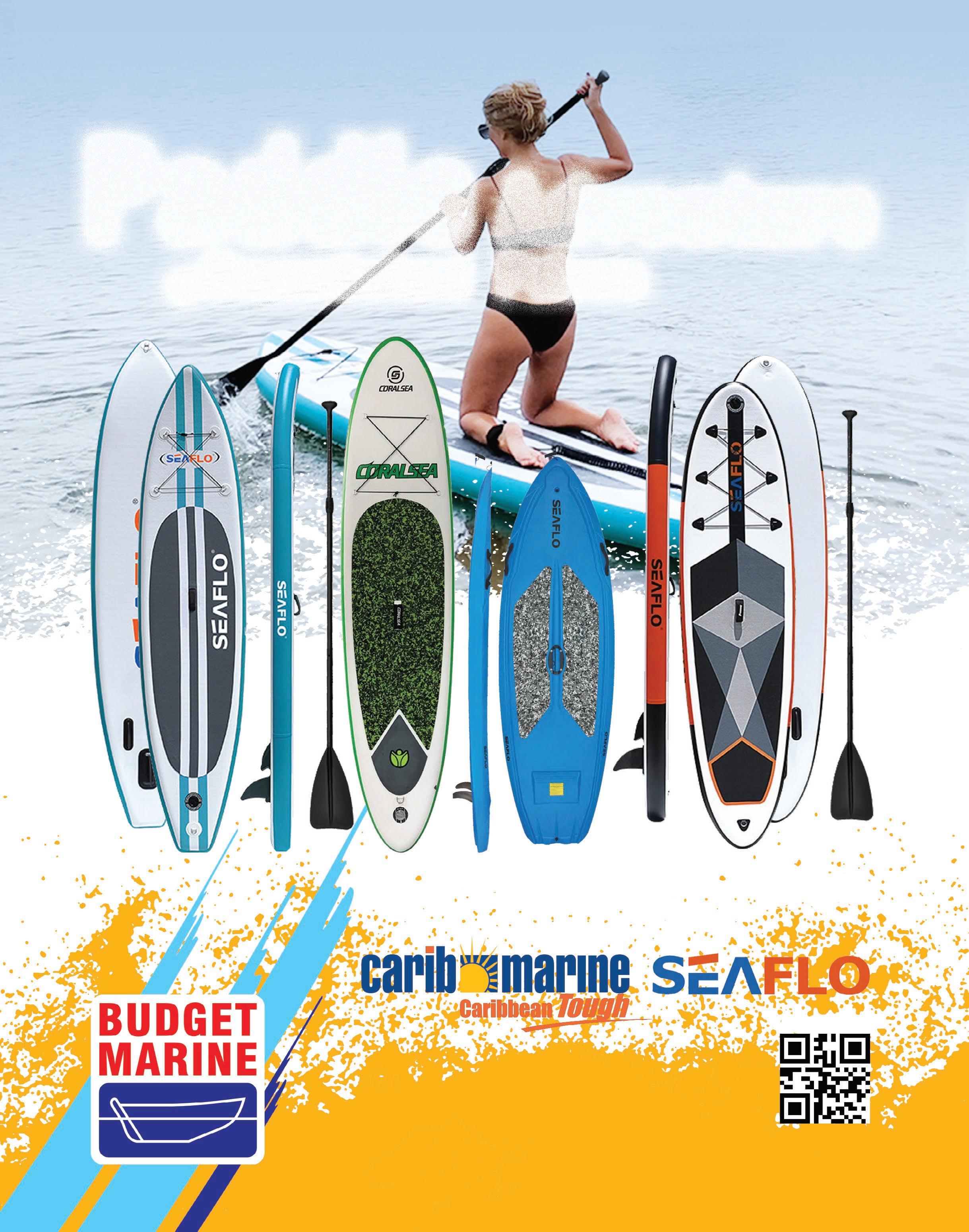

APRIL 20 23 CARIBBEAN COMPASS PAGE 2
ON THE COVER:
The teenaged crew of Whiplash, a Melges 24, strut their stuff off Antigua during Sailing Week. Photo by David Lyman. For more about the stakeholders committed to fostering a lifelong spirit of learning in young sailors, turn to page 20.
Readers Forum ..................4
Business Briefs ...................7
Channel 16...........................8
Regatta News....................10

Caribbean Eco-News......15

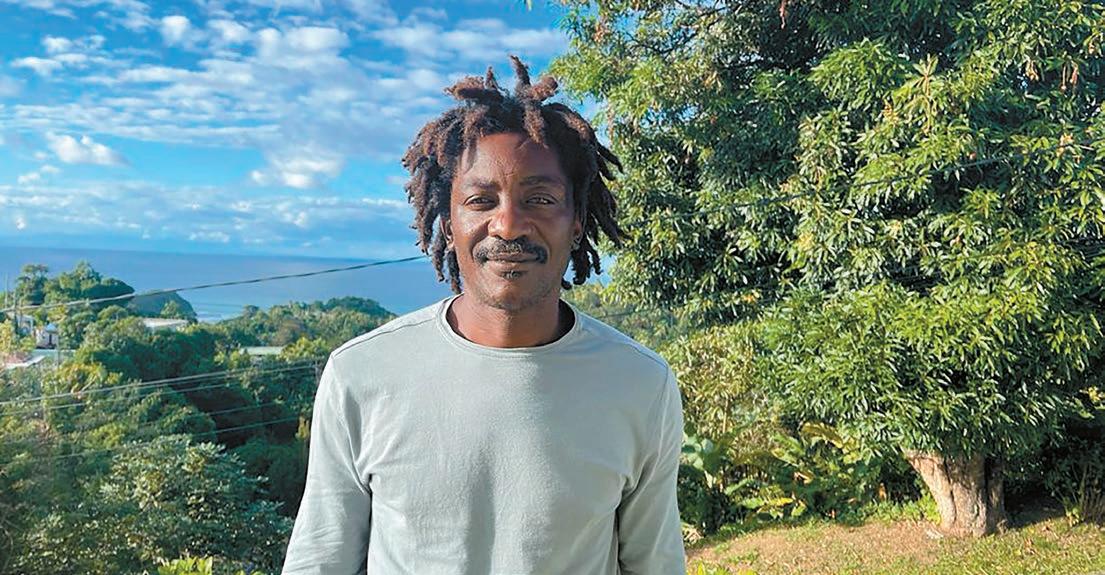
Caribbean Cruising........24 Book Review .....................31

Calendar of Events .........32
Meridian Passage...........32
The Night Sky ...................33
Caribbean Lives ..............34 Market Place ..................37
Classified Ads ..................39 Advertisers Index............39
Hey Readers, Get Caribbean Compass By Email!
In my work with marine national parks, I act as a bridge between trusted experts and specialists in the marine environmental field, natural resource managers, and the public. We consider the Caribbean Compass one of our partners and we thank you for helping us share credible science and news about important marine and coastal issues affecting sailors and island communities. Please follow us on social media!
Emma Doyle, MPA Connect Coordinator Gulf and Caribbean Fisheries Institute Gcfi.org
CARIBBEAN COMPASS
Caribbean Compass is published monthly by Compass Publishing LLC of Connecticut, USA. www.caribbeancompass.com
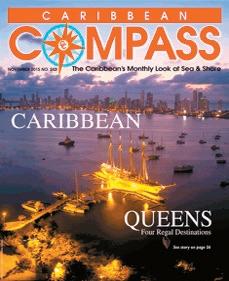

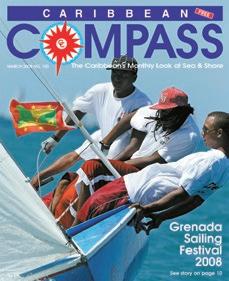


Publisher..................................Dan Merton dan@caribbeancompass.com
Publisher Emeritus..................Tom Hopman
Editor.........................................Elaine Lembo elaine@caribbeancompass.com
Editor Emeritus............................Sally Erdle
Executive Editor......................Tad Richards tad@caribbeancompass.com
Art, Design & Production.........Berry Creative abby@berrycreativellc.com
Advertising & Administration...Shellese Craigg shellese@caribbeancompass.com
Caribbean Compass welcomes submission of articles, news items and letters to the editor. See Writers’ Guidelines at www.caribbeancompass.com/guidelines.htm. Send submissions to editor@caribbeancompass.com


We support free speech! But the content of advertisements and articles are the sole responsibility of the advertiser or writer and Compass Publishing LLC accepts no responsibility for statements made therein. Articles and letters may be edited for length and clarity. We do not accept individual consumer complaints.
©2023 Compass Publishing LLC. All rights reserved. No reproduction, copy or transmission of this publication, except short excerpts for review purposes, may be made without written permission of Compass Publishing LLC.
ISSN 1605 - 1998
APRIL 20 23 CARIBBEAN COMPASS PAGE 3 A Roundup of the Caribbean Music Scene 5 Best of the Caribbean: Part 1 24 Ketchup Boat Guy Tells His Tale to the Compass 28 Anchoring Zone Changes at Tobago Cays 18 APRIL 2023 • ISSUE 325
at
See each new issue of the magazine
www.caribbeancompass.com
Visit our website at caribbeancompass.com or just scan the QR code BELOW and enter your email address — it’s as easy as that!
TO THE EDITOR
BOCA SPIRIT
The spirit of the Boca’s tooth Waits to lure sailors, that’s the truth, Her Siren call is loud and clear, And aimed at every sailor’s ear, ‘Mariner! Come forth, come forth, Point your bow out to the north, The sea is calm, the swells not high, (The lady has been known to lie!) Come sail to where the seas are blue And dolphins play and leap…come through Why do you linger? Come! Push on, And find the islands in the dawn.’
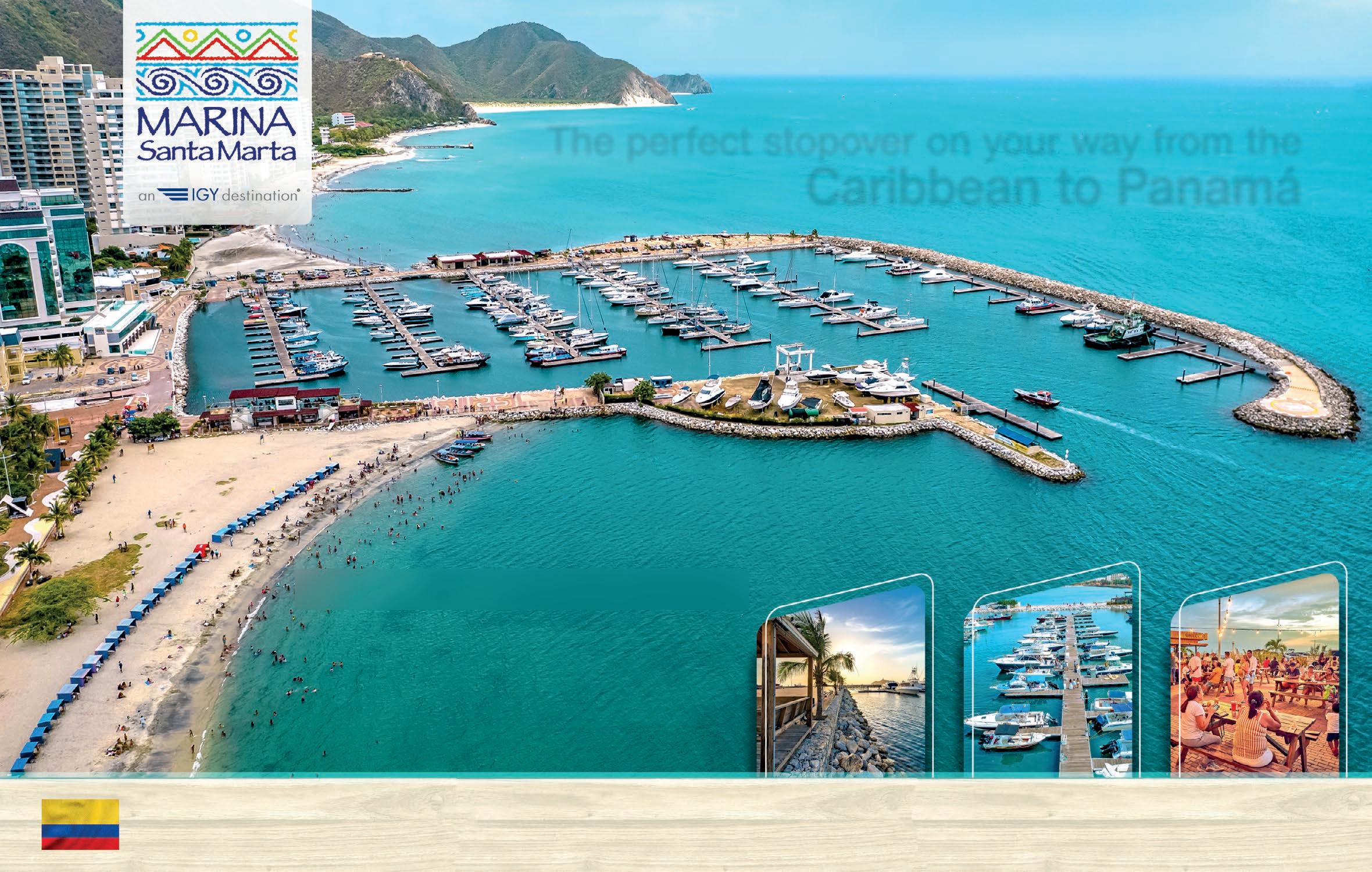
(Answer)
Island Poets
Starlink keeps on growing, as is evident from this photo taken from Jolly Harbour, Antigua, on the evening of February 27, 2023. The glow is from a Spacex Falcon 9 on its way to deploying a series of second generation Starlink satellites just after launching from Cape Canaveral, Florida. You just never know what you are going to see when you look up at the night sky.
Cheers!
David Frere S/Y Bakeapple
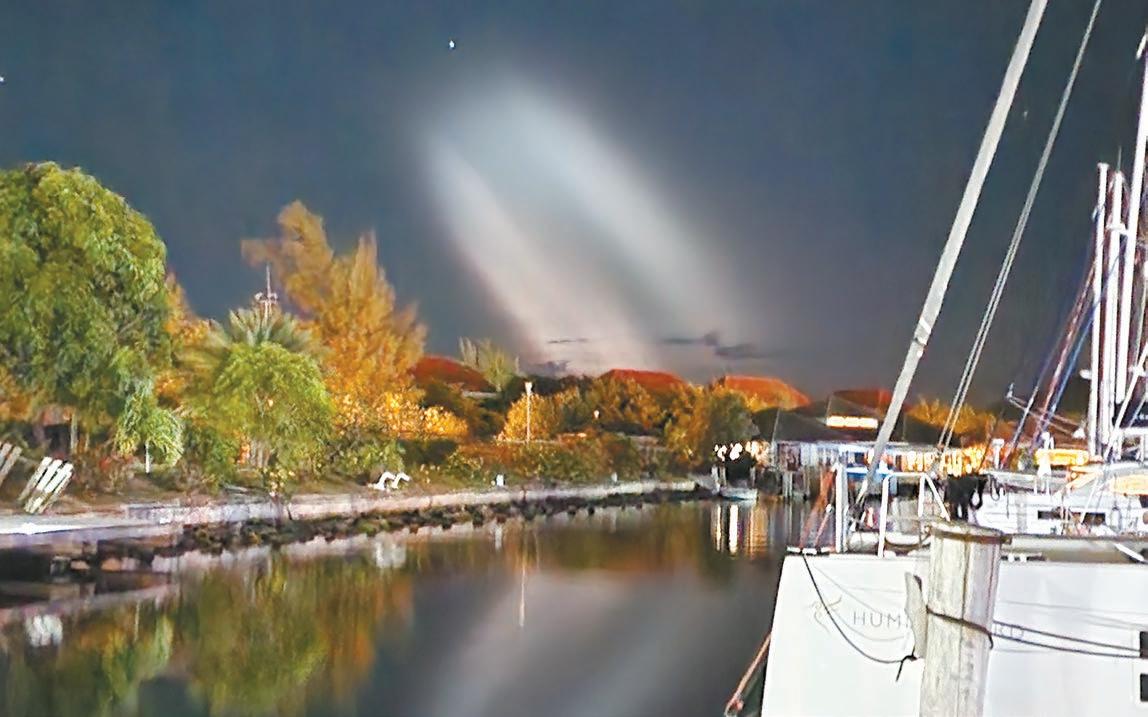
Your Siren call is loud and clear, But Spirit, not today I fear, Although your call is like a dart, Piercing my soul, my will, my heart, The mooring waits there in the bay I must go back, I cannot stray, I have landlubber things to do, So I must turn my back on you, But Boca Spirit, you must know My resistance is very low, My will is weak, my resolve feeble, I hear your song, and when I’m able To the north I’ll point the bow, And answer Spirit, but not now!
— Nan Hatch
APRIL 20 23 CARIBBEAN COMPASS PAGE 4 READERS FORUM
CARIBBEAN MUSIC FESTIVALS
by Tad Richards
Music is the heart and soul of the Caribbean, and it is the beating heart that has pumped its rhythms and melodies and song throughout the world: calypso, ska, rock steady, reggae, reggaeton, soca, zouk, merengue, salsa, dancehall, steel pan, bachata…and that’s just scratching the surface of this endless fountain of creativity that emanates from our region. And musicians from the Caribbean have put their own stamp on rock, jazz, blues, even electronic music.
And that fountain of creativity erupts all over the islands—you’re always within sailing distance of it. Here are some of the festivals that you can mark on your calendar for the next couple of months:
April 6-10: Afro-Cuban Dance Festival, Havana
Featuring concerts, demonstrations, classes and workshops on all styles of Afro-Cuban dance, at the Casa de Cultura de Centro Habana. Evening highlights include a rumba concert April 7, Malecón Flashmob April 7, and the festival’s climax — Fetecún Cubano, an authentic Cuban party in the heart of Havana, on April 10.
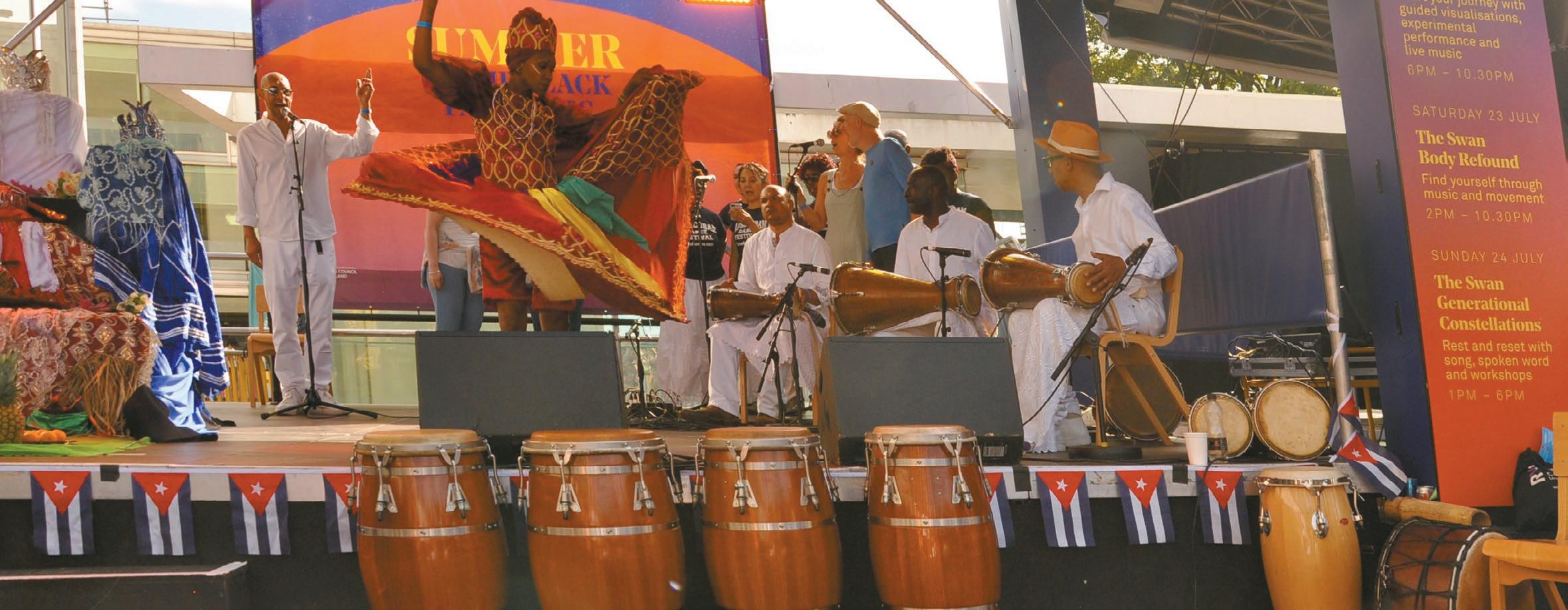
A complete schedule of events can be found at afrocubandancefestival.com.
April 7-8: International Blueseas Festival, Curaçao
The blues return to Curaçao’s historic Pietermaai district. Headliners include:
Billboard chart toppers, award winners, festival favorites Annika Chambers and Paul Deslauriers, have joined Texas and Canada in marriage and onstage as a compelling duet.
Diunna Greenleaf has performed at the Lugano Blues Festival and the Bern Jazz Festival in Switzerland, as the Cahors Blues Festival in France, and festivals throughout the US. She has opened for blues legends James Cotton, Keb Mo, Hubert Sumlin and others.
Harlem Lake, winners of the European Blues Challenge 2022, "love to blend raw 70s soul with contemporary blues rock and Americana."
Living Blues magazine hailed John Németh's debut album, "Magic Touch gives hope that the blues will survive." He has toured and recorded with Elvin Bishop.
The blues flourished on the beaches of Hawaii, as Ron Artis’ talent impressed such visiting musicians as Mick Fleetwood and Booker T. Jones, who invited him to play with them.
SaRon Crenshaw has opened for blues legends Robert Cray and B.B. King, and plays a Gibson “Lucille” model guitar signed by B.B. King himself.
Sugaray Rayford has received a Grammy Award nomination for Best Contemporary Blues Album, and won prizes at the Blues Music Awards.
Terrie Odabi has been described as "easily the most dynamic blues and soul woman to have emerged in the Bay Area since Etta James came out of San Francisco in the fifties.”
Grammy nominee Victor Wainwright's musical styles "include virtually every corner of the blues."
For more information check out curacaoblueseasfestival.com.
April 13-16 St. Barts Theater Festival
For something a little different, Théâtre de SaintBarthélémy presents La Ligne Rose. In French.
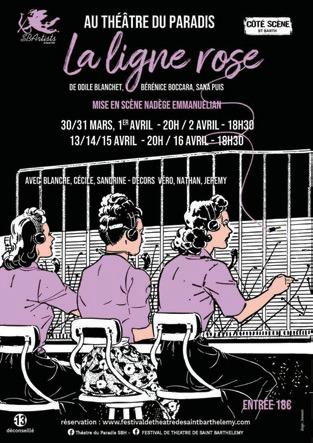
For more information go to festivaldetheatredesaintbarthelemy.com.
April 14 – May 3: St. Maarten Carnival
Three full weeks of music, dancing, parades and general merrymaking mean something for everyone. From the festival’s organizers:
“The program kicks off with strictly local themes in the first week of the festival. The Cultural Night continues to grow and will be back, so is the Pan Explosion spectacle featuring St. Maarten’s best pan players. A King & Queen of the Band Competition is on the schedule which Radjouki is adamant to bring back into Carnival, having won this competition multiple times himself in the past. The schedule also includes a Junior Calypso Competition.
“Complementing the local events will be seven international shows led by Carnival’s flagship event ‘Night of the Hit Makers,’ which will celebrate its 10th Anniversary in 2023. Two new promoters will host an R&B night and a Zouk concert, and popular brand name shows will also be back:
Caribbean Flag Fest, Bacchanal Sunday, Noche Latina, II Brothers Entertainment/One Love Reggae.”
You can find the full schedule at www.facebook.com/sxmcarnival/
April 20-24: Tobago Jazz Experience
Grammy Award winners from different generations have been announced to headline the Tobago Jazz Experience.
Boyz II Men released their first top five hit in 1991, and had their first Number One (and their first of four Grammys) the following year. They are on of only three acts to ever succeed themselves at Number One on the Billboard charts (you may have heard of the other two: Elvis Presley and the Beatles).
—Continued on next page
APRIL 20 23 CARIBBEAN COMPASS PAGE 5 SOUNDS+
PHOTO BY SIMON ATKINSON
Afro Cuban Dance Festival, Havana
Continued from previous page
Singer-rapper-guitarist Koffee was born a decade after Boyz II Men released their first record, and she took home a Grammy for Best Reggae Album with her first release, Rapture

Also featured are Everton Blender, Richie Spice, Theron Shaw, Tony Paul, Vaughnette Bigford, with more performers to be announced.
For further updates check tobagofestivalscommission.com















April 26-30: Vallenato Festival, Valledupar, Colombia
TAD RICHARDS
The best composers and performers of vallenato music, which includes merengue, puya, paseo, and son, come together at the Vallenato Legend Festival, the greatest popular folk culture festival in Colombia. Musicians from countries like Cuba, Aruba, Mexico, Venezuela, and the United States participate in the festival, which began in 1968.
The festival begins with the Piloneras parade, honoring the traditional custom of women who sang verses during household chores related to corn consumption. Competitions of all sorts highlight the festival. There are contests between composers, repentistas — those who improvise songs and music in the form of poetry — and piloneras, or dancers of the traditional Pilón dance (large wooden bowls that were used to grind corn). The main event of the contest is a competition between male and female accordion players of all ages to be recognized as King and Queen.
Vallenato music has reached so much popularity, that in 2015, the United Nations Educational, Scientific and Cultural Organization (UNESCO) declared it an Intangible Cultural Heritage of Humanity.
April 30: Jazz’n’Creole event, Dominica Performers to be announced. Check dominicafestivals.com/jazz-home for updates.
May 5-14: St. Lucia Jazz and Arts Festival Long regarded as the Caribbean’s premier music event, the St. Lucia festival
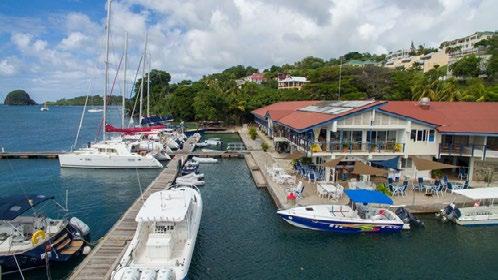
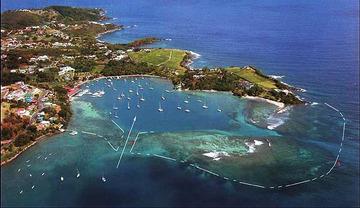

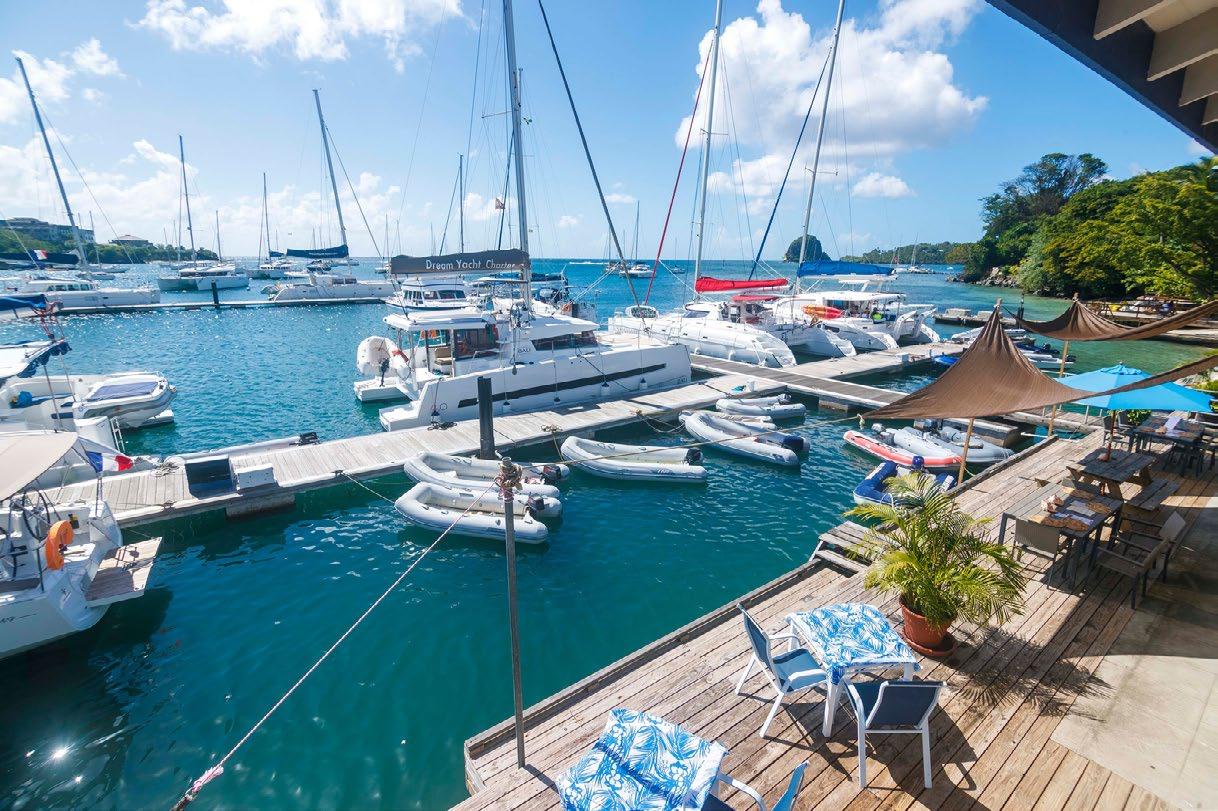
onstage” while Sting was performing his reggae-influenced hit, “Roxanne,” and the two discovered that they clicked musically, professionally and personally.

Beyond Sting and Shaggy, who perform Sunday, May 14, the Pigeon Island National Park stage will be packed with international stars. Here’s the announced schedule.
Friday, May 5 - Kick-Off: Caribbean genres with some of the biggest names from the region headlined by reggae superstar Shenseea, Jamaican-born Interscope recording artist whose work with Kanye West got her a Grammy nomination, and Kes the Band, Trinidadians known for their unique blend of soulful vocals, calypso inspired melodies, rock riffs and island beats, with hints of reggae.
May 6-9 - Entertainment & Community Jazz: Explore authentic Saint Lucian culture and people through an eclectic mix of local events.
Wednesday, May 10 - Kingdom Gospel Night: A riveting, inspiring showcase of praise and worship with some of the best names in Gospel, to be announced.
Thursday, May 11 - Pure Jazz: Grammy winner, pianist, and composer Gustavo Casenave and special tribute to Saint Lucia's Luther François, the godfather of Saint Lucia jazz. Also featured, Ronald “Boo” Hinkson, whose jazz-soca guitar stylings, have won raves from jazz legend George Benson.
Friday, May 12 - Caribbean Fusion: Starring Buju Banton, whose album, Mr. Mention, is the best selling album in Jamaican history. Trinidadian soca stars Bunji Garlin and Fay Ann Lyons are also featured.
Saturday, May 13 - World Beats: Journey the globe with the best of AfroPop and hip-hop. Rema, the Nigerian rapper whose “Dumebi” was an international smash, caught the attention of Barack Obama, who added his “Iron Man” to his personal summer playlist, and young rapper Oxlade, another Nigerian, whose song “Away” caught the attention of Rolling Stone, making the magazine’s list of the best songs of 2020. Nigerian Afro-pop is well represented by model-turned-singer Ayra Starr, performing with fellow Nigerian Ckay, the first African artist to hit 20
for over four decades, and he’s not slowing down. His partnership with Shaggy began, notoriously, when the Jamaican-born singer “wandered
23 CARIBBEAN COMPASS PAGE 6
Fuel Dock 24 hour Security Port of Entry Customs & Immigration Office - 9am to 6pm Electricity 110V/220v & Water Complimentary Wifi Laundry Service Supermarket & Boutique Cafe Soleil & Flowt Beach Bar The Loft Restaurant and Bar Indigo Dive Shop Swimming Pool Beautifully Designed Hotel Rooms Marina: VHF 16 or 68 Email: info@bluelagoonsvg.com 784.458.4308 Call:
Reggae superstar Koffee headlines the Tobago Jazz Experience
DIGITAL
DIGITAL PAINTING BY TAD RICHARDS
Sting and Shaggy headline the St. Lucia Jazz and Arts Festival
PAINTING BY
Fiber Tec Adds Sandblasting
BUSINESS BRIEFS

Fiber Tec Yacht Services has added sandblasting to its full service maintenance and repairs. Sandblasting is a safe, cost effective way of having a boat’s surface prepared. It works for all hulls.
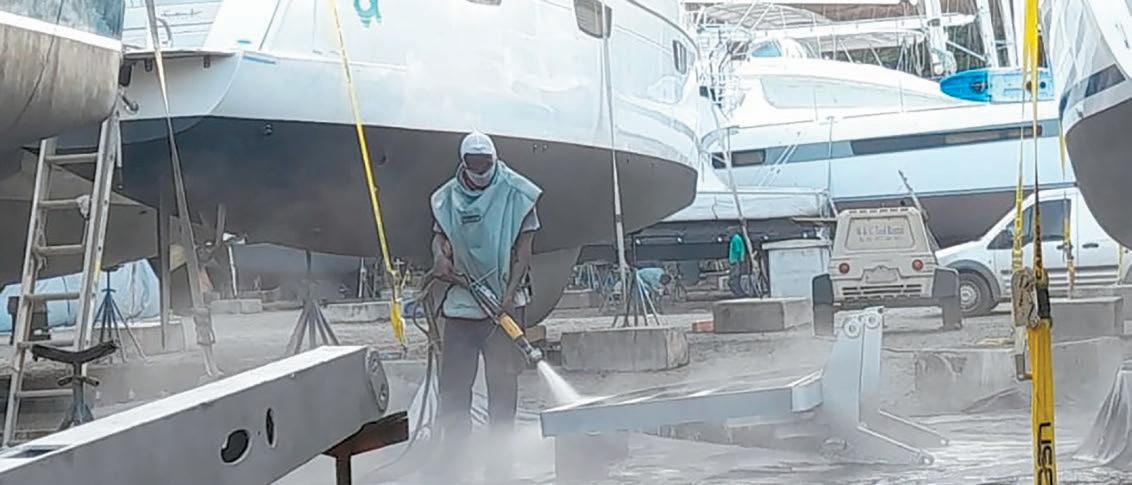
mission until 1987, when a reorganized Elco, building on then-new solidstate motor controller technology, reentered the recreational market. In 2009, the company expanded into outboard motors and focused on powering the emerging electric-boat-propulsion market.

Today, Elco offers a full range of safe and reliable electric inboard and outboard motor systems with power up to 200 hp. Compact and virtually maintenance-free, recreational boaters and commercial operators alike appreciate the lack of warm-up time, instant throttle response, impressive torque and a quiet, exhaust-free ride.
Elco propulsion solutions power a diverse range of modern applications throughout the world. In Australia, Elco inboard motors provide sustainable power cruising aboard luxury catamarans where all propulsion and house electrical needs come entirely from batteries charged by solar arrays and backup hybrid diesel power.
Fiber Tec has been located in Grenada’s Clarkes Court Boatyard since 2019. Services include stripping & application of antifoul, sandblasting antifoul & gelcoat, stripping & application of coppercoat, fiberglass modifications & repairs, hull gelcoat cleaning & polishing. The company also offers custom yacht graphics, boot stripe painting, plus hatch replacement and repairs.
For information visit fibertecgrenada.com. Email info@fibertecgrenada. com or call 1 (473) 416 5574 to arrange a free consultation.
Elco Celebrates 130 Years
Elco Motor Yachts, which began operation as the Electric Launch Company and pioneered its first product at the 1893 Chicago World's Fair, celebrated its 130th anniversary this year at the Chicago Boat Show. The company's first battery-driven boats counted Henry Ford, Thomas Edison and John Jacob Astor among customers.
Over the years, the company's innovations have included the battery-powered submarines that made possible the US Navy's submarine fleet, and John F. Kennedy's famed PT-109. Although recreational yachts were the Electric Launch Company's first product, defense production came to dominate the company's
"We're proud to continue Elco's 130-year tradition of innovation," said Steve Lamando, Elco president. "With a global shift towards sustainable alternatives to combustion engines, we are well positioned to continue trailblazing electric marine propulsion with new products and technologies." 130th anniversary event plans are underway.
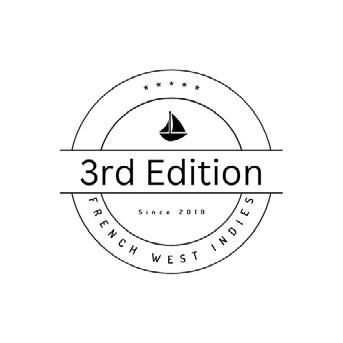
For information visit the Elco Motor Yachts website at www.elcomotoryachts.com.
Food Delivery App
Appel à Tous is the first app that allows sailors in the Caribbean to order daily groceries — from fresh bread and local fruit to water and sparkling wine — with delivery directly to the boat. Whether the yacht is moored at the pier or away from shore at a buoy, Appel à Tous will deliver all the galley essentials to sailors, within hours of making a payment on the app. The initial launch is in Martinique, but Caribbeanwide expansion is planned.
"In simple terms, our app allows sailors to order all the products they need, with express delivery to any boat — whether moored at the pier or at the buoy. We have met with a very warm welcome among sailors in Martinique," says founder Zoe Adamowicz. Find out more at appelatous.fr or ww.instagram.com/appelatous.provisioning

Budget Marine Opens in Colombia
Budget Marine Cartagena invites all sailing enthusiasts to come and visit its new store on Avenida Pedro de Heredia, where it provides customers with top marine products and outstanding service. Staff can communicate with customers in fluent Spanish and English.


Caribbean Airlines to Increase Service to Dominica
Caribbean Airlines will increase its service from Trinidad to Dominica beginning April 7, 2023.
Travelers can fly from Port of Spain, Trinidad, to Dominica on Thursdays and Fridays, and depart from Dominica on Mondays. Each flight has 68 seats. Caribbean also offers flights from New York (JFK) to Dominica. A flight leaving JFK at 7:30 a.m. will arrive in Dominica by 6:45 p.m.
APRIL 20 23 CARIBBEAN COMPASS PAGE 7
Sandblasting at Fiber Tec
Top: Electric Launch Company debuted new product at the 1893 Chicago World’s Fair.
Bottom: An Elco outboard today.
PHOTO COURTESY FIBER TEC
PHOTO COURTESY ELCO
Channel
appears in the March 2023 issue of Caribbean Compass
This is the first Compass story to win a BWI award, and we could not be prouder of David, whose essays and photographs have been a frequent feature of our magazine, including in this issue.
Award Winners Announced
Here are the 2022 honors announced by the Royal British Virgin Islands Yacht Club.

Adult Awards:
Best Club Helm - Chris Haycraft
The most consistent competitor in club races, Chris finished first in the Lowell Wheatley Anegada Pursuit Race, Nanny Cay Round Tortola Race and wrapped up the year with a win in the Golden Hind Chandlery Commodore’s Race.
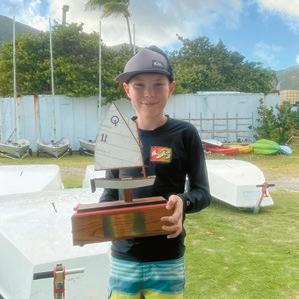
Best International Competitor - Thad Lettsome
Thad Lettsome continues to compete on the circuit of the International Laser Class Association, also representing Tulane University. Results in 2022 include 29th at the ILCA7 U21 Worlds, 18th at the ILCA7 North Americans and 11th at the Snipe Junior Worlds.
Most Improved Sailor - Marentia de Villiers
Em will take every possible opportunity to get out sailing and always makes herself available to help and encourage new sailors. She has a thirst for knowledge and is awarded the most improved sailor in recognition of her progress in the Laser.
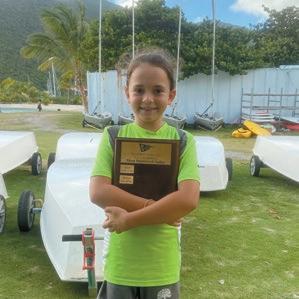
Ros Griffiths Award for Outstanding ServiceBob Phillips
Historic Christiansted and its fort are part of the National Heritage area on St. Croix, and open for self-guided tours.

St. Croix Designated National Heritage Area
St. Croix in the United States Virgin Islands has been officially designated a National Heritage Area, formally recognizing the importance of the island’s history, culture and unique landscapes to the history and heritage of the United States. St. Croix’s art, music, dance, food, folklore and culture have been shaped by centuries of people who have lived here and the bounty of natural resources available. St. Croix has borne witness to pre-historic indigenous peoples, the landing of Christopher Columbus followed by European settlers and colonization, slavery and emancipation, and, more recently, the migration and merging of many global cultures. The island features sub-tropical rainforest, fertile valleys, coastal plains, beaches, desert-like shrublands, rocky hills, and a diverse marine environment rich with coral reefs. Being named a National Heritage Area will not only encourage preservation and appreciation of this history and heritage, but will raise St. Croix’s profile as a destination for cultural tourism.
David Lyman Compass Story is Prize Winner
“The Nicholson Sisters of English Harbour,” by David Lyman, which appeared in the March 2022 issue of Caribbean Compass, was this year’s second prize winner in the Boating Profiles category of the Boating Writers International (BWI) annual writing competition. The awards, now in their 30th year, are among the most prestigious in the field of boating journalism. Along with a cash award, each winner received a recognition plaque noting their "excellence in creating compelling content about boating through entertaining, educational and inspiring journalism.
This award was presented to Bob Phillips in recognition of the many years of support he has shown to the club.
Youth Awards:
Most Improved Sailor - Piper Bailey
Piper Bailey is now confidently in command of her Optimist! Piper is always keen to learn, attentive and focused. Congratulations, Piper!
Sportsmanship Award - Jake Richardson
Jake receives the Sportsmanship award in recognition of his consideration and kindness to others. One of the keenest sailors in the program, his enthusiasm is infectious. Congratulations, Jake!
Lin Pardey Offers Storytelling for Sailors Seminar

Lin Pardey, award-winning author of a number of books, alone and with her late husband, Larry, offers the Storytelling for Sailors Digital Seminar to help writers craft and find outlets for their sailing stories. The seminar includes an all-day Cruisers University seminar, video interviews with writers, videographers, and media marketing experts.
The seminars include:
WRITING - Learn how to tell your story in a book, a series of articles, or a blog.
Lin's guests include:
• Herb McCormick — editor at large, Cruising World magazine. Editing sailing magazine articles.
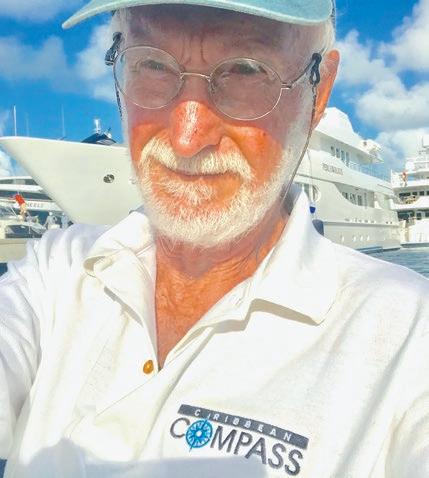
• Cap'n Fatty Goodlander — Author, Circumnavigator. Why selfpublishing is his first choice.
• John Kretschmer (SSCA member) — Accomplished sailor and writer. Traditional book publishing stories that teach.
• Michelle Elvy — Prize-winning editor, author. Choosing and working with a book editor.
VIDEO - Potential financial returns and possible pitfalls of combining your story with your cruising life. Upsides and costs are clearly laid out by experienced video experts and YouTubers.

David’s award winning story and his embrace of Compass attire
—Continued on next page
APRIL 20 23 CARIBBEAN COMPASS PAGE 8
McCormick, for his story “A Family Matter” in Cruising World McCormick’s special report on the Caribbean Multihull Challenge
16 C M Y K C M Y K MARCH 2022 CARIBBEAN COMPASS PAGE 20 MARCH 2022 CARIBBEAN COMPASS PAGE 21 ANTIGUA & BARBUDA Jolly Harbour CURACAO Zeilmakerij Harms Kapiteinsweg #4 GRENADA True Blue St George MARTINIQUE 30 Bld Allegre ST LUCIA Rodney Bay Sails Rodney Bay TRINIDAD & TOBAGO Chaguaramas Built by sailmakers dedicated to building the finest, most durable and technologically advanced sails possible. BARBADOS Doyle Offshore Sails, Ltd Six Crossroads. St Philip Tel: (246) 423 4600 Fu Do k 24 h S P E g - p E c c t 11 V 220v & W e Comp me t W L d y S p k q Ca e So e & F ow Bea h Ba Th L t Re au a t an Ba Ma na VHF 16 or 68 Ema : n o@b ue agoonsvg com 784 458 4308 Ca
by David H. Lyman My sailing buddy Larry and pulled into Falmouth Harbour two years ago and anchored off Pigeon Beach. We had just completed an offshore voyage from Maine to Antigua. We were hungry to get ashore. had an assignment from Caribbean Compass to cover the Antigua Charter Yacht Show starting in a few weeks and needed base ashore. Larry, who knows the island and everyone there, knew just the place. “Pineapple House!” he shouted as we launched the dinghy. “Wait ’til you meet Libby Nicholson. She’s from the family that started the charter industry in the Caribbean.” Larry’s 54-foot sloop, is one of the charter boats Nicholson Yacht Charters represents. We jumped into the RIB and sped to the dinghy dock at the Seabreeze Café next to the yacht club. Five minutes later we were climbing the stone steps to Pineapple House. “This is where all the yacht crews hang out,” Larry told me, “when not on charter or racing.” A brown wooden gate with white pineapple nailed in the middle swung open and there saw West Indian cottage colony, ten individual cottages and the Great House, scattered up the hillside that overlooks English and Falmouth Harbours. The Antigua Yacht Club and its docks full of mega-yachts were just below. “Great view,” told Larry. Then Libby hove in sight, flying down the cascading stone stairs to embrace the two of us with hug that would have broken the backs of lesser men. Libby, after 60 years of living on and off this island, is still one of the major characters in English Harbour society. She’s an energetic woman of indeterminate age with ready smile and an artist’s flair. An accomplished silversmith, architect and interior designer, Libby makes her own statement with silver bracelets dangling from both wrists and colorful fabrics draped over her statuesque form, flowing as she moves. “Let me warn you,” Larry whispered. “This may be a B&B, but the second B is not for breakfast, it’s for booze.” We were just in time for Libby’s early evening soirée. Libby went on mixing up few gallons of rum punch and chatting away, full of questions of our delivery. Most evenings, Libby holds court on the veranda of the Great House. “It’s tradition my grandfather, the Commander, started over 60 years ago,” Libby told us, pouring ample amounts of the local Cavalier rum into the mix. Guests, locals, yacht captains and crews, even a stray journalist, gather here to swap stories, tell lies and share observations of life in the tropics. The seating area was soon packed, people reclining on colorful cushions, standing in open doorways, sitting on the porch railing or on someone’s lap. It’s here you hear about narrow escape from the carabiniere in an Italian port, a particular captain who had to marry the daughter of his yacht’s owner, the lavish lifestyle of charter guests, races and romances won and lost. It’s here yacht crews come to get off the boat, take shower, and sleep in real bed. I’d walked into writer’s paradise, full of characters and stories. The all-female crew from Maiden of Whitbread Round the World Race fame, had just arrived in Antigua and all eight had moved into Pineapple House. Bedraggled from 10,000-mile voyage across the Pacific via the Panama Canal, Pineapple House offered them the first showers and horizontal beds they’d seen in months. “It’s not all yacht crews,” Libby added. “We have honeymooners, travelers, couples, families looking for an affordable vacation.” At Pineapple House you can rent private single-room cottage, or queen-size bed tucked into an alcove on the front porch of the main house, or a single bed in the crews’ quarters. “It’s co-ed,” Libby explained, then added with giggle, “Yacht crews are used to communal living.” The three Nicholson sisters, Dana, Libby and Shelby, were born on Antigua, each barely year apart. Their grandparents, “the Commander” and his wife Emmie, with two sons, Rodney and Desmond, had stopped here in 1950 on their way from Ireland to Australia on the schooner Mollihawk “In 1940, Grandpa found the yacht sitting on mud bank in Kent while tasked with assembling a fleet of private boats to evacuate the troops trapped on the beach at Dunkirk,” Shelby told me. “After the war he went back and bought the schooner, as much for its silverware, crockery and bedding as the boat itself. wood schooner, built in 1903. After making her ready for a long sea voyage, the family, which included our dad, Rodney, and uncle Desmond, left Ireland in 1949 to sail halfway around the world to start new life. They got halfway. “The family stopped in Antigua, and tied up at Nelson’s Dockyard in English Harbour. The schooner needed repair. No sooner had they arrived than Amber, the calico cat, leapt off the boom and swam ashore. She was in heat, got pregnant and had kittens… that’s when Granny Emmie whispered to Grandpa, ‘Darling, think we’re HOME!’” Nelson’s Dockyard had been abandoned for at least hundred years, roofs falling in, windows missing, shutters hanging off. In the 1700s and into the mid-1800s this had been an important British Naval Base, but was now forgotten. The locals feared “jumbies” lived there, the spirits of dead sailors. The family fixed up the old Paymaster’s Quarters While establishing home base at the old Powder Magazine at the Dockyard, the Commander was approached by wealthy guests at the Mill Reef Club few miles to the east. “That’s mighty fine schooner. Mind taking us for sail?” That started the yacht charter business in the West Indies in 1950. Within few years there were dozen private yachts, most skippered by British captains who took charter parties on a week’s explorations to the islands to the south. Antigua is ideally located in the island chain where the tradewinds will blow you south then north on a beam reach both ways. This opened up the islands of Guadeloupe, Dominica, Martinique, St. Lucia, St. Vincent & Grenadines for exploration. Nicholson & Son Yacht Charters Inc. grew into a thriving business, and is today major name in yacht chartering, with offices in Antigua, Newport, Rhode Island, and Cambridge, Massachusetts, and an office in Blue Hill, Maine, where Shelby works when not in Antigua. In 1954 the schooner Yankee skippered by Irving Johnson, sailed into English Harbour on its ’round the world voyage. Onboard was recent Smith College graduate, Julie Pyle, from respectable (and wealthy) Connecticut family. During that brief stop Julie met Rodney, and something must have clicked, for when her voyage ended a year later she flew back to English Harbour. Julie and Rodney eventually married, and she became wrapped up in the family’s charter operation. “Mother was an excellent writer,” Shelby said. “The letters she wrote to clients showed them in words what their upcoming charter was going to offer. She wrote all the brochure copy. PanAm distributed our brochures to travel agents all over the country.” Then the girls came, one after the other: Dana, Libby and Shelby. Growing up in English Harbour was like “never-never-land,” according to Libby. “We were in the water more than out of it. There were vacant beaches, hills to climb, yachts to sail, fish to catch, games to play. The Dockyard was our playground, with all those buildings either falling down or under reconstruction.” Restoration of the Dockyard began in 1951, with the Commander in charge. The coral stone buildings, the sheds, and the Admiral’s House were brought back to life, providing a stage for the three young girls and their imaginations. The girls were not alone. A growing community of English, Canadian and American expats had moved into English Harbour, including few families of the charter captains. “So, there was no shortage of children our age to play with. They included Michael and Peter Endicott from Mill Reef, Cary Byerley, whose father ran the 72-foot schooner Jim and our cousins, the other Nicholsons, Sarah, Chris, Nancy and Celia,” Shelby wrote in a draft of her memoir. “We had wonderful times playing on the hillsides, on the beaches and in the Dockyard.” In September of 1964 the sisters and their pals were off to Sunnyside School in St. John’s, the island’s capitol. This was the first school to be integrated on the island. Shelby wrote, “Given the tumult surrounding desegregation in the United States in the 1960s, our headmaster, Mrs. Wilson, had integrated Sunnyside School immediately and without question that summer, and that was that. There were no riots, no hair pulling, no angry mothers or fathers or police or undue embarrassment. Life went on as normal.” “Life was carefree,” Libby added. “Grandpa had taken over the old Powder Magazine and turned it into home. The floors were teak like the deck of a yacht.” The Commander, Vernon Edward Barling Nicholson OBE, being half Irish and half Australian, was natural raconteur and loved to entertain. “On Sunday afternoons he held a party for the skippers and crew of the charter fleet, and anyone else who happened to be in town.” The Powder Magazine is still there, across Ordnance Cove from the Admiral’s Inn, but it’s no longer the Nicholsons’. It’s now called Boom, an upscale restaurant, but that’s another story. By the mid-’70s, Rodney had moved ashore and was running the charter office in Antigua with Julie. Desmond, the more studious brother, turned his attention to the island’s history and anthropology, eventually writing several books on Antigua’s past. Rodney and Julie had house with few walls, built on hill overlooking the Dockyard, a great space for playing. Desmond and his family built home on the opposite hill. Julie had been brought up in cosmopolitan Connecticut, and had degree in philosophy. She wanted more education for her daughters than Antigua could provide at the time, so when Libby was 13, she packed all three of them off to separate private schools in New England. For Julie herself, life in Antigua was just a bit too parochial. By the mid-’60s, Nicholson and Son was thriving business, but communication with clients was difficult. Mail took weeks. Phone calls were expensive and reception sketchy. Julie, who had by now become an indispensable part of the charter game, told Rodney she was returning to the States to set up a proper office in Massachusetts, and be closer to clients and her family there. “I always thought our parents were more like brother and sister than husband and wife,” Libby confided. “But they continued to work well together: Julie in the booking office in Cambridge, where communications were better, Rodney running operations in English Harbour, where the yachts were.” After private school, Dana went to UMass in Amherst, then transferred to Smith, her mom’s alma mater. “She’s the restless one,” Shelby added. “She’s a fine painter, but has always been drawn to yachts and adventure. She’s off right now on another transatlantic yacht delivery. She loves racing yachts.” Libby was off crewing on yachts in her late teens, exploring the Mediterranean and the rest of the Caribbean. Grandmother Pyle, on their mom’s side, was concerned for Libby’s future. She insisted Libby acquire skills that would ensure she could earn her own way. “She sent me off to Katharine Gibbs School in Boston for a year to learn typing and office management.” With new skills, her experience and connections in yachting and chartering, Libby landed job in New York City at the renowned yacht design firm Sparkman and Stephens. One day, as Libby tells it, “A tall, handsome Canadian yacht captain came through the door to my office. His name was Fred Long, from British Columbia. He came to discuss a new boat for his father, wealthy industrialist. “I showed him photographs and plans for Battle Cry 47-foot cold-molded racing machine designed by Sparkman and Stephens. How loved that boat. Well, they bought the boat and immediately changed her name to I, of course came along with the deal. For three years, Fred and sailed her all over the Pacific, winning race after race. knew sail trim and racing maneuvers, but Fred was a brilliant tactician and helmsman. We made a great team. He was my ‘super hero.’ I’d become member of the Long family… well not officially yet. “I was in no hurry to settle down. was in my mid-twenties. Life was too exciting. was still sailing across the Atlantic on deliveries. While in the Canary Islands called Fred, who was in Vancouver, just to tell him where was. The connection was poor, and wasn’t sure what he said, something about a mirage. asked him to repeat it, and he said ‘Will you marry me?’ Of course said yes. was 30 then.” Two years later, Christie, their daughter, arrived, then Russell, their son. Libby settled Her kids grown, Libby moved back to Antigua in 2000, to lead “simpler life.” doubted that, watching her juggle two phones, staff of three, guests, and plans for renovating properties in Maine and British Columbia. Soon after arriving back home, she bought the hillside up behind the yacht club. She had few local fellows knock together a typical West Indian cottage. “Nothing fancy, mind you. Just two-by-fours, boards and a corrugated tin roof. Leave the windows open. No doors in the doorways. want the sea breeze to blow through.” That spring, while she was getting ready to head up to Maine, crewmember off yacht asked if he could rent her cottage. She said yes. When she returned in the fall she had another cottage built, then another. There are now ten, each different, each decorated in what Libby calls West Indian chic. Colorful fabrics replace doors, shutters protect what would be called windows welcoming the tradewind breeze, and the décor is mainly seashells. Some cottages have modest kitchens. Most have hot water and all have veranda overlooking the anchorage. There is still the “Crews Quarters” and half dozen four-poster beds with billowing white canopies are tucked into alcoves here and there, all very informal. could move in. I’d spend the season, write stories of sailing, Caribbean characters, and island life. (In fact, think will.) After private school, Shelby joined her mother in the Cambridge office, matching clients with yachts and crews. She has now joined Libby in Antigua to help out, while Dana is still away, racing through life. The Nicholson sisters are holding on to that romantic life of fast yachts, rum punch and boisterous crews ready to spin a yarn. This page, clockwise from top: Pineapple House’s porch provides views of the yacht club docks — and places to sleep. Dana, Libby and Shelby on their bicycles in the 1960s. ‘We had wonderful times playing in the Dockyard… life was carefree.’ Libby, Julie, Dana, and Shelby on family cruise through the Grenadines aboard Left: Once abandoned, then the Nicholson girls’ playground, Nelson’s Dockyard is now a UNESCO World Heritage Site. Below: A rum-punch party: ‘I’d walked into a writer’s paradise, full of characters and stories.’
The Nicholson Sisters of English Harbour
Piper Bailey
Lin Pardey’s digital seminar is aimed at the new generation of sailing writers.
PHOTO COURTESY ROYAL BVI YACHT CLUB PHOTO COURTESY LIN PARDEY
PHOTO
Jake Richardson
PHOTO COURTESY DAVID LYMAN
BY NICK HEINEMANN
Continued from previous page
Lin's guests include:
• Paul & Sheryl Shard — Distant Shores Sailing Adventure TV Series.TV Broadcast, YouTube, Video Tips.

• Tory Salvia (SSCA member), S/V Sparkle Plenty — TheSailingChannel.tv. Video Editing, Cloud Storage, Long-Form Video Distribution.
• Eric Epstein — Highwater Media. Tricks with drones to make your videos stand out.
SPECIAL GUEST SPEAKERS
• Desiree and Jordan, S/V Atticus — YouTube Sailing Atticus. Success tips for YouTubers.
• Brett and Jade Evans, S/V Evans — YouTube Expedition Evans. Starting your YouTube adventure.
MARKETING
Creating a sailing brand that sticks is the key to making your articles, blog, or YouTube channel successful. Our branding and social media marketing crew will explain how you can use storytelling to create a brand people care about. Lin's guests include:

• Behan Gifford, S/V Totem — Author, circumnavigator. Making blogging work for you and your family.
• Erin Carey, S/V Roam — Roam Generation PR. Creating your brand.
• Marissa Neely, S/V Avocet — Fairwinds Media. Using media marketing consistently and successfully.

Guest authors and editors cover book creation and publishing, including the realities of self-publishing vs traditional publishing. Media experts discuss online media production, distribution, and how to keep viewers watching your YouTube channel. Lin and her guests give you a clear picture of what returns you can expect, along with the pitfalls and the practicalities of adding writing, blogging, photography and video making to your cruising life. Lin interviews several other cruisers who are successfully earning cruising funds with blogs, books, YouTube channels and podcasts. These video discussions add in-depth information on these specialized fields.
You can see an introductory video and sign up for the course at vimeo.com/ondemand/storytellingforsailors
Antigua and Barbuda Art Week
April 16-22 is Antigua and Barbuda Art Week on the twin islands, featuring art displays, live music, dance, and spoken word events, and interactive painting sessions with featured artists. The theme of the event, hosted by the Antigua and Barbuda Tourism Authority, is “Culture in Colour.”
Features of the inaugural festival include:
The ABAW Schools’ Art Competition for students in local primary and secondary schools to get involved in Antigua and Barbuda Art Week. Works will be judged by a panel, and select artists featured during the festival. The entry deadline for the competition is April 7.
ABAW Opening Night and Launch of Art Exhibition, opening April 16 at Gunpowder House, English Harbour, and running for a week. The exhibition will feature artists in Antigua and Barbuda, including leading contemporary artist Heather Doram MFA GCM.
Self-guided Art Walks and Studio Tours: During the week, visitors can find the artists at their studios and experience them creating art in their space. Various restaurants around Antigua and Barbuda also exhibit artists’ work. Movies under the Stars: April 19 at Garrot Blacks, English Harbour. Enjoy films created by Antigua and Barbuda film producers.
ABAW Artist Showcase, on April 21, 2023, will spotlight new and emerging musicians and spoken word artists at Ana’s on the Beach Restaurant and Art Gallery.
ABAW Paint, Sip & Eat: Antigua and Barbuda Art Week concludes on April 22 with an immersive sip and paint art experience. Attendees can meet with Antigua and Barbuda’s top artists, and create their own art guided by artist Gerron Farquharson at Greencastle Ranch.
Follow the Antigua and Barbuda Tourism social media pages on Facebook and Instagram and the Antigua and Barbuda website visitantiguabarbuda.com for updates on Antigua and Barbuda Art Week.
APRIL 20 23 CARIBBEAN COMPASS PAGE 9
Cool Runnings III, Gold Coast 65 Photo by: Alec Drayton
REGATTA NEWS
Globe 40 Leg Seven Winner in Grenada
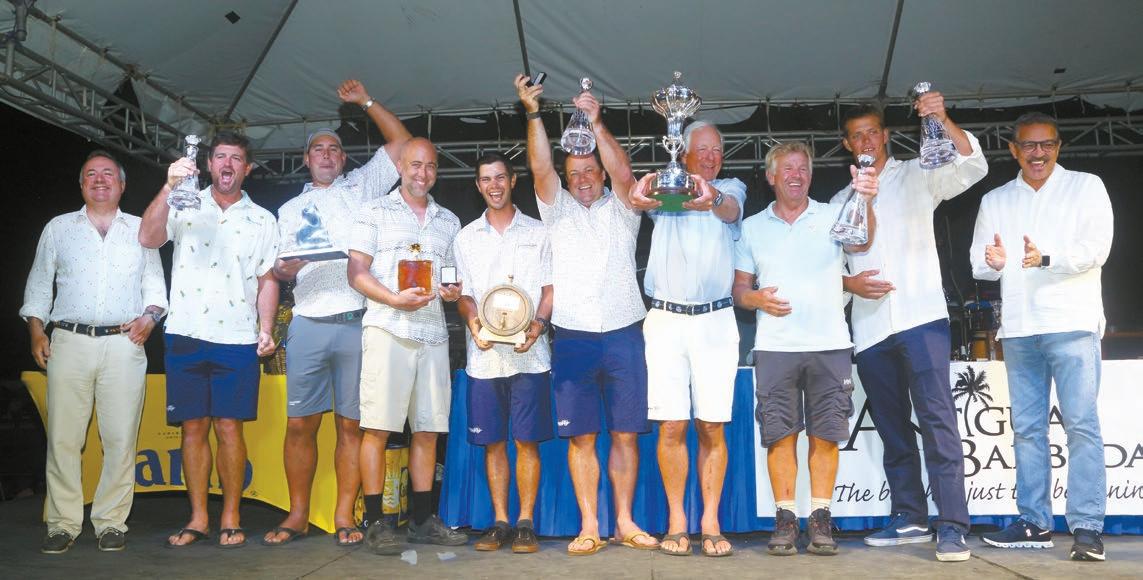


On February 13 at 2209 local time, the Canadian crew of Whiskey Jack, with skipper Mélodie Schaffer, crossed the finish line of leg seven of the GLOBE 40 at the entrance to the port of St. Georges in Grenada. They covered this 2,123-mile leg, starting from Recife, Brazil, in eight days, eight hours at an average speed of 10.6 knots, and their 347 miles at an average speed of 14.5 knots set an event record broken for fastest 24 hours. The Dutch crew from Sec Hayai and the Americans from Ahmas followed during the night. One final transatlantic leg to Lorient, France, will decide the fate of the leaders in the general ranking.
The Camper and Nicholsons Port Louis Marina hosted the competitors until the start of the final leg on February 24, offering a privileged resting place for the teams with all the facilities, while Grenada’s shipyards and nautical professionals attended to the repair of the boats.
were presented with the RORC Caribbean 600 trophy at the prize giving on February 24. They join an impressive list of overall winners from the United States; Warrior Won, Wizard, Rambler 88, Bella Mente, Shockwave, Proteus, Privateer, and Rambler 100.
Pyewacket 70 Claims RORC Caribbean 600 Top Honors
The 14th edition of the RORC Caribbean 600 from February 14 to 24, 2023, featured close completion right through the 70-boat fleet with nearly 600 crew from 30 countries. The tradewinds blew and the swell kicked up, giving teams the fantastic sailing conditions that are unique in the sailing world.
The overall winner of the 14th edition of the RORC Caribbean 600 was Roy P. Disney’s Volvo 70 Pyewacket 70 (USA). The Pyewacket 70 team
“Pyewacket 70 doesn’t go into these races necessarily thinking that a corrected time win is our goal, we go for line honours and potentially to set a new record. So, when a handicap win comes that is fantastic,” said skipper Ben Mitchell. “This win is right up there with the biggest victories, and Pyewacket has had a lot of success with the program. In recent years the RORC Caribbean 600 victory is right up there.”
Pyewacket 70 crew includes Mitchell, Peter Isler, Tony Mutter, Brad Jackson, Brian Janney, Daryl Wislang, David Tank, Jan Majer, Mark Callahan, Matt Mialik, Robbie Kane, Rodney Daniel, and Tristan Louwrens. Pyewacket 70 was the winner of IRC Super Zero, second was Volvo 70 I Love Poland (POL), skippered by Grzegorz Baranowski. Third and the fastest VO65 was Wind Whisper skippered by Joca Signorini.
Multihull Line Honours: Zoulou by 11 Seconds
After over 30 hours of racing at speeds approaching 40 knots, MOD70 Zoulou (FRA) sailed by Erik Maris, won multihull line honours by just 11 seconds. Giovanni Soldini’s Multi70 Maserati (ITA) endured the pain of coming second again in a photo finish. Zoulou crew includes Maris, Ned Collier Wakefield, Thierry Fouchier, Loick Peyron, Bruno Jeanjean, Bruno Mourniac, and Thomas Le Breton.
—Continued on next page
APRIL 20 23 CARIBBEAN COMPASS PAGE 10
PHOTO © TIM WRIGHT/PHOTOACTION.COM PHOTO © TIM WRIGHT/PHOTOACTION.COM
Pyewacket 70 (USA), overall winner of the 2023 RORC Caribbean 600
Pyewacket 70 crew celebrates the big victory
Whiskey Jack sails into Grenada in the lead.
Continued from previous page
“That was an incredible race with such a close finish,” said Maris. “We were ahead until midnight on the first day, but we lost Maserati when they were very fast on their foils going down to Guadeloupe. Maserati sailed really well on the second day but on the penultimate leg (Barbuda to Redonda) they lost themselves under a cloud. We came back together and the lead changed many times on the leg to Redonda. The last leg was really tough, but we managed to pass them on the one that counts. It was as close as it gets: an incredible finish and great fun.”
MOCRA Class
Gunboat 68 Tosca (USA) skippered by Alex Thomson, won the MOCRA Class after time correction. Giovanni Soldini’s Multi70, Maserati, was second, with MOD70 Zoulou third.
“Tosca is a perfect boat to do this race,” said Thomson. “You have the comfort of a superyacht and the speed of a Volvo 70. Tosca has a great crew and together we are really understanding how to improve the boat’s performance. We are really chuffed to win the MOCRA class, it is a milestone for this boat.”
IRC Zero
RORC Vice Commodore Eric de Turckheim, racing
NMD54 Teasing Machine (FRA), won the highly competitive IRC Zero Class. Second was Kate & Jim Murray’s Pac52 Callisto (USA), and third was Frederic Puzin’s Ker 46 Daguet 3 - Corum (FRA).
“This year we had a fantastic battle in IRC
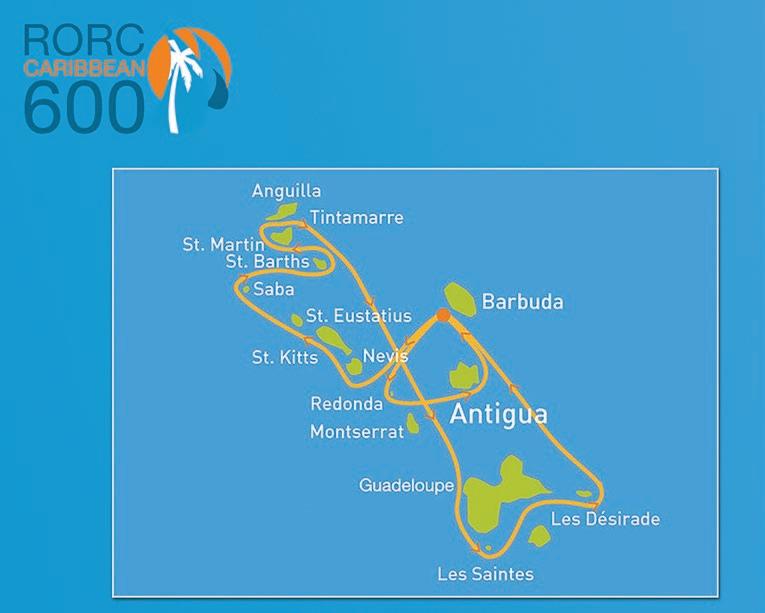
Zero with four highly competitive boats that Teasing Machine was in contact with all the time,” said de Turckheim. “We finished within 30 minutes of each other; that is exciting as well as the sailing itself. Callisto sailed really well and was always a threat. Further back, because they are 46 feet, was 3 - Corum
In the last race they beat us, this year we beat them. So well done to Callisto and 3 - Corum for making this class very hard to win.”

Teasing Machine crew includes de Turckheim, Laurent Pages, Aymeric Chappellier, Alexandre de Girval, Bertrand Castelnerac, Christian Ponthieu, Gabriele Olivo, Jerome Teillet, Paco Lepoutre, Quentin Bouchacourt, Quentin Le Nabour and Tony Brochet.
IRC One
Dan Litchfield’s classic Hound (USA) put in a great last beat from Redonda to win IRC One. The Aage Nielsen 59 sloop was built in 1970, the oldest boat in the race.
Laurent Courbin’s First 53 Yagiza (FRA), skippered by Phillippe Falle, was second by just 24 minutes after IRC time correction. In third place was Andrew & Sam Hall’s Lombard 46 Pata Negra (GBR), just six minutes behind Yagiza after IRC time correction.
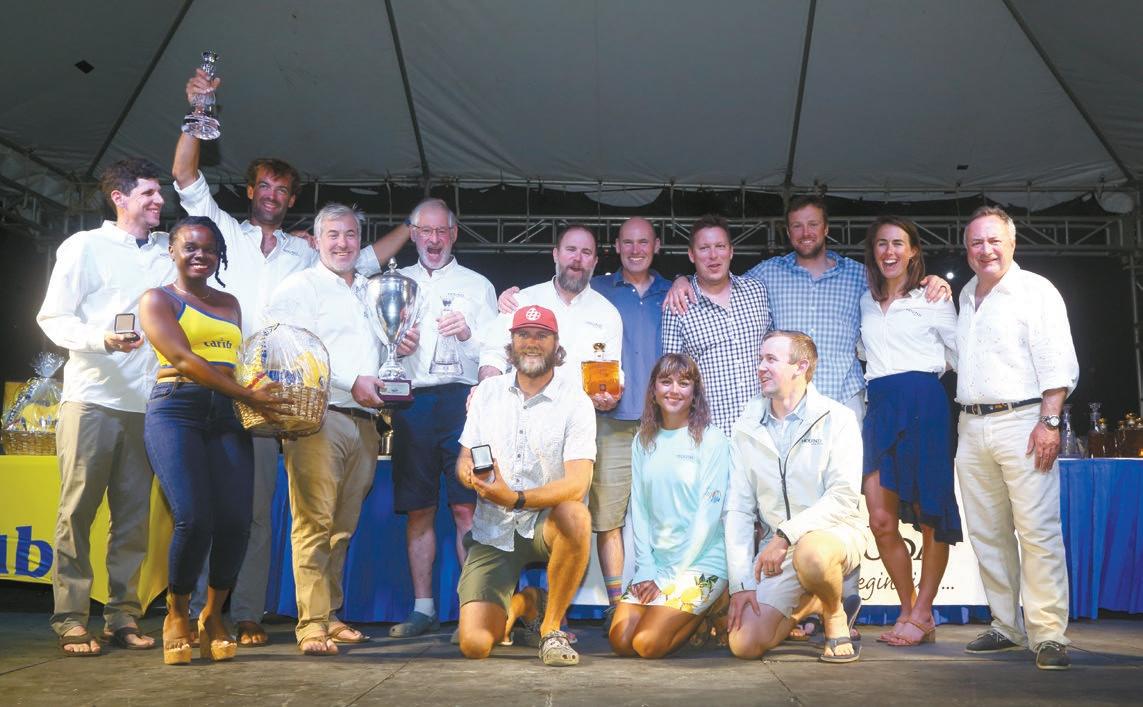
“We got pushed really hard by the other boats in our class; somehow we pulled it out at the end and it feels great,” said Litchfield, Hound owner. “It was only when we were rounding Redonda that we thought the win was possibly for real. The Hound crew is the best I have ever sailed with and the RORC Caribbean 600 is our big race of the season. Hound will be heading back to Newport, Rhode Island, and I know our two daughters will have missed cruising her, as we will do in the summer.”
Hound crew includes Tom Stark, Adam Klyver, Chris Murray, Daniel Litchfield, David Rosow, Devin Santa, Edward Cesare, Glenn Cook, Jason Black, Lyndsey Gibbons-Neff, Nicholas Horbaczewski, Owen Johnson, Peter McGrath, Rich du Moulin, Sumner Fisher and Taylor North.
—Continued on next page
Service Team
APRIL 20 23 CARIBBEAN COMPASS PAGE 11
• Yacht Concierge 24/24 - 7/7 • Electronic Clearance via Email • 4G/LTE & TVRO products & services • Project Management: Haul-Out, Maintenance • Gourmet provisions • Medical Turnkey Assistance & MEDEVAC Cell : +596 696 45 89 75 / Office : + 596 596 52 14 28 / mail : douglas@yachtservices.fr www.douglasyachtservices.fr
« A to Z » SERVICE AGENT IMAGE COURTESY RORC CARIBBEAN 600 PHOTO © TIM WRIGHT/PHOTOACTION.COM
The RORC Caribbean 600 course
Dan Litchfield’s Aage Nielsen 59 Hound (USA), the oldest boat in the race, won IRC One.
Continued from previous page
IRC Two
Peter McWhinnie’s JPK 1080 In Theory (USA) has won IRC Two by just under two hours from J/133 Vamoose (USA), skippered by Bob Manchester. Andy Middleton’s First 47.7 EH01 (GBR) was third.
“It feels fantastic. It has been great to get around the course with a wonderful crew. I can’t thank them enough,” said In Theory’s McWhinnie. “It was a relief to get through the last beat as the wind got a little fluky, but we made it to the finish and that was a very happy moment. One of the highlights of this race has been the close competition from other boats. We were always mixing it up with Vamoose, J Bella and EH01. There were a lot of great moments and a lot of hard sailing; it was pretty full on.”
In Theory crew includes McWhinnie, Com Crocker, Erin Sprague, John Slattery, Peter Fackler and Simon Karstoft Jensen.
IRC Two-Handed
Verdier 54 Notre Mediterranee Ville de Nice (FRA), sailed by Fabien Biron and Pim Nieuwenhuis, romped home in the double-handed class completing the course in an elapsed time of 2 days 17 hrs 15 mins 15 secs and taking the win after IRC time correction. Markus Moser’s Pegasus 50 Lifgun (SUI) racing with Marco Pas was runner up. Szymon Kuczynski’s Figaro 1 Hultaj (POL) racing with Anna Jastrzębska was third.
With all of the fleet accounted for, RORC racing manager Steve Cole said: “As always, the RORC’s primary concern for any race is safety, and we have special regulations in place to mitigate the risks of offshore racing. All the boats are accounted for and we hope that everyone has thoroughly enjoyed the race. The RORC race team supported by Antigua Yacht Club with the invaluable help of the army of local volunteers have produced a well-organised event here in Antigua. I am sure that I speak for all of the competitors in thanking them for their commitment and hard work, and we look forward to welcoming everyone back for the fifteenth edition in 2024.”
The 15th edition of the RORC Caribbean 600 will start from Fort Charlotte, Antigua, February 19, 2024. The 600-mile offshore race is the centerpiece for the RORC Nelson’s Cup Series, which is a new six-race regatta in Antigua. For more information visit www.caribbean600.rorc.org
Snowbirds Swoop Down on the 43rd St. Maarten Heineken Regatta
The 2023 St. Maarten Heineken Regatta attracted 95 teams across 14 classes for racing on March 2-5. The 43rd edition featured random leg and around-the-island courses for a fleet that ranged from VO 70s to Melges 24s to an assortment of bareboat charter boats. the Sint Maarten Yacht Club also had six identical RS Zests raced by young talent from the junior sailing program.
For others, what looks like a fun-filled week of regatta sailing in the sun is actually work. Heineken has entered an all-female team of employees in the regatta for 25 years, with this year’s crew from Heineken’s offices in Australia, the US, and the Netherlands. The chartered bareboat is always named Something Hot and tactician Maxine Burgers, revenue manager with Heineken, says the company recognizes that having staff racing together helps them develop their skills with teamwork and encourages female empowerment.
The final day’s racing saw many fleets battling for points to earn their place on the podium of the massive Heineken prize giving stage.
In CSA Class 1, despite Wind Whisper pulling two bullets from the day’s racing, it was I Love Poland who emerged first overall in this hotlycontested fleet.
In CSA 2, with just a few points between them all, it was a final bullet in the last race which gave Hooligan first overall in this class, with Privateer coming second overall and Final Final’s consistency giving them third place.
Also enjoying one final race, CSA 3 gave spectators one last chance to enjoy Flying Jenny’s spectacular spinnaker featuring a gorgeous image of owner Sandra Askew’s mother, Jenny. But it was the team on board Lazy Dog who pulled all the stops out to get a final bullet, with Team Island Water World second and Flying Jenny third overall.
With only four races to count in CSA Class 4, Fatjax maintained the first position overall with Ossiana second and Axonite third. For full results and news about the 2024 event visit the race website at www.heinekenregatta.com
And on the horizon…
Racing, Cruising and Charter Fleets Are Building for ASW 2023 Antigua Sailing Week 2023 kicks off on April 29 and runs until May 5.
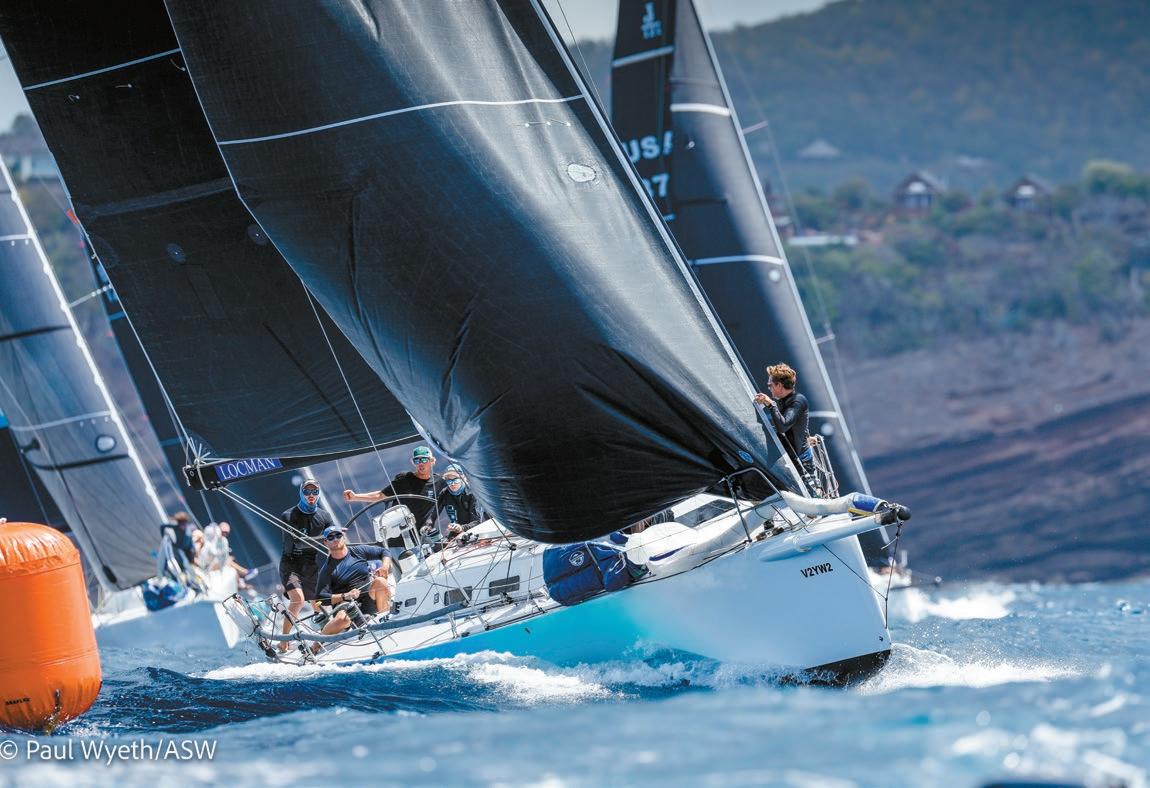
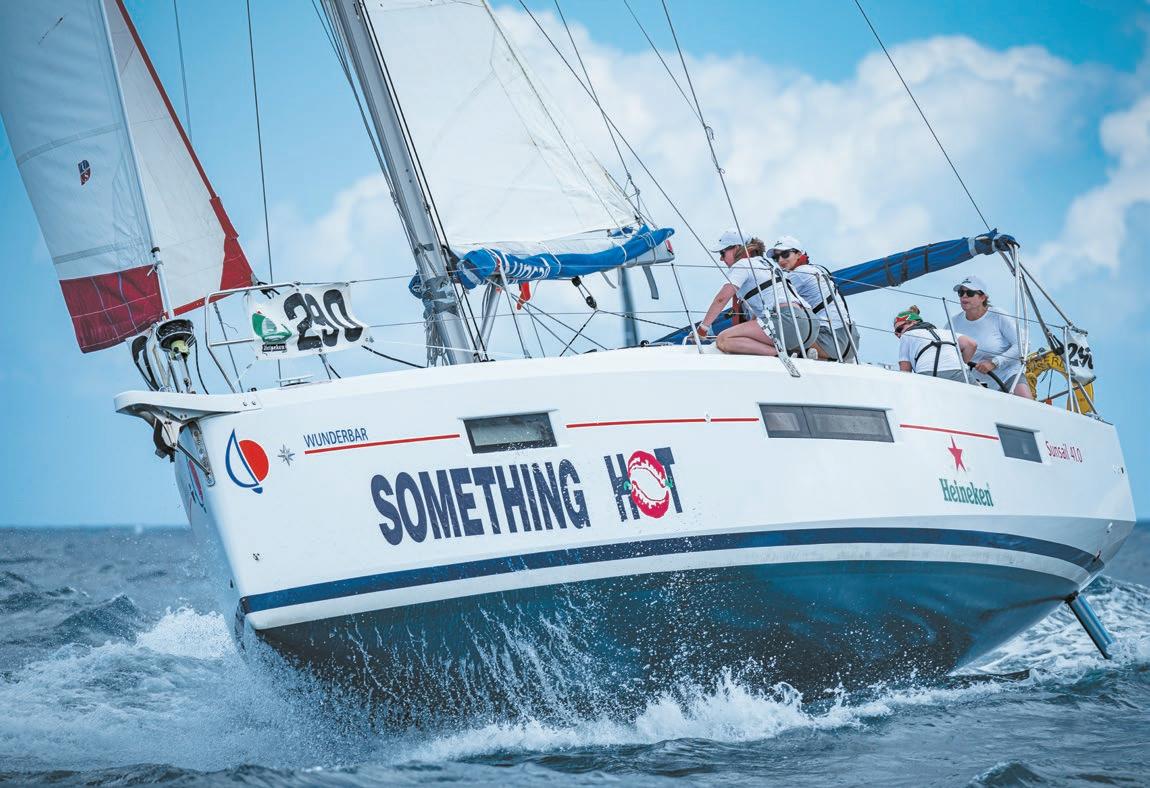
The class splits offer virtually level boat-for-boat racing to just about everybody. Dedicated race boats, pro-crewed racer-cruisers, raceready charter boats, and the latest generations of comfy but fast Swans and Bénéteaus are all finding a lot of competition in the CSA racing classes.
Getting sailing teams together for high quality racing during the cold winter months up North is often named as the main attraction of attending the St. Maarten Heineken Regatta. This year saw an increase in Canadian teams, with two bareboats independently chartered by members of the Royal Vancouver Yacht Club.
The highlights of the 2023 classes include:
CSA Racing: The high-performance Solaris 72 cruiser racer Black Pearl, skippered by Karl Pisec, joins a strong fleet of yachts in her class which include ASW notables such as Daniel Gribble’s Tripp 65 Prevail from the USA and Adrian Lee’s Irish Swan 60 Lee Overlay Partners II
The super-competitive CSA class is packed full of past winners and well-known names, including Antigua's Bernard Evan-Wong with TAZ, Pamala Baldwin’s J/122 Liquid, and top performing race charter boat El Ocaso, being sailed by owner Chris Body.
—Continued on next page
APRIL 20 23 CARIBBEAN COMPASS PAGE 12
©
PHOTO © PAUL
PHOTO
LAURENS MOREL/SALTYCOLOURS.COM
WYETH/ASW
Something Hot continues the Heineken ladies sailing team tradition for the 25th year, including returning and new crew members from across the brand’s global network.
Pamala Baldwin’s J/122 Liquid will once again be chasing the winners’ trophies in the CSA division.
Continued from previous page
The Performance Cruising class expects a battle between Sir Richard Matthews’s ST370 Holding Pattern and Sir Hugh Bailey’s Farr 45 Rebel This division also features Andy Middleton's First 47.7 EH01 and Raymond Rhinelander’s J133 Bella J
Multihulls: Gunboats include two 60s, Fredrik Moe’s Moementum from Jamaica, and Rob Merwin's Cui Bono from the US, plus Michel Larroche's Gunboat 62 Tribe. A newcomer to the Caribbean circuit, Oceans Tribute, a Crowther Tri, has been brought all the way from New Zealand by her owner Guy Chester.
New to ASW is a dedicated start line for the fast and nimble one-design RS Elite class. These unique keelboats are available for charter and only require two or three crew so it’s a cost-effective way to race with your sailing buddies. Reach out to the ASW race office to get assistance with organizing a charter from owners of the local fleet of RS Elites. Crews can pitch themselves against some home-grown talent with the Caribbean's best skippers at the helm. One of them is St. Martin's Robbie Ferron, sailing Oozlumbird. “Everybody wants to sail and race in the Caribbean,” Ferron says. “It is sometimes prohibitive due to costs and manageability, especially if you want high standards. But racing in Antigua in a RS Elite is financially easy and provides a high-tech boat that is a real pleasure to sail.”
ASW charter sponsor Dream Yacht Charter has been working to supply a range of bareboats, while individual crew spots and whole boats are still available. Contact the race office for more information on charters.
Club Class: The programme opens with the Peters & May Round Antigua Race on Saturday, April 29, followed by the English Harbour Rum Race Day and Welcome Party on Sunday. Monday, May 1, sees the Axxess Marine Y2K Race day with daily prizegiving and Captain’s Cocktail, followed by another race day on Tuesday and entertainment with Reggae in the Park. Racing crews head down to Pigeon Point beach for Wednesday’s Lay Day. The week finishes up with the Locman Italy Women’s Race Day on Thursday and racing, prizegiving and the big closing Party on Friday, May 5.
For information on Antigua Sailing Week, please visit www.sailingweek.com.
Antigua hosts 2023 North American Optimist Championship
Antigua and Barbuda have again been chosen as the venue for world class sailing and from July 2-9, 2023, will host the 2023 North American Optimist Championships (OptiNams), under the governing authority of the International Optimist Dinghy Association (IODA), in partnership with the Antigua Yacht Club and Nelson’s Dockyard National Park. This event will bring young sailors (and their support teams) from more than 20 countries to the islands for a week of dramatic racing and competition.
The North American Championship is one of seven international championships held annually, and an important goal for sailors wanting to compete at the annual World Championships. Antigua has been the venue for this event twice previously and in 2019 was the home of the Optimist World Championships, setting records with 65 nations in attendance.
“We are delighted to be hosting the IODA OptiNams again in July 2023,” says Karl James, MBE, two-time Olympian, President of the Antigua & Barbuda Sailing Association, and sailing manager at the Antigua Yacht Club. “It is not only a fantastic opportunity for our young sailors to compete in home waters, but also a chance for Antigua to show off our island and the spectacular sailing it can offer.”
Caribbean Multihull Challenge in 2024
After more than doubling its number of entries from 2022 to thirty boats, the Caribbean Multihull Challenge Steering Committee is setting its sights on an increase to forty for 2024. “Both the race and the rally have received great reviews from participants and press,” says Stephen Burzon, marketing and operations director. “With continued support from the Sint Maarten government plus that of repeating sponsors, we will have the marketing budget to bring more race and rally boats to this event which is evolving into a festival of multihull sailboats in the northeast Caribbean.”
Repeating in 2024 will be the dramatic CSA 1 trifecta pitting the fastest multis against each other in three distance races. Also returning is the Diam 24 one-designs racing on the south shore of the island, and the rally for cruising multihulls, a first-time event in 2023. Look for more features, including cash for winning racers, seminars for cruisers, and a
repeat of the popular Rally Navigation Challenge.
Applications Open for Junior Sailing Summer Camp & Marine Apprenticeship Programs
The Virgin Islands Professional Charter Association (VIPCA) has announced that free registration is open for its second junior sailing summer camp from July 17-28, 2023, for USVI public school students. Camp participation opens the door to enrollment in the year-round IGY Marinas-sponsored after-school sailing program. VIPCA is also accepting applications for its sixth annual marine apprenticeship program from June 22-July 26, for young adult (18-29) USVI residents. Apprentice graduates can enter the workforce immediately with a paid 12-month apprenticeship supported by the USVI Department of Labor, leading to a U.S. Coast Guard captain's license.
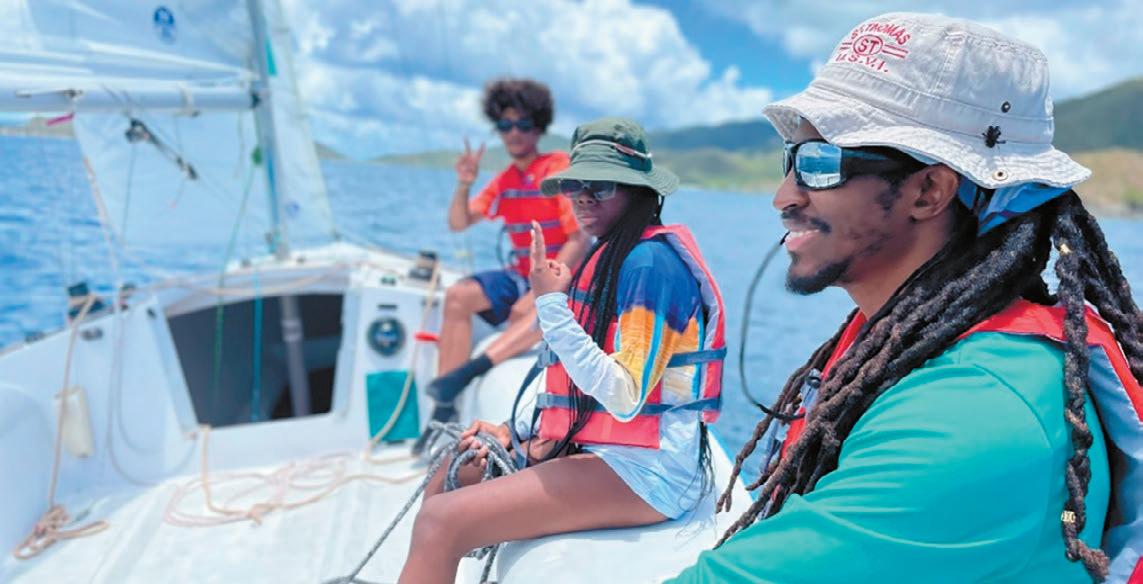

The Junior Sailing Camp, held at the St. Thomas Yacht Club near Red
Hook, offers teenagers ten days of learning to sail IC24s and Hobie Cats. This year, swim lessons first take place, twice weekly. The sailing camp is on weekdays, July 17-July 28. Land and sea instruction includes understanding the parts of a boat, navigation skills, reading weather and conditions, safety basics, and of course, plenty of sailing.
The camp is free to eligible public school students thanks to the annual $25,000 sponsorship by RapierMed, a USVI financial services and venture capital firm.
Students who participate in sailing camp have an opportunity to continue sailing via the year-round after-school IGY Marinas sailing program.
To apply, visit vipca.org/junior-sailing-summer-camp
The five-week marine apprenticeship program, June 22-July 26,
provides captain and STCW (Standards of Training and Certification of Watch-keeping) training including first aid and CPR certification; sea survival, and fire fighting. The schedule also includes swimming, SCUBA diving, sailing, and power-boating instruction; boating safety certification; charter vessel and business operations; technical skills and proficiency in diesel engines and outboards; and an introduction to marine careers with various government departments. The marine apprenticeship is free to participants, sponsored by the Island Foundation, and managed by the Marine Rebuild Fund within the Community Foundation of the Virgin Islands.
For more information and to apply, visit vipca.org/youth-training.
APRIL 20 23 CARIBBEAN COMPASS PAGE 13
Junior sailing camp participants
Marine apprenticeship participants
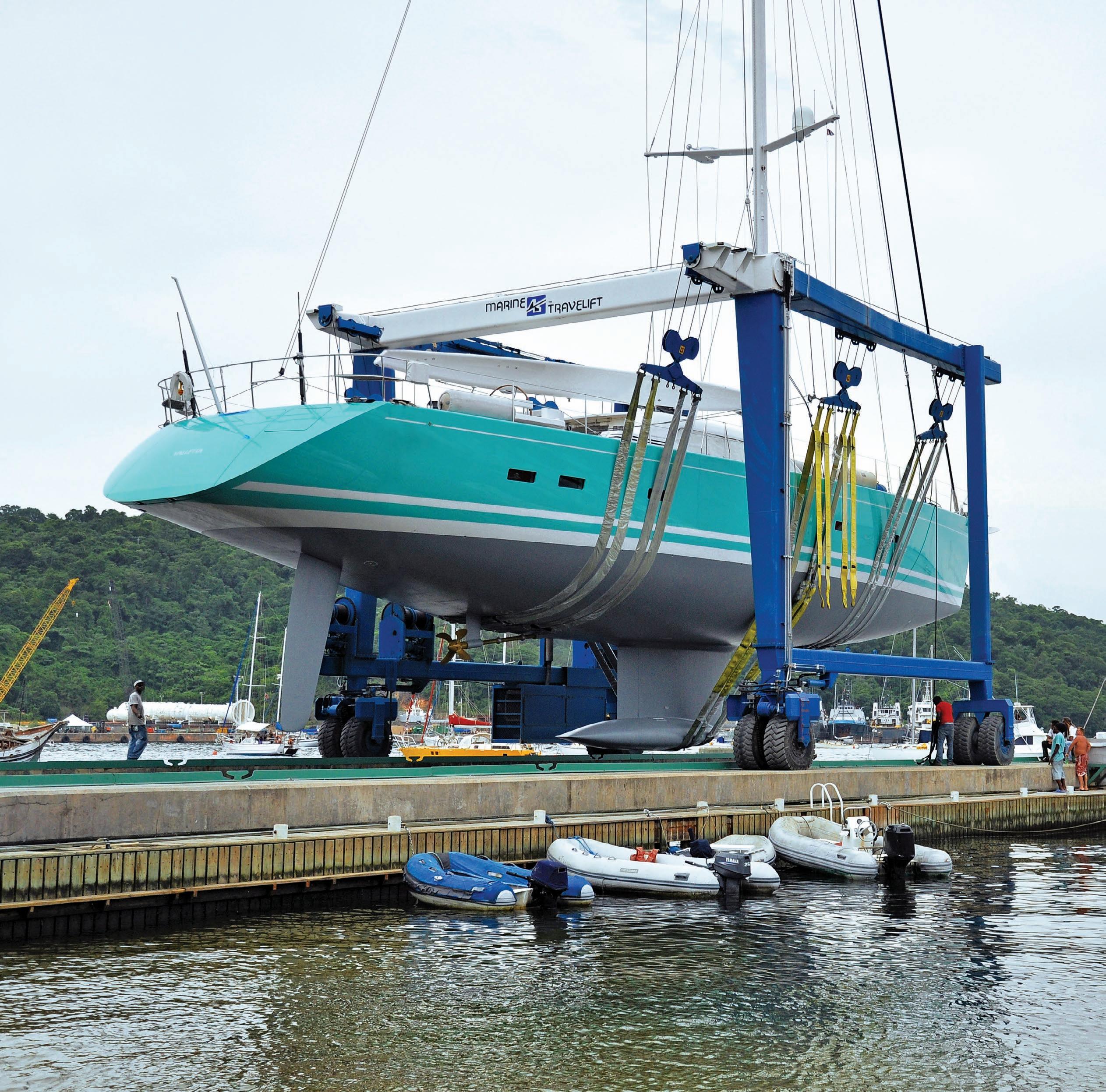
APRIL 20 23 CARIBBEAN COMPASS PAGE 14 YACHT SERVICES Chaguaramas Bay, Trinidad VHF CHANNEL 69 160 Ton Marine Travelift - Maximum Beam 31 ft No Forestay Removal On Most Yachts Below 60 ft Fully stocked chandlery, hotel and restaurant on site P.O. Box 3168 Carenage Trinidad • Tel (868) 634 4423 • Fax 634 4387 reservations@peakeyachts.com • www.peakeyachts.com • The most experienced, most professional yard in the Caribbean with the most comprehensive list of onsite marine services and contractors – FACT!! • At the best prices – FACT!! • FREE water - FREE electricity - FREE fully functional WIFI • All this in the least extreme weather zone in the region – FACT!! Treat your beautiful boat to the best. You know she deserves it! CONTACT US TO LEARN ABOUT OUR SUBSTANTIAL DISCOUNT SPECIALS.
CARIBBEAN ECO -NEWS
Beach Cleanup Nets more than 520 Pounds of Garbage
On February 11-12, over 40 children participated in the eighth annual St. Maarten Regatta Beach Cleanup at Kim Sha Beach, collecting over 520 pounds of garbage from the beach. The morning’s activities also included a quiz about the environment, followed by beach games.
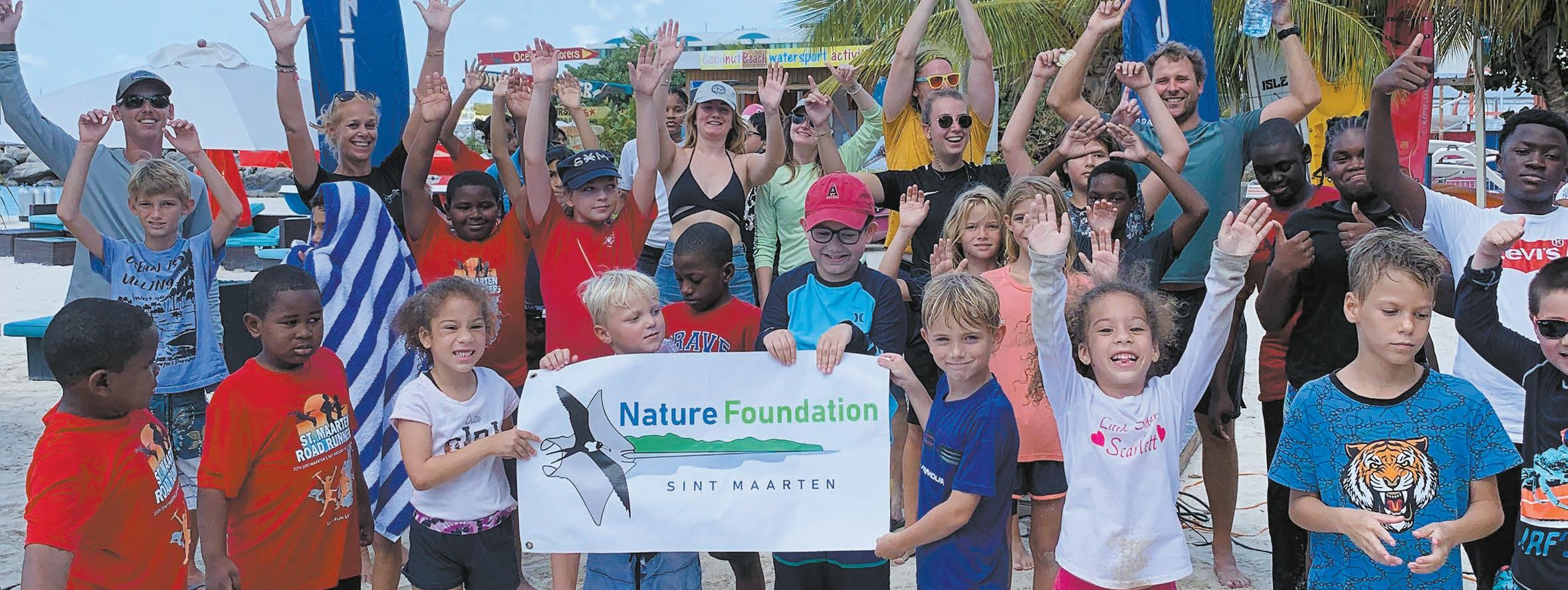
Before the cleanup, Christel Horst from the St. Maarten Nature Foundation gave a short presentation about the importance of beaches and the problems plastic is causing. Then the participants were divided in teams and had 30 minutes to collect as much garbage as possible. The Nature Foundation provided all participants with reusable trash bags and gloves to safely pick up the debris. The team that managed to gather the most trash won a gift voucher for free pizza sponsored by Domino’s.
After the horn blasted to announce the end of the Cleanup Challenge, a quiz about the environment was held, based on Horst’s presentation. Correct answers were rewarded with prizes provided by sponsors including Rainforest Adventures, Trisport, Intertoys, Funtopia, the Scuba Shop, Rhino Safari, Coconut Beach Watersports and Random Wind.
After the quiz, LAB Sports hosted sports activities to close off the morning in a fun way. Children played beach soccer, dodge ball, tug of war and relay challenges. Domino’s provided fresh pizza. During the event, participants had enjoyed the water sponsored by Fiji Water and pastries sponsored by Zeebest.
“It was wonderful to see so many children willing to contribute,” said Linda Koning, coordinator of the Cleanup. “The annual Beach Cleanup is a way for the St. Maarten Regatta to give something back to the Island. I would like to thank everyone who took part in the event. It is amazing to see that we collected so much garbage.”
Young Caribbean Turtles Stranded in Chilly UK Waters
Since November 2022, 13 stranded turtles have been found on the coast of England and Ireland, according to the Marine Conservation Society and Marine Environmental Monitoring, which maintains the database of UK and Irish turtle sightings. All the turtles have been relatively small juveniles. The cold temperature of the waters makes survival of the young turtles difficult.
“Although we see the most hard-shell turtle strandings and sightings between December and February, this year we’ve had more than usual,” said Rod Penrose, who leads Marine Environmental Monitoring. “They’re mostly juvenile or injured adults, so it’s thought that they struggled to fight the strong winds and currents of severe storms in their native waters of the US and Caribbean, where they were carried offshore into the Atlantic Gyre before ending up in cold UK waters.”
"If you find a stranded turtle, DO NOT put it back into the sea,” the MCS recommends. “It will be in cold shock and will need help. Instead, wrap the
turtle in a damp towel and set it on its belly somewhere safe and sheltered, raising its back end slightly to allow any water to drain from its lungs.
"Be sure to report the sighting as soon as possible so that the turtle can be taken to a specialist facility where it can hopefully recover or be treated."
Jamaican Climate Activists Raise Awareness of Deep-Sea Mining
Deep-sea mining is a new industry that aims to extract metals from the ocean floor. It is looked on as a potential source for metals used to produce technologies such as smartphones, solar panels, and electric storage batteries, but it comes with environmental consequences. The process of involves scraping the ocean floor with machines which disturb ocean-floor ecosystems and puts deep-sea habitats and species at risk. It also churns up fine sediment, creating plumes which affect the productivity of plant life. Finally, noise and light pollution from the mining machines is harmful to species such as tuna, whales, turtles, and sharks.
The International Seabed Authority (ISA) was established under the 1982 UN Convention on the Law of the Sea (UNCLOS) and its 1994 Agreement on Implementation with the dual mission to authorize and control development of mineral related operations in the international seabed as well as protect the ecosystem of the seabed, ocean floor and subsoil beyond national jurisdiction. Headquartered in Kingston, Jamaica, deliberations about deep-sea mining have reached a critical stage.
A team of young Jamaican advocates, led by the Jamaica Climate Change Youth Council (JCCYC) and supported by partners including Greenpeace USA, came together to present an in-depth look at the issue, especially as it relates to the Caribbean.
Emma Lewis of Global Voices reported on this meeting:
“Young Jamaicans are deeply worried that time is running out as the ISA works to finalise rules that might enable it to start deep-sea mining in earnest as early as in the next few months. This was precipitated by the triggering of a 'two-year rule' in June 2021 by the Pacific island of Nauru, which is sponsoring The Metals Company to conduct mining for polymetallic nodules in a wide area of the deep ocean.
“Earlier this year, a leaked video showed pollution flowing into the sea during a mining test by The Metals Company. While several countries in the region (including Costa Rica, whose representative shared his country's position at the event) are expressing concern and calling for a “pause” or moratorium, and France has voted for an outright ban on deep-sea mining, others seem intent on pressing ahead. Jamaica itself signed a contract in 2021 to sponsor Blue Minerals Jamaica Limited.
“The ‘Deep Sea Matters’ event took place at the University of the West Indies Mona campus in Kingston. Panellists were Dahvia Hylton (research, advocacy and policy development co-lead at JCCYC; Robyn Young, marine scientist and projects and administrative coordinator at SOA Caribbean; Christopher Corbin, senior coordination officer at the United Nations Environment Programme Cartagena Convention Secretariat and Caribbean Environment Programme in Kingston; and Laleta Davis-Mattis, lecturer in the Faculty of Law at UWI. The moderator was environmental activist and communicator Dainalyn Swaby.
—Continued on next page
APRIL 20 23 CARIBBEAN COMPASS PAGE 15
COURTESY ST. MAARTEN YACHT CLUB
St. Maarten kids celebrate a quarter ton of garbage.
Continued from previous page
“The event achieved its aim of raising public awareness of deep-sea mining and continuing the dialogue — which included many different views — around it. Youth participation was high, and the young people seemed really engaged.
“One JCCYC panelist, Dahvia Hylton, asked a pertinent question:
“ ‘Is the move towards deep-sea mining turning us into colonisers, ready to go and mine in another region?’ ”
Anguilla Joins Blue Belt Initiative
The British overseas territory of Anguilla is the latest member to join the United Kingdom’s Ocean Conservation Programme Blue Belt Initiative. The announcement was made by Quincia Gumbs Marie, minister of Sustainability, Innovation and the Environment.
“By joining the Blue Belt Initiative, Anguilla is demonstrating our commitment to improve the governance of marine and coastal ecosystems, achieve equal economic opportunities and restore and conserve biodiversity,” Gumbs Marie said.
“Our management efforts will include monitoring illegal, unregulated and unreported fishing in Anguillian waters, training our stakeholders, and support for the establishment of sustainable fisheries.”
According to the Anguilla Tourist Board, the country will seek to manage coastal and marine resources to spur economic growth and reduce poverty, while adapting to the effects of climate change.
Nature Conservancy Assists with Coral Reef Restoration
Sara Kirkpatrick of The Virgin Islands Daily News reports that the Nature Conservancy has coordinated with partner agencies to plant young coral at East End Marine Park and Buck Island reef on St. Croix. The Nature Conservancy’s preserve in Estate Little Princesse features a state-of-the-art coral laboratory along with the land-based nursery. “We now have a landbased nursery with raceways that allow us to propagate and hold thousands of corals,” Jessica Ward, Virgin Islands coral manager, told the Daily News
In recent years it has become increasingly difficult for corals to survive and reproduce in the wild, as they are bombarded by environmental stressors such as Stony Coral Tissue Loss Disease (SCTLD) and coral bleaching. The corals that remain in the wild, Ward told the News, appear to be the most resistant, and the Conservancy has been working to propagate those survivors. “We also conduct assisted sexual reproduction," she added, "collecting coral gametes during spawning and mixing parent genomes to increase genetic diversity, which also increases ecological resilience.”
Ward said another mass outplant is scheduled for April, and at that time some of the slower growing corals will be introduced to the Buck Island reef.
Some species of coral, such as elkhorn and staghorn, are not susceptible to SCTLD, and grow rapidly. Ward said her team focuses on outplanting these types of coral first, but they are also working on deverloping and replanting larger, slow growing corals, such as brain, boulder, and star corals.

“Roughly 5,000 corals were outplanted at the end of 2022 — 4,300 fragments of elkhorn between the East End Marine Park and Buck Island Reef, and 850 staghorn fragments at Buck,” Ward said. “Nearly 1,400 staghorn fragments were outplanted at the beginning of February at East End Marine Park, and my team is out this week planting a similar number of staghorn at Buck.”
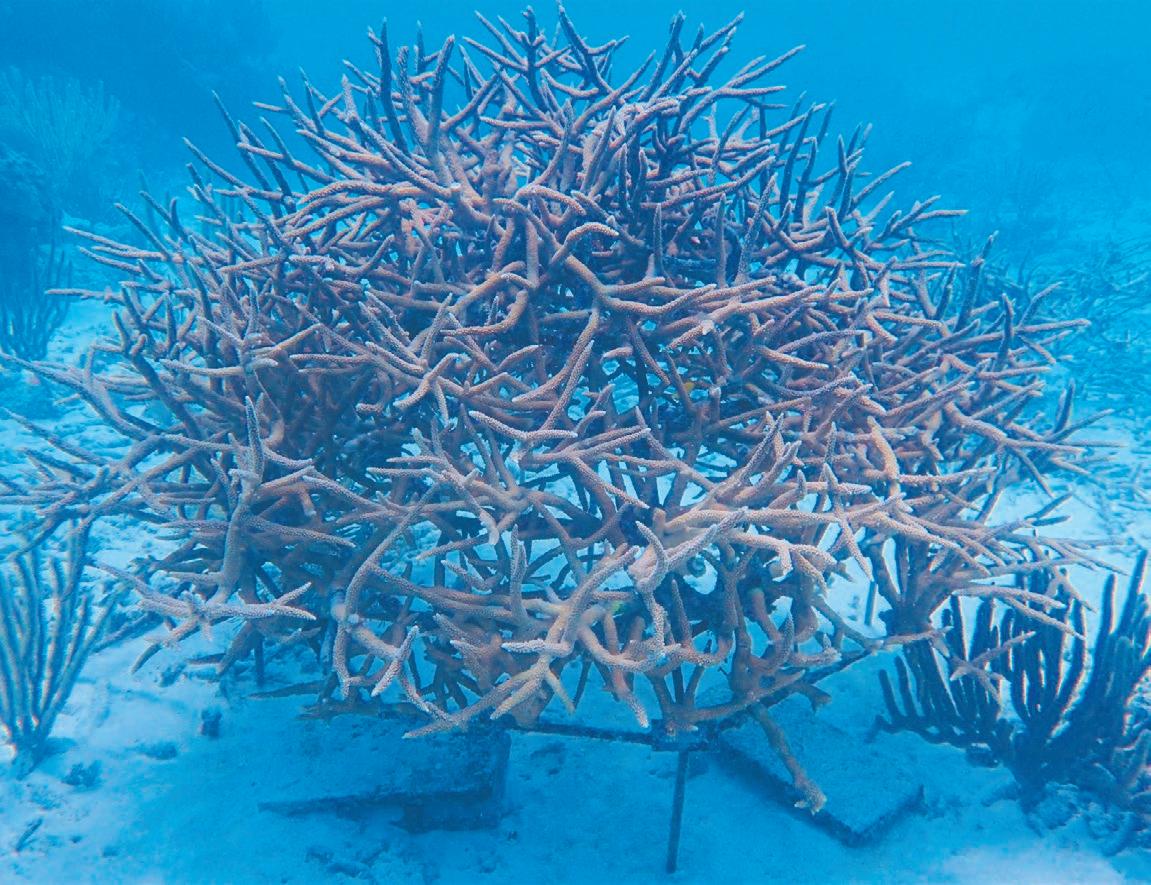
For residents and visitors who want to help protect local coral reefs, Ward said it is important to follow rules and guidelines set in protected park areas.
For those who would like to learn more about The Nature Conservancy’s coral restoration efforts, the coral lab is open to the public for tours on Tuesdays at 2 p.m. The East End Marine Park also has a coral nursery site, and the next snorkel-based tour is in May.
Dominica Earns Sustainability Awards
WildDominique, created to support and promote sound conservation practices in Dominica, has been announced as the winner of the tourism education and training category in the 2022 Caribbean Sustainable Awards Competition for its Friends of Conservation initiative. The awards are given annually by the Caribbean Tourism Organisation.
The initiative, launched in 2022, is a joint collaboration between WildDominique; the Forestry, Wildlife & Parks Division; Discover Dominica Authority; and the Dominica State College. Its aim is to establish biodiversityfriendly livelihoods, and to ensure that tour guides are exposed to updated and accurate information regarding Dominica’s natural resources.
“We are elated to have won the award for tourism education, as our chief objective is to educate the public on the importance of sustainability in Dominica,” said Jeanelle Brisbane, founder of WildDominique. “We are touted as the Nature Island of the Caribbean so it is imperative that we combine our efforts to keep the island clean and green so that visitors and residents will enjoy the benefits of our forests year after year.”
Three additional Dominican tourism businesses received runners-up awards. Both Rosalie Bay Eco Resort & Spa and Citrus Creek Plantation tied as second runner-up for Excellence in Sustainable Tourism, while Mango Garden Cottages scored second runner-up for Community-based Tourism.
Panama Moves to Protect more than Half of its Waters
Panama’s President Laurentino Cortizo and Minister of Environment Milciades Concepción have added 36,058 square miles to the Banco Volcán marine protected area in the Caribbean. During the last two decades, researchers at the Smithsonian Tropical Research Institute (STRI) along with local and international collaborators have offered much of the science backing Panama’s successful proposals to create the MPA’s bringing more than 50 percent of its ocean waters under some form of management or protection.
Created in 2015, with 5,487 square miles, the Banco Volcán Managed Resources Area is an area with unique natural resources, such as deep mountain ranges and high biodiversity that includes various migratory species and protected and endangered species, all important for the health of the oceans. The proposal to expand its limits was made in response to a request from the Ministry of the Environment last year, after a review of the protected area by STRI scientist Héctor Guzmán and considering the ecological integrity of the region.
—Continued on next page
APRIL 20 23 CARIBBEAN COMPASS PAGE 16
PHOTO COURTESY THE NATURE CONSERVANCY
PHOTO COURTESY THE NATURE CONSERVANCY
Staghorn corals grown on a nursery structure.
Nature Conservancy Coral Manager Jessica Ward removes algae and cleans substrate prior to outplanting coral fragments at the St. Croix East End Marine Park.
Continued from previous page
The expansion of the Banco Volcán Marine Protected Area in 2023 has not only led Panama to protect more than 54 percent of its territorial waters, but will also buffer climate change, protect Panama's deep-sea mountain environments, and help safeguard fauna from human interventions. In addition, it could maintain the connectivity of migratory routes for oceanic and marine-coastal species in the area that extends along the Caribbean coasts of Jamaica, Colombia, Honduras, Nicaragua, Costa Rica, and Panama. The Smithsonian Tropical Research Institute, headquartered in Panama City, Panama, is part of the Smithsonian Institution. The Institute furthers the understanding of tropical nature and its importance to human welfare, trains students to conduct research in the tropics and promotes conservation by increasing public awareness of the beauty and importance of tropical ecosystems.

Regatta Mangrove Planting
Competitors in the February 28 St. Maarten Regatta took part in a mangrove planting initiative. “The aim is to plant at least 100 mangrove trees, representing one per boat entered at the event to leave a positive impact on the island,” said Michele Korteweg, regatta director. Working closely with Nature Foundation St. Maarten and EPIC (Environmental Protection in the Caribbean), the trees have been grown from locally sourced seeds. Donations received at the event will make more planting possible.
St. Maarten Cleanup Aids Pelican Habitat

A cleanup effort by 30 volunteers at Fort Amsterdam, St. Maarten, in March 2023 yielded a huge pile of trash, including trash collected, including car parts, beach chairs, cables, zinc debris, bottles and pieces of Styrofoam. This cleanup of the habitat of the Caribbean brown pelican was important because “monitoring over the last five months showed that there are only about 30 pelicans nesting at Fort Amsterdam,” says Margot Mesnard of the Environmental Protection in the Caribbean (EPIC) Foundation. “Many raise just one chick per year and need to take care of the chick for several months. EPIC encourages everyone to protect their habitat from pollution while trying to reduce disturbance as much as possible to keep a healthy pelican population.”
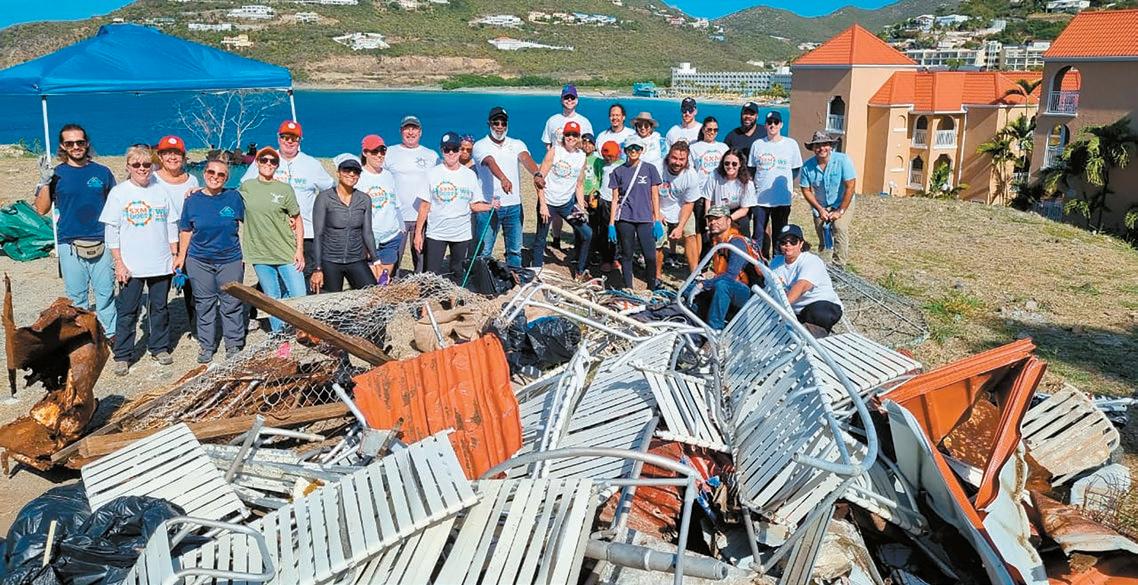
EPIC’s Pelican Project started in November 2022 and runs until April 2023.
The objective is to research the current status of the Caribbean brown pelican on Sint Maarten and promote conservation of its habitat through awareness raising and outreach activities. With the data collected, the long-term goal of this project is to improve management of natural resources for the preservation of biodiversity on Sint Maarten.

APRIL 20 23 CARIBBEAN COMPASS PAGE 17 Clarkes Court Bay Road, Woburn, St. George, Grenada, W.I. 1 (473) 439 – 3939 | info@clarkescourtmarina.com www.clarkescourtmarina.com DOING IT RIGHT THE CAREFUL ATTENTION GIVEN TO OUR CLIENTS AND THEIR BOATS IS FILLING OUR BOATYARD TO CAPACITY AND WE LOOK FORWARD TO OFFERING YOU THE SAME SAFE AND PROFESSIONAL SERVICE. CREW FACILITIES • Restaurant, Bar & Luxury Apartments • Laundry, Hot Showers • Taxi & Shopping Bus Services available from the yard • Customs & Immigration and Fuel Supply are close by • Onsite Chandlery ON SITE TECHNICAL SERVICES • Project Management & Consultancy • Yacht Brokerage and Guardianage • Rigging, Sail Making and Canvas Work • Metal Fabrication • GRP & Composite Fabrication • Fine Wood Work & Carpentry • Electrical Installation & Electronics • Bottom Painting, Waxing & Polishing • Diesel & Outboard Engine Installation & Repair • Life Rafts, Safety Equipment & Inflatable Dinghy Repair
Top: Trash collected from Fort Amsterdam
Bottom: Caribbean brown pelicans
Tobago Cays Marine Park Changes Anchoring Zones
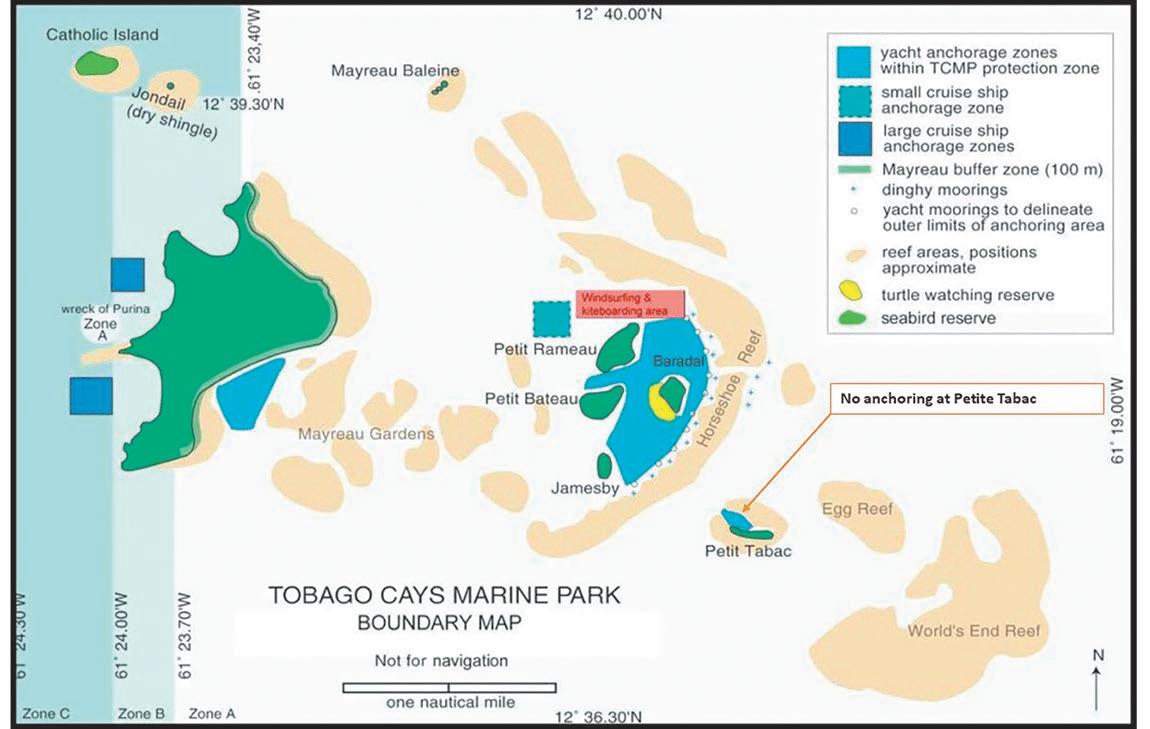 by Emma Doyle
by Emma Doyle
The Tobago Cays Marine Park recently announced a change in the permitted anchoring zones. This removes the small anchoring zone adjacent to the cay of Petite Tabac, which is located outside the main lagoon of the Cays, on the windward side of Horseshoe Reef.
Managing a marine protected area such as Tobago Cays Marine Park means balancing goals. Conservation and protection of flora and fauna have to come first, but providing access to visitors is important too, and with that human element comes the task of ensuring user-friendliness. It’s not always an easy line to walk. So we asked the marine biologist from Tobago Cays Marine Park, Marleya Adams, to give us some more insight into the decision and the options now available to cruisers who wish to visit Petite Tabac.
to respect all the park’s rules for conservation, including no fishing and not disturbing the sea turtles.”
The fixed moorings in Tobago Cays Marine Park provide an excellent alternative to anchoring and are recommended to avoid the risk of anchor damage to coral reefs. Anchoring in the park now attracts a fee equivalent to the mooring fee, so there’s no cost saving to visitors from anchoring.
In recent years, Tobago Cays Marine Park and other members of the
Grenadines Network of Marine Protected Areas in St. Vincent and the Grenadines and Grenada have worked to improve the quality and reliability of their mooring infrastructure. This has included joint technical training by Mustique’s harbourmaster on best practices for mooring construction and standard operating procedures for mooring maintenance.
The newest advance at Tobago Cays Marine Park is an online system for the payment of park fees, as can also be found in Bonaire, Sint Maarten, and at some marine parks in The Bahamas, the Dominican Republic and Belize.
The Tobago Cays Marine Park was decreed by St. Vincent and the Grenadines to protect and conserve the cays, corals reefs, sea grasses, fish, conch and species like sea turtles, sharks and rays that characterize this special area of the Grenadines. The park’s coral reefs are regionally significant for their health and connectivity to other reefs—in fact, the park is a priority marine protected area for the United Nations Environment Program, for the US National Oceanic and Atmospheric Administration (NOAA) and the Gulf and Caribbean Fisheries Institute’s MPAConnect Network, and for the German International Cooperation Agency (GIZ), among others.
“Petite Tabac has the narrowest anchorage within the park and its boundaries are encircled by coral reefs,” Adams says. “From our own observations and those of visitors, we’ve seen increasing signs of damage to the corals from anchoring. Our decision now seeks to proactively prevent further damage of this sort to the coral reef.”
She adds: “This decision comes in the context of ever-heightened stressors on reefs, like coral bleaching from increased sea temperatures associated with climate change, and from stony coral tissue loss disease which is now occurring in waters to the north and south of the Cays.”
Tobago Cays is one of the Caribbean’s iconic marine parks, and the managers recognize that cruisers seek areas to anchor or moor in different parts of the park for seclusion and for access to good snorkeling. “Currently, we are working on the installation of dinghy moorings at Petite Tabac, which will make it possible for visitors to dinghy over from the lagoon and snorkel there,” Adams says. “In the meantime, dinghies can pull up on the beach and water taxis are allowed to drop off customers at Petite Tabac.”
Anchoring in sand will still be permitted in the main lagoon of Tobago Cays, with cruisers requested to avoid anchoring in seagrass, which is home to an aggregation of juvenile green sea turtles that feed and grow in the park before making their way towards breeding areas in other parts of the Caribbean.

We know that the majority of cruisers and visitors want to do the right thing and comply with anchoring regulations to protect coral reefs. We ask visitors
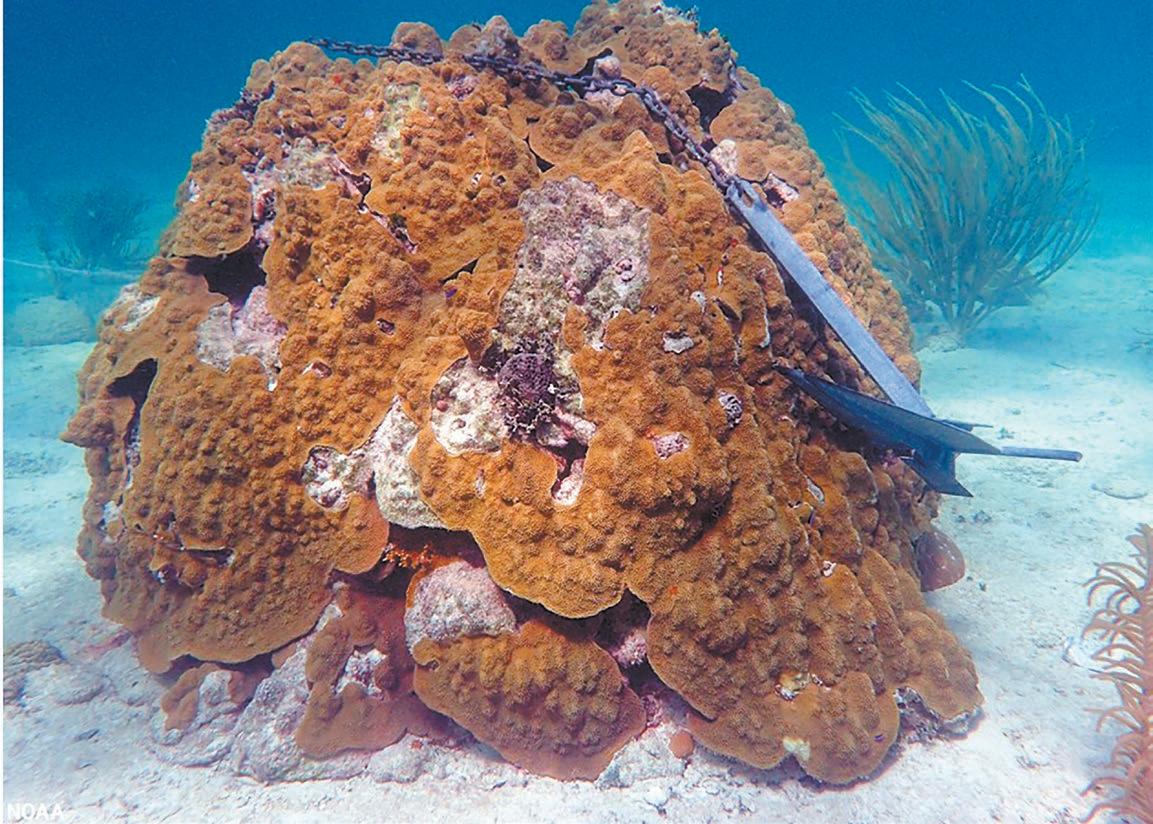
“The online platform for credit card payment of park fees can be found at www. tobagocays.org,” Adams says. “A barcode is provided upon successful payment and this can be shown to the rangers when visiting the park for verification.”
Park fees help the managers of Caribbean coral reefs, like Tobago Cays Marine Park, provide quality fixed moorings and protect coral reefs, they support enforcement patrols, and help fund research into coral reef health, water quality and sea turtle monitoring. The fees enable marine parks to run environmental education programs for local children and to sponsor scholarships for local youth, among many other activities to promote sustainable marine resource use.
Thanks go to cruisers for being loyal visitors to the Tobago Cays Marine Park and other marine protected areas in the region, and for supporting marine conservation efforts.
Emma Doyle is the MPA Connect coordinator for the Gulf and Caribbean Fisheries Institute (Gcfi.org). For more information please contact the Tobago Cays Marine Park office at tcmp191@hotmail.com, +(784) 485 8191, www.tobagocays.org or mpaconnect@gcfi.org.
APRIL 20 23 CARIBBEAN COMPASS PAGE 18 CARIBBEAN ECO NEWS
IMAGE COURTESY TOBAGO CAYS MARINE PARK
PHOTO COURTESY NOAA PHOTO
BY EMMA DOYLE
Map of location of former anchoring zone
“We’ve seen increasing signs of damage to the corals from anchoring.”
Green sea turtle at Tobago Cays Marine Park
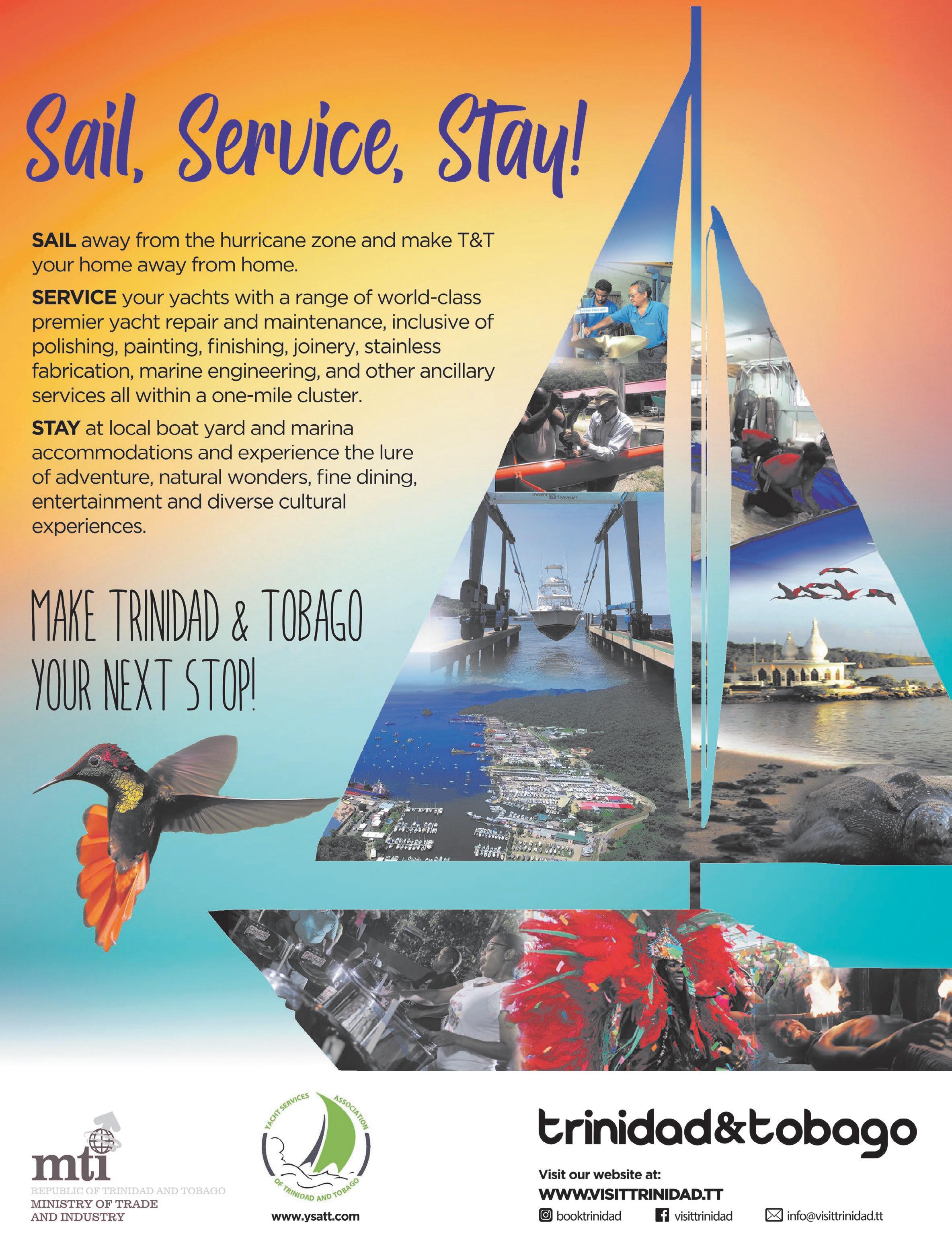
APRIL 20 23 CARIBBEAN COMPASS PAGE 19
Ready About! Hard aLee! I’ve seen Sailing’s Future
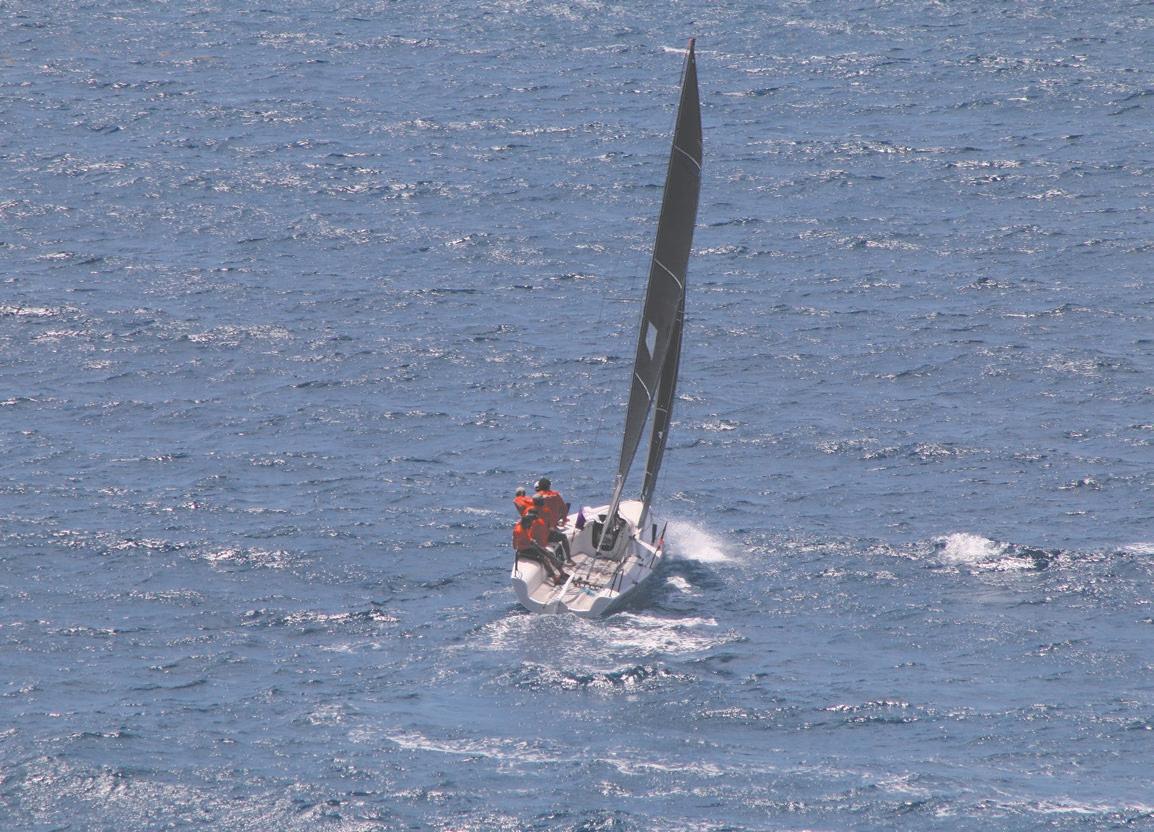 Story and Photos by David H. Lyman
Story and Photos by David H. Lyman
I was in English Harbour covering last year’s Antigua Classic Yacht Regatta and Antigua Sailing Week, the last two events on the Caribbean sailing calendar. It was here in this historic harbor town I had a glimpse into the future. A fleet of Optimist dinghies were tacking, jibing, running, sailing in and around the anchored yachts. Each small boat, no larger than a bathtub, held a single kid, PFD on, one hand on the tiller, the other on the mainsheet. I couldn’t keep my eyes off them. I was concerned, watching those boats come close to swamping each time a kid snap-tacked or jibed, anticipating that at any moment one was going to T-bone a million-dollar anchored yacht. I needn’t have worried. No one came to grief in the water that day, and if they had, a Boston Whaler with a couple of older kids was handy-by for the rescue.
As I watched, it was clear that the future was not the innovative go-fast hulls or black carbon sails; it was the kids running up and down the docks. Never walking, always running. Their smiling faces, I was glad to see, came in many colors. The future of sailing on oceans is these kids, and Antigua is doing its part to get them involved, trained and out there. Not only knowledgeable of race rules and tactics, but skilled at sail trim, boat handling, seamanship, crew positions and the adventure that awaits those who go to sea on a sailboat.

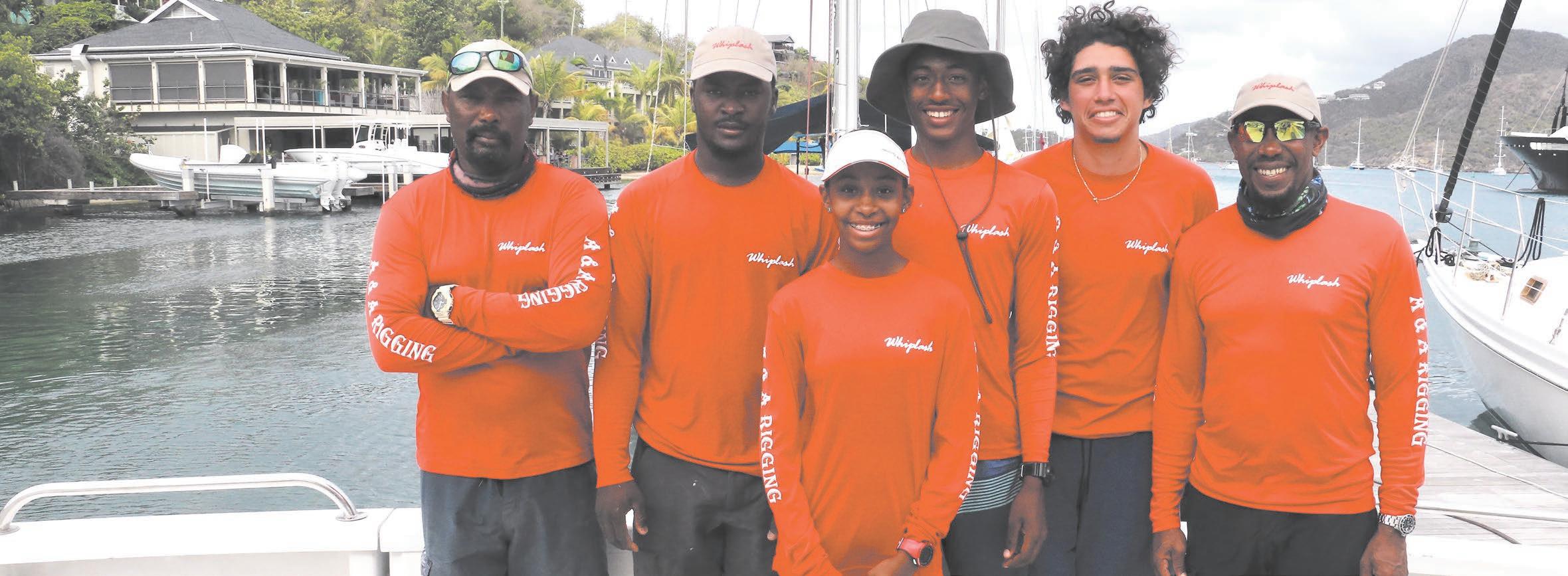
Three older crew men, in the same red shirts, were sitting on an adjacent yacht, watching, chatting. I’ve been on these islands for 20 sailing seasons, and still can’t understand a word of what they were talking about, so as I drew closer, I asked them, “What language is that? Creole? Patois? Greek?”
“We speak English. We just speak it fast,” came the reply, the three laughing at my bewilderment. Now, I have no problem carrying on a conversation with the teens and young kids on the docks. They all speak perfect, understandable English, but when they turn 20, all that school-taught English goes out the window, replaced by the local dialect, spoken in various forms, on all the former English islands. It’s not unpleasant to listen to. It’s actually quite musical and seems to always to be accompanied by laughter. But it’s unintelligible to me.
It was the beginning of Sailing Week, and the place was buzzing. On my first morning walk along the docks, I paused to watched three teenagers, in matching red T-shirts, rig a Melges 24 racing sled named Whiplash. The kids appeared to know what they were doing, preparing for the day’s race. I learned their names and ages later: Emily (Emma) Gaillard 15, Ozani Lafond 17, and Luca Deleau 17. (Editor’s note: Gaillard made sailing history in February 2023 as the youngest person on record to compete in the Caribbean RORC 600 as crew aboard Spirit of Juno, a Farr 65.)
I can carry on a normal conversation with any West Indian if they switch back to their delightfully lilting, up and down, English. It’s just when they are conversing among themselves that I’m at a loss. Is it code they speak between themselves, so to confuse us off-islanders?
That afternoon, when the boats arrived back at the docks, crews exhausted, excited, the adrenaline was still pumping, I got to chatting with Ashley Rhodes, owner/skipper of Whiplash. He usually converses in that West Indian dialect I can’t understand, but in perfect Antigua English, he told me he’d been like Emma and her friends when he was a kid—a product of English Harbour.
—Continued on next page
APRIL 20 23 CARIBBEAN COMPASS PAGE 20
Fending off protects the gelcoat and keeps the neighbors happy.
Whiplash, closehauled, has the playing field to herself.
Whiplash crew: from left, Robert Green, Rhone Kirby, Emily Gaillard, Ozani Lafond, Luca Deleau, Ashley Rhodes, owner/skipper.
Continued from previous page
Ashley learned to sail and handle boats many years ago from Karl James and his staff, Karen and Jack, at the Antigua Yacht Club. Along with those lessons came a desire to see the world, from the deck of those larger yachts he saw sailing into his harbor each year. He went sailing and in the 1990s landed in, of all places, Camden, Maine. This small town, on the edge of Penobscot Bay on the coast, is one of yachting’s major centers. There, at the Wayfarer Boat Yard, Ashley learned the rigger’s trade during summers, working his way up to head rigger. He’s back home in Antigua now, and for the past 18 years, has been running his own rigging shop, A&A Rigging and Yacht Services, in English Harbour.

Later in the week I spoke with Emma, the only girl on Whiplash’s crew. I asked what she was planning to do after high school, college or sailing.
“Sailing!” she replied. I got the same answer when I ask her two teenage male mates.

Other Antiguans who have learned to sail in this harbor are now professional sailors, racers, riggers, sail makers and yacht captains, in ports all around the world. As for Antigua’s economy, this small island has little to export, except its sailors. They sail the world, sending home money. When they return to raise a family, they bring with them knowledge of the wider world. They build and invest in businesses to service the international marine trade that arrives each fall. They buy their own racing sailboat and join in when the world of sailboat racing comes to their own harbor. Ashley has owned and raced Whiplash for six years. It’s just a way of life here in this harbor town.
With Whiplash put to bed for the night, Ashley and his crew joined the 600 other sailors on the yacht club lawn for the prize giving, honors and a party. Ashley’s three teen crew joined other island kids off other boats to share the excitement of their respective race.

How do kids like these get into this rich man’s sport? I went to find out.
First stop next morning was the yacht club. There’s been a sail training program here for kids ages six to 25 for three decades. Turns out that Karl James has managed the dinghy sailing program here for most of those 30 years.
“I grew up in this harbor,” he tells me. “I whittled small boats from scrap lumber. When I was just 12, I began hanging around the docks. Someone asked if I want to go sailing. I did, and I worked up there. In my teens, I was working at a hotel here on the island. Dennis O’Connor, a guest, heard I was a passionate sailor and gave me a Laser.”
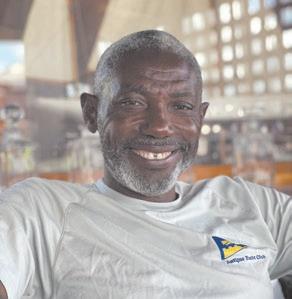
James began winning races all throughout the West Indies. He’s a two-time Olympian in the Laser Class and has competed internationally in over 75 countries. He’s been a professional helmsman and a racing crew member on famous racing yachts. In 2019, James was honored by the Queen of England with the OBE, Order of the British Empire, for “services to sailing and national development.”
“We have 20 Optimist dinghies here,” James told me. “We use these to get the younger kids started. They learn nomenclature, how to rig and care for their boats. They learn how the wind moves their boat and how to control it.” James has a team of young instructors under him, and the support of the community.
The club also has a fleet of Lasers for serious team race training, and Sport 16 and 26es for serious fun.
The Club plays host to four of the Caribbean major sailing events, the RORC Caribbean 600, The Super Yacht Challenge (not an AYC event), Antigua Classic Yacht Regatta and Antigua Sailing Week (and in 2023 the return of the Antigua to Bermuda Race). In season, the docks in front of the yacht club are packed with mega yachts, ocean racers, world famous classic, wooden gold platers. The kids are just accepted as part of the scene. James has managed to get many of them crewing on the boats that come to race.

I was still curious about all these kids running about the docks, so sat down one afternoon for a chat with Alison Sly-Adams, president of Antigua Sailing Week. Got something you want done? Give it to a busy person. They’ll get it done, so goes the saying. Sly-Adams is just that person. She’s a bundle of energy. She runs Mainstay Caribbean, a marketing and management company specializing in yachting businesses. She has her hand in most anything sailing here in Antigua. She’s the general manager at the National Sailing Academy. An expat Brit, she’s past president of the Caribbean Sailing Association, and handled secretariat matters for the Antigua and Barbuda Marine Association. I was fortunate she had time for a chat.
—Continued on next page

APRIL 20 23 CARIBBEAN COMPASS PAGE 21 BOAT PAINT & COMPOSITES Time Out Boat Yard Saint Martin Next to the French Bridge Fiberglass + Epoxy & Polyester Resins Epoxy primer + Polyurethane Top Coat Phone: + (590) 690 221 676 info@boatpaintstuff.com www.boatpaintstuff.com ANTIFOULING SPECIALIST: PPG Amron COPPERCOAT Permanent Antifouling (10 years and more…)
Kids on Optis
Dinghy sailing program manager Karl James
Alison Sly-Adams, president of Antigua Sailing Week
Continued from previous page
“The National Sailing Academy was Elizabeth Jordan’s idea,” she told me. “Elizabeth was the commodore of Antigua Yacht Club and saw the need for all the island’s youth to learn to sail, not just the youth of yacht club members. She found the money — she’s good at that — and The National Sailing Academy opened to all Antiguan youth in 2010.”
As Sly-Adams told me, for the first four years, the academy operated out of the Antigua Yacht Club. In February 2014, they moved the program to its own site just down from the Falmouth Marina on Dockyard Drive. For the eight years that Jordan was commodore of the yacht club, she was also president of the academy, and still is. Sly-Adams now runs the show as the general manager. “Elizabeth is a dynamic woman,” Sly-Adams told me. “She raised the funds to get the program started and keep it going. She got the large yachts that spend the winter here to contribute to building what is now a watersports and marine compound over there.” She pointed toward the inner harbor. The academy has over 250 sailors, or soon-to-be sailors, involved in numerous programs to get Antiguans out in the water.

Later, I went to explore the academy campus. On a couple of acres, Jordan and Sly-Adams have put together a modest yacht club, with two floating docks, a great West Indian restaurant, a dive shop, launching ramp, an Airbnb, offices, parking lot and work sheds. Hauled out on the ground were a few dozen sailing dinghies of various sizes, just waiting for the afternoon deluge of young sailors to arrive.
“The academy’s mission,” Sly-Adams told me, “is to change the lives of the island’s youth and adults by introducing them to sailing, not just as a sport or leisure option but also as a career. The after-school program is now open free to all Antigua school kids, but,” she added, “at this point we get a small utility subsidy but no financial support from the school system.”
I found that strange. Antigua schools support cricket, football, other athletic sports. Why not sailing? Sailing is the one sport on this sailing island that gives Antigua’s kids an open door to the world. Antigua has already sent off its sailors to the Olympics, to crew on and drive yachts around the world.

“The schools do not even provide bus service for the afternoon classes,”
said Sly-Adams. “We do that. We have our own busses.” But it was the “Sailability Programme” she was most proud of. It’s a sailing program for the differently-abled children and adults of Antigua, designed to “get them out on the water, in a small boat, feeling the motion, some for a joy ride, others developing the skills they have within their abilities.” With people like Sly-Adams, Jordan, James and others, and the support from financial benefactors far and wide, the kids of Antigua have a chance of going to sea to see the world.
With the excitement of Sailing Week stuffed in my notebook, I walked over to Pigeon Beach for a swim one afternoon. At the top of the hill there’s a splendid view of Falmouth Bay and the yacht club dock lined with the megayachts. I stopped to watch the kids in their fleet of toy boats navigate back to the yacht club wharf. As they tacked back and forth, within inches of the gleaming hulls of those 200-foot mega-yachts, I was more nervous than any of those kids. I also thought those kids were having a helluva lot more fun than the owners in their floating hotels. At ten years old, they were out there, on the water. They had freedom, their hand on the tiller of their future. They were coming to understand the value of working with nature, not fighting it, of acquiring skills and knowledge and setting your own course in life. Give kids a few skills, introduce them at an early age to a world of sailboats (not power boats, sailboats!) and they will be sailors for life. My kids, now in their twenties, are both out there now working on the water in professional careers, one in the Merchant Marine, the other as a yacht designer.
David H. Lyman is an author, writer, and maritime journalist. He’s been sailing to and though in the Caribbean for 20 seasons from his home in Maine. Find more of his writing and photography at DHLyman.com.
APRIL 20 23 CARIBBEAN COMPASS PAGE 22
“The academy’s mission is to change the lives of island youth and adults by introducing them to sailing, not just as a sport or leisure option but also as a career."
- Alison Sly-Adams






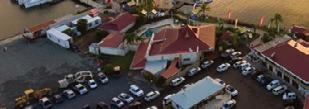


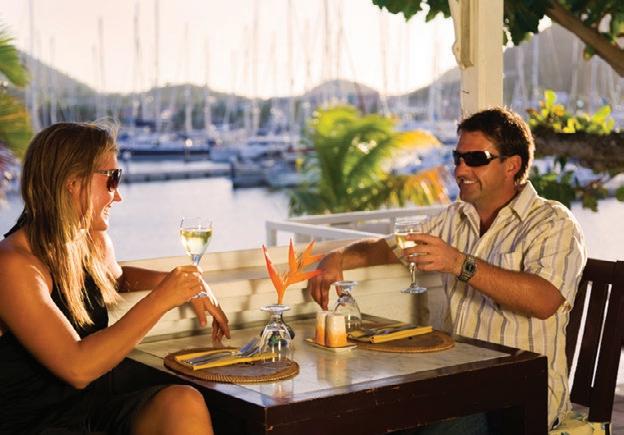
APRIL 20 23 CARIBBEAN COMPASS PAGE 23 Ask about our Summer Specials for Hurricane Storage! + 1 75 8 458 7200 / rbm@igymarinas.com Terms and conditions apply. Offers subject to availability for dates of stay through November 30, 2023 NEW REDUCED RATES! UP TO 50% OFF DOCKAGE LOWEST RATES IN THE SOUTHERN CARIBBEAN EVEN MORE SAVINGS ON LONG TERM DOCKAGE AND PRICE MATCH DEALS •Onsite marina amenities - pool, provisioners, parking, duty free shopping shops, bars, and restaurants •Easy airlift from most international hubs with weekly ferry service from Martinique •Full-service boatyard with long-term storage available •24-hour security & Onsite marina COVID testing AN UNRIVALED HOME FOR CRUISERS… ST. LUCIA
THE BEST OF CARIBBEAN CRUISING: PART ONE
THE TIMELESS DESTINATIONS OF PUERTO RICO AND THE VIRGINS
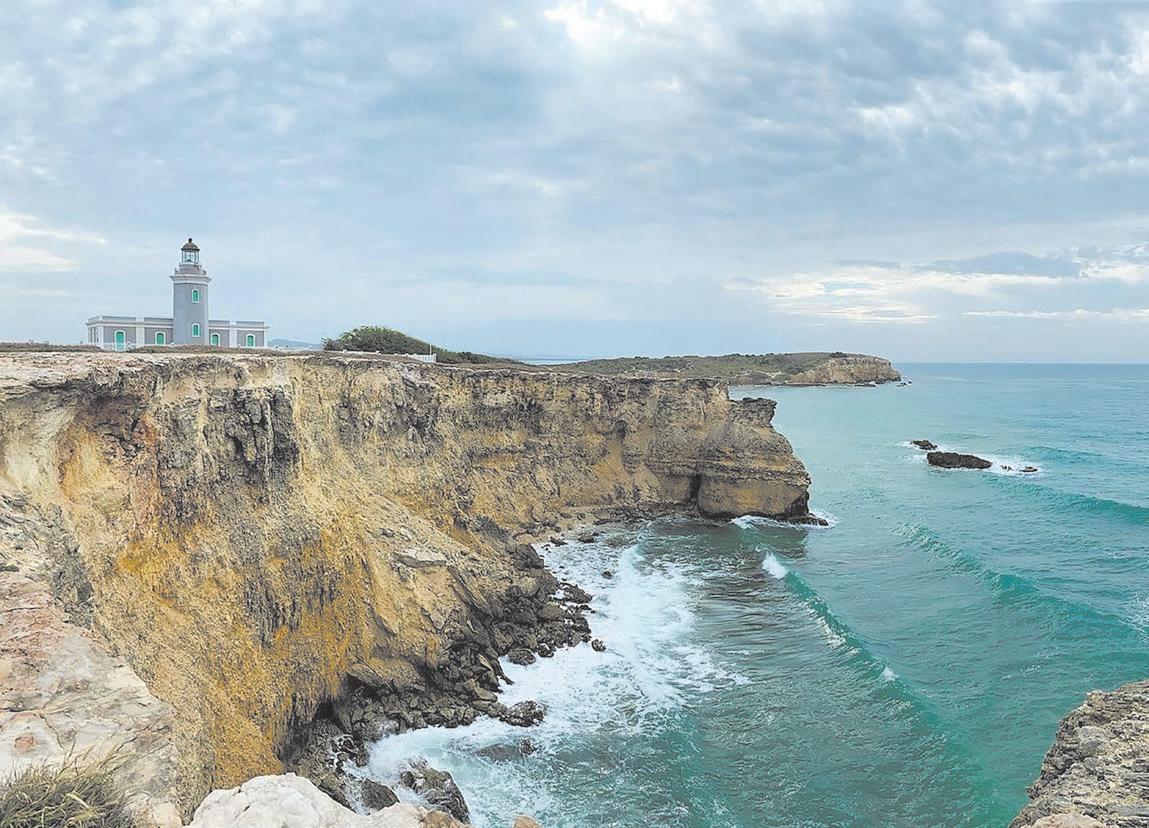
 Story by Todd Duff, Photos by Gayle Suhich
Story by Todd Duff, Photos by Gayle Suhich
My partner, Gayle, and I first arrived in the Caribbean in the early 1990s and what had started, for me at least, as a sabbatical cruise before returning to Annapolis and a life I’d created there turned into what has become a lifelong obsession with these beautiful islands, picturesque far-flung harbors, and warm, friendly people.
Comprising an area within the tropics of over one million square miles, the Caribbean basin encompasses 28 countries and many different cultural heritages. From the cosmopolitan French of Martinique and Guadeloupe and bustling San Juan to the indigenous people of Panama and the laidback islands of the Grenadines, and with historical sites in the multitudes from pre-Columbian times up through the colonial period, there is a lot to discover in the Caribbean — and there is no better way to see it all than from the deck of your own cruising yacht.
Having spent the better part of the last thirty years living aboard and sailing the Caribbean, east to west and north to south, I’ve found a few special destinations that, to me, epitomize some of the best aspects of this culturally diverse and geographically awe-inspiring region. Allow me to share a few of my favorite places that I’ve visited or lived in, and hopefully this may provide some inspiration to see all of these and more as you make your own voyages of discovery.
Most sailors arrive in this region from either Europe with initial landfalls in the Eastern Caribbean islands, or from North America making landfall in the Virgins or the Greater Antilles. I’ll start in the latter since this is where I have spent the greatest amount of time over the years.
Puerto Rico is an often-overlooked cruising destination, and this is a shame as it has so much to offer. An east to west cruise along the south coast could start from one of its better-known outlying islands, Culebra, which harbors one of the best anchorages in the whole of the Caribbean, but my favorite spot there is the tiny offshore island of Culebrita, home to a fantastic shallow reef along its southern point full of lobster and fish. Atop the highest point, with a commanding view to the south and east, you’ll find the ruins of the last Spanish lighthouse built in the Americas. Anchor in the lee of the island and there are a couple of trails which lead up to its crumbling yet architecturally impressive remains. The bravest sailors might try to climb the decaying ladder to the top of the lighthouse where the view to the east is quite spectacular. Along the south coast of Puerto Rico, you’ll find well-known hurricane holes and quaint villages tucked into pocket bays; my favorite is the little town of Salinas. When we first arrived there during the Christmas holidays in 1992 and anchored in the middle of the bay on one starry Saturday night, vibrant Latin music blared out from several surrounding bars packed with holiday revelers creating a chaotic cacophony of popular themes. Farther to the west, Isla Caja de Muertos offers a glimpse of the ultra-clear waters usually only found farther to the west in the Caymans or Belize while nearby Ponce provides great walking tours of the old historic district and ample shopping opportunities.
—Continued on next page
APRIL 20 23 CARIBBEAN COMPASS PAGE 24
The main pier at Boquerón, Puerto Rico
Lighthouse at Cabo Rojo, Puerto Rico
Continued from previous page
All the way on the western coast, the excellent harbor at Boquerón can be a fun stop with great dinghy exploration in the mangrove canals and is a popular weekend party place for locals while a few miles to the north, Puerto Real is a small yet popular yachting center with good facilities and is a great place from which to rent a car to explore the western interior and nearby Cabo Rojo, Puerto Rico’s rugged southwestern cape.
The Virgins
Back in the Virgins, most cruisers tend to avoid St. Thomas with its often-crowded harbor full of cruise ships and thousands of tourists, but the nearby islands off the southern and eastern coast offer a great escape and after midday are usually devoid of tourist boats. Just to the east, St. John has dozens of great anchorages, most of which are within the Virgin Islands National Park that covers approximately 60 percent of the island. While one must take a mooring ball when within the park, the price is reasonable, and the fees certainly help offset the costs of maintaining and preserving the natural beauty and historic sites within its borders. If you’re into hiking and snorkeling, St. John is a place you’ll want to visit for sure.
speckled beaches and vibrant party hotspots are something to experience at least once, if not again and again. And if you’re on a private vessel and the charter crowds are getting to be too much for you, there are several great anchorages within the archipelago where you will never see a bareboat charterer.
My favorite is South Sound on Virgin Gorda. The entrance is slightly daunting, with a large rock in the middle of the channel, but most cruisers who have sailed as far as the Caribbean will have no trouble entering this excellent harbor. Protected by a nearly continuous barrier reef and with six to eight-foot depths throughout, the swimming and snorkeling here are great, and it’s a nature preserve too, so you’ll see lots of sea life.
The BVI is of course perhaps best known for its popularity with the bareboat charter companies. The world’s largest fleets are based there, and the most populated island of Tortola was my home for quite a while. Unfortunately, the islands get a bad rap from reports of unfriendly officials and rigid, overbearing rule enforcements, but don’t let this put you off! As a whole, BVI islanders are among the friendliest of all the peoples I’ve met in my travels. The natural wonders, idyllic harbors, sun
While the BVI is world renowned for the Baths on Virgin Gorda, there are many other natural wonders throughout the Virgin Islands. This similar but smaller jumble of rocks on the western side of Beef Island has come to be known to some as the “Mini Baths.”

With dozens of protected harbors, the islands of the BVI and USVI offer amazing natural beauty and with great snorkeling, diving and lots of scenic hikes and scrambles, active sailors can stay busy. And because of the impressively long barrier reef extending south and east from the northernmost island of Anegada, along with a perfectly placed group of smaller islands to the south and east of the main islands of Tortola and Virgin Gorda, the waters from Virgin Gorda in the east all the way to St. Thomas in the west offer sheltered conditions from the Atlantic swells and the consistent, warm tradewinds provide some of the best sailing conditions to be found anywhere.

In part two of this series, we’ll sail east and south to visit the geographically striking and culturally diverse Leeward and Windward islands.

Todd Duff is the author of Bargain Boats and Budget Cruising and the action adventure Kidnapped from the Caribbean, available from www.seaworthy.com or anywhere books are sold.

APRIL 20 23 CARIBBEAN COMPASS PAGE 25
Trunk Bay, St. John, US Virgin Islands
Workboat Regatta Returns to Grand Anse Beach
Essay and Photos by Feli Gerlach
Fun, sun, dedication, and competition were in the air for the 2023 Grenada Workboat Regatta. After two years of keeping their feet (and boats) dry, both sailors and spectators were keen on bringing the festival back to its colourful glory, from the hectic final preparations of the boats in the morning until the last beer-drinking competition at the end of the day. With their bright sails and uniquely painted wooden boats, teams joined from all over Grenada. Different classes of boats were on the water: the smaller Catfish as well as the workboats including Woburn Traditional, Woburn Sports and the slender Gouyave workboat. All were equally challenged by the incoming swell and impatiently waited to be challenged by the breeze. Team Gouyave and Team Woburn were in tight competition, often reaching the final mark only a few seconds apart.
Two days of happiness, sunshine, music, ice-cold drinks, and a large, jovial crowd were a very welcome event for Grenada’s marvelous Grand Anse Beach. Participants and spectators alike are no doubt looking forward to next year’s Workboat Regatta.

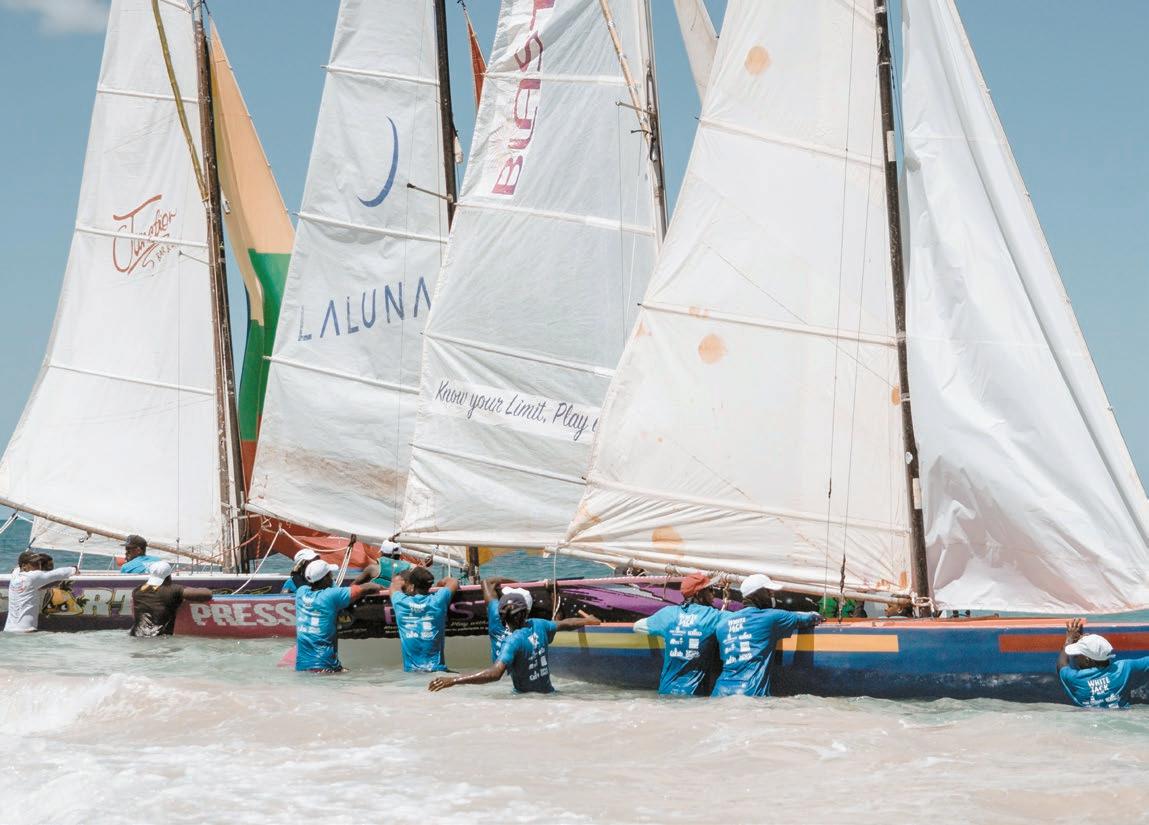
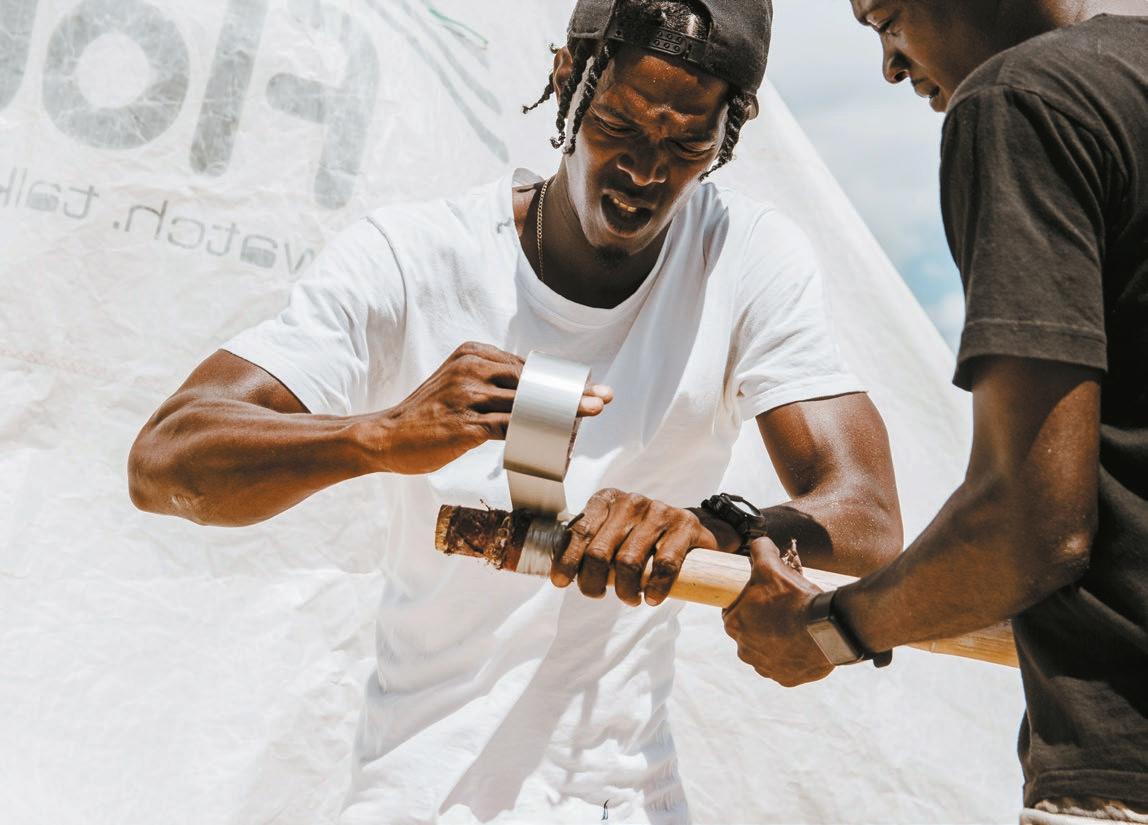

APRIL 20 23 CARIBBEAN COMPASS PAGE 26
Catfish beach start
Fixing up parts of the boom with gaffer tape
Workboat crews hold their boats in place for the start (left to right): Short Fuse, Press Play, Blast, Local.
Woburn Sports boats beat to windward.
... And Kids Get in on the Action, Too
Essay and Photos by Lexi Fisher
The Grenada Workboat Regatta Youth Sailing Event is a part of the Grenada Sailing Festival Heritage Work Boat Regatta, held this year on February 2-3. The event honors the working tradition of Grenada, and features traditional fishing boats from all over the island, competing in Le Mans style sailing race.
The junior event featured four Lasers, three Optimists, and six Mosquitos sailing multiple rounds to make sure everyone got a chance to race. Festivities included a beach party complete with barbecue, a local DJ, and traditional steel pan music.
The annual event is open to all of Grenada’s youth sailing programs and intends to attract participants from Carriacou and Grenada’s northern communities in the coming years.
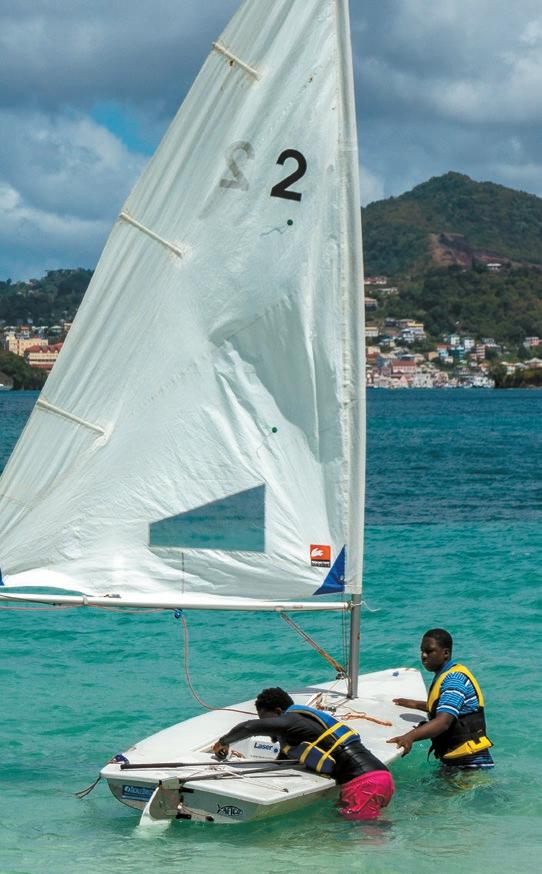
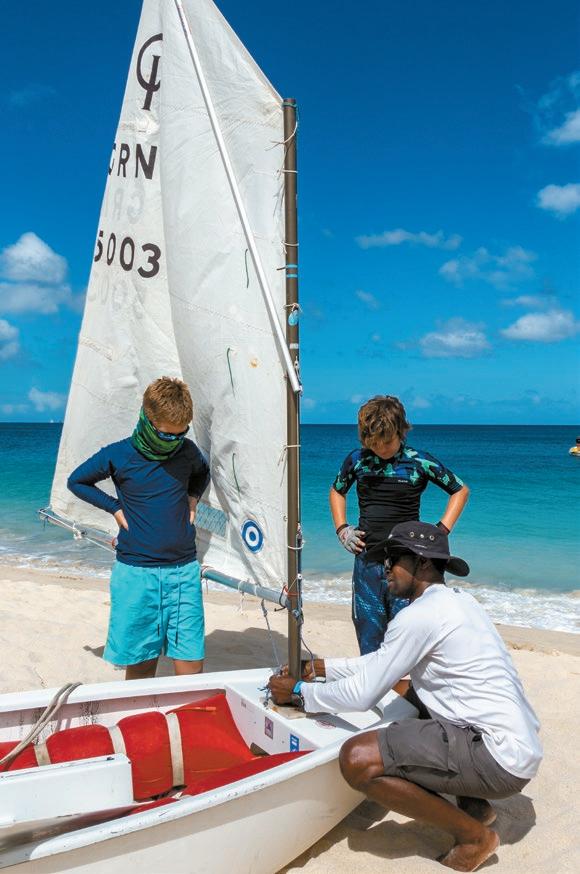
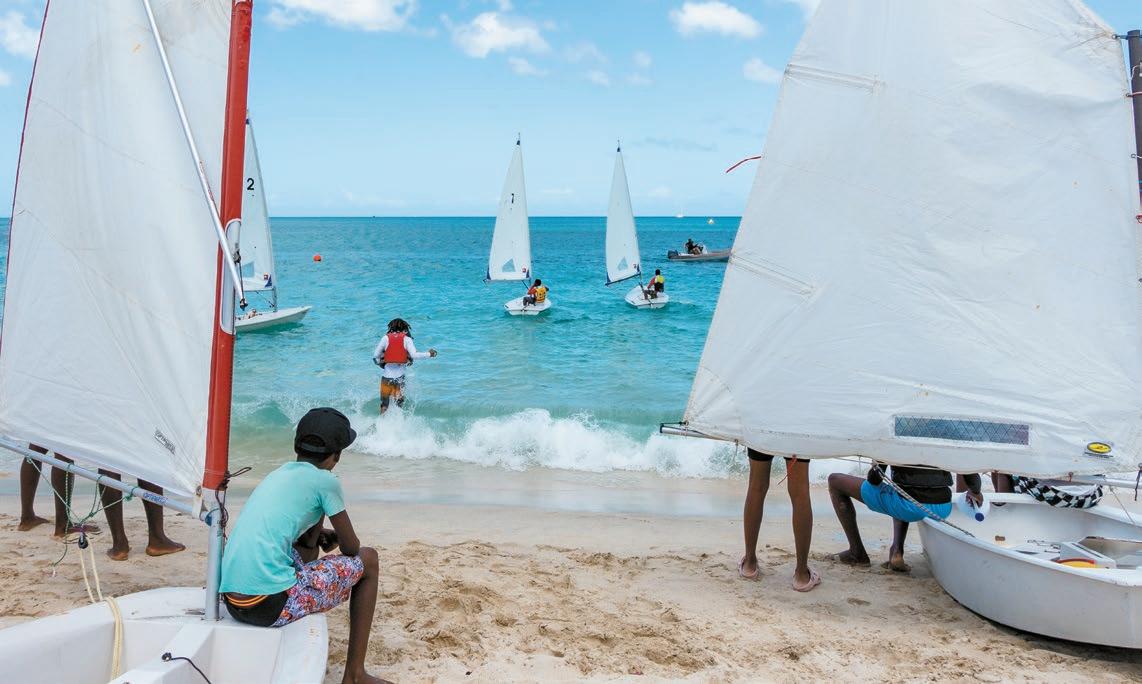
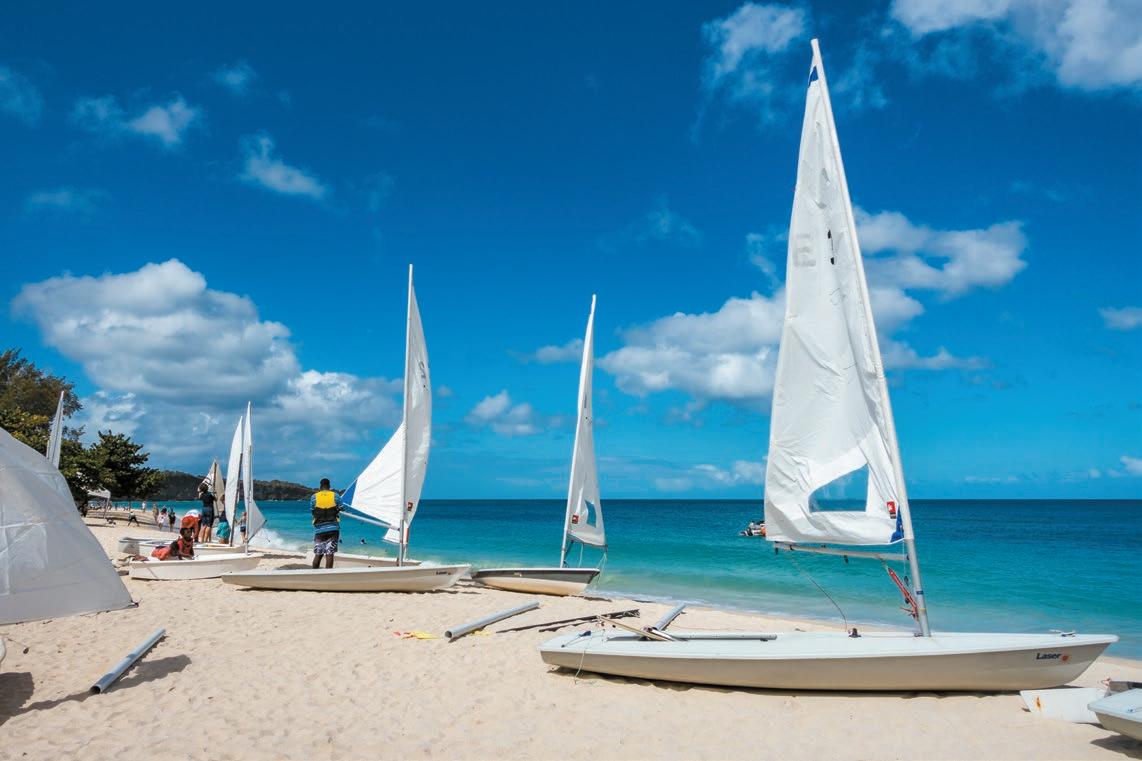

Top: Sails snap in the wind as Lasers sit on the beach, ready for the day’s fleet racing in a gusty 13-27 knot northeasterly.
Bottom: Optimists cross the finish line backed by the historic capital of St. George’s. The Grand Anse-based event gives youth a chance to gain experience in a new setting and race against new rivals.
APRIL 20 23 CARIBBEAN COMPASS PAGE 27
Around 30 youths from three of Grenada’s youth sailing programs: PCYC; the Woburn Wind Warriors; and the Gouyave Sailing School gather on Grand Anse Beach in the late morning.
Above, left: February 18: Petite Calivigny Yacht Club (PCYC) Commodore Richard St. John helps members of the Junior Sailing Program rig an Optimist for the collaborative event between the Grenada Workboat Regatta, PCYC, and the Grenada Sailing Association.
Above, right: Though Lasers were mostly popular with the older youth, the sailing program’s members range in age from 9 to 18.
A NEW LIFE FOR ELVIS FRANCOIS
by Elaine Lembo
Thanks to Heinz, we’ve heard plenty about the Ketchup Boat Guy. Back home on Dominica, especially in his village of Anse du Mé, 47-year-old Elvis Francois is also known as the down-and-out fisherman whose luck finally changed for the better. A lot better.
In late February, the Caribbean Compass caught up with a relaxed, refreshed Francois for a Zoom interview arranged through the island’s Emo News. Seated comfortably on a sunny porch, his state of wellbeing was a far cry from the dehydrated soul who was plucked from a dismasted sailboat to safety aboard a cargo ship after drifting solo more than three weeks across the Caribbean Sea.
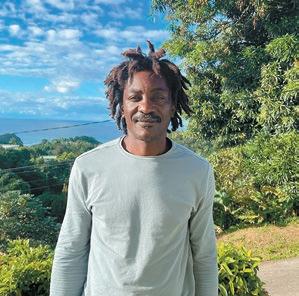
Upon rescue and medical examination by Colombian officials, Francois (now) famously uttered that he survived on ketchup, garlic powder, and Maggi bouillon cubes.
News that ketchup saved his life — sort of — ignited a viral social media storm, otherwise known as an impromptu corporate marketing campaign by behemoth Kraft Heinz, the American multinational food company.
The company’s mid-February search for Francois via Instagram reached 4.8 million people and garnered more than 4,000 likes – a brand record. It also helped Heinz, which in top-flight marketing gimmickry publicized its intention to buy Francois a new boat, get in touch with the news outlet, which then arranged for contact with the fisherman, who at that point had been safely returned to his island nation community. Media hordes — the BBC, Reuters, The Guardian, CNN, ABC, CBS, NBC among them — followed, interviewing Francois nonstop through early March 2023.
“After thousands of messages, hundreds of news stories, and countless leads, ELVIS HAS BEEN FOUND. Thank you, Internet, you helped #FINDTHEKETCHUPBOATGUY” declared Heinz’s marketing department via Instagram.
Accompanied by editor Kim Jospeh of Emo, Francois, who at press time was communicating with Heinz about his new boat, shared with the Compass what happened, how he survived, and how he got back home.
Living aboard the 35-foot monohull in St. Maarten after fire destroyed his home — twice — on Dominica, Francois had pushed off after dropping friends ashore. They were helping him work on the boat, whose problems ranged from a broken mast to a malfunctioning engine. It also leaked. Once the boat started to drift, Francois, more a powerboater than a sailor, lost cell service.
“I didn’t plan for this. It just happened.”
Hours turned into days, then, horrifically, weeks. Between bailing out the boat, ducking below to shield himself from the sun, trying unsuccessfully to catch fish, and straining the lone container of contaminated water aboard to make it potable, Francois waited for rescue. He rummaged around for supplies, which were spare – no VHF, no flares, no working battery, no fishing pole — just garlic powder, bouillon and ketchup.
CC: Did you plan on eating ketchup for 24 days?
EF: No.
CC: How did it taste?
EF: Well, good.
CC: Is ketchup high on your list of foods you will never eat again?
EF: No. I will keep on eating it. Because it is a good product.
Francois, who’s now about 20 pounds lighter thanks to the ordeal, says he enjoys using ketchup as a gravy with biscuits. He also enjoys bananas, and though he hasn’t participated in sports lately, plans to return to running and boxing when he’s not out catching fish. The father of three also hopes the notoriety he’s gained will shine a light on his community and Dominica in general.
“I feel great about it,” he says.
Watch an excerpt of the video interview with Francois on the Caribbean Compass Facebook page (www.facebook.com/caribbeancompassmag).
AT LAST!
• AFTER YEARS OF DEVELOPMENT, A TRAILER DESIGNED SPECIFICALLY TO HAUL CATAMARANS
• CRADLES CATAMARANS SECURELY AND GENTLY WITH INDIVIDUAL SLINGS UNDER EACH BOW
• NO INWARD SQUEEZING OF HULLS LIKE ON MARINE SLING HOISTS
• HYDRAULICALLY OPERATED AND INFINITELY ADJUSTABLE
• EASILY LIFTS CATAMARANS FROM 34 TO 60 FEET LOA WITH WEIGHTS UP TO 20 TONS
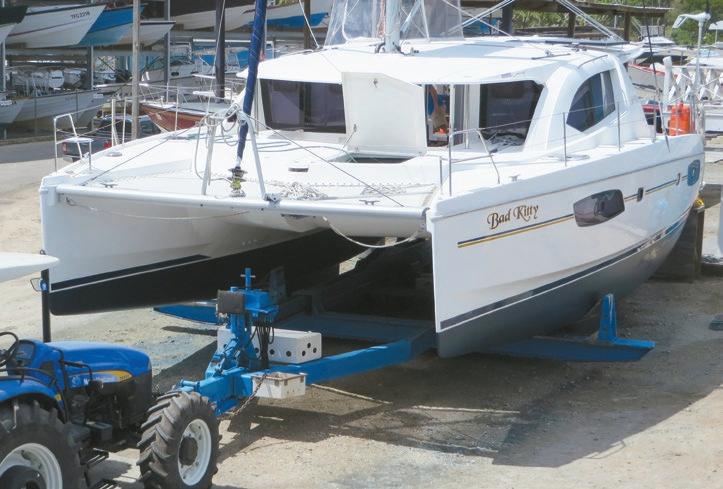
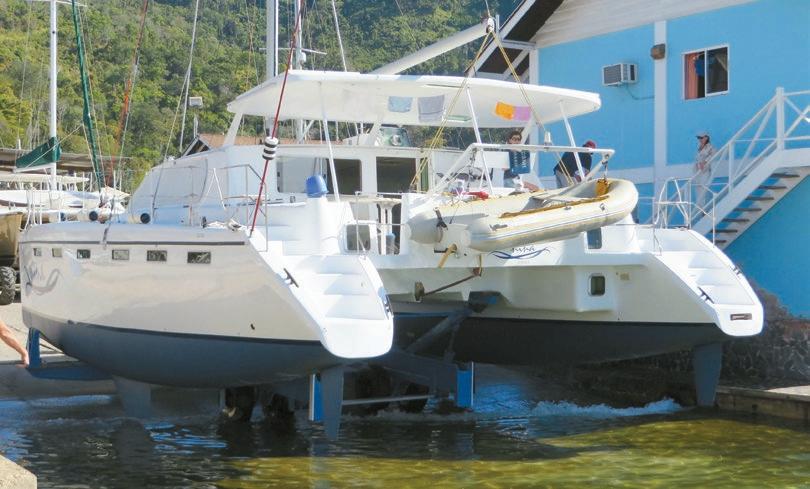

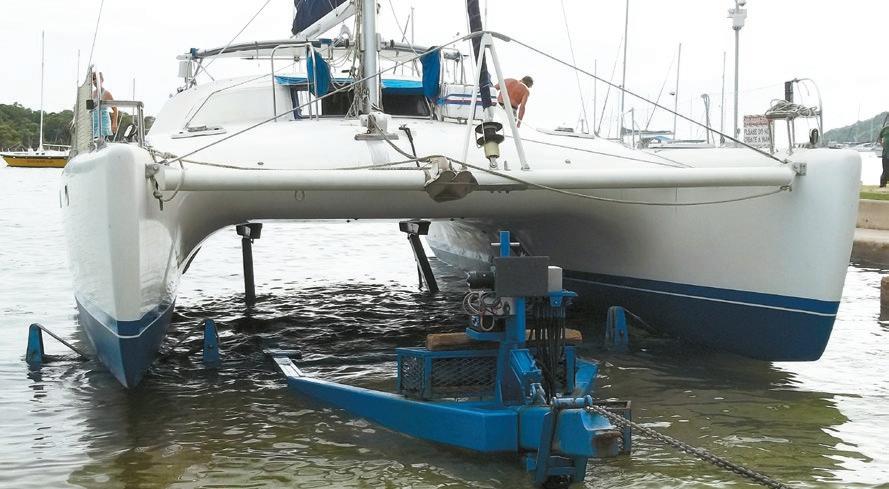
“Thistrailerlaunchedmycatamaran,TiKanot,in2002.Ithashauleduseveryyearsince.
Itisawonderfulandgentlewaytocomeuponland.” -Chris Doyle, Author of Caribbean Cruising Guides FOR A VERY COMPETITIVE QUOTE
PLEASE CONTACT:
POWER BOATS LTD
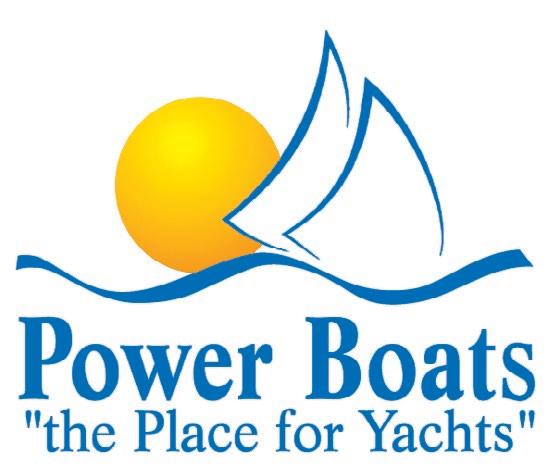
TRINIDAD
Tel: (868) 634-4303
Fax: (868) 634-4327
Whatsapp: (868) 327-4654
Email: pbmfl@powerboats.co.tt
Website: www.powerboats.co.tt
APRIL 20 23 CARIBBEAN COMPASS PAGE 28
PHOTO COURTESY EMO NEWS
5,000 NAUTICAL MILES AGAINST THE TRADES WITH AN ELECTRIC MOTOR
PART FIVE: CONVERSION COSTS
Story and Photos by Keith Dickey and Rebecca Frontz
often find ourselves having to sail onto anchor as the new bolts would bend or shear, no longer adequately holding the shafts together and rendering the use of the motor impossible. After numerous attempts to fix the issue in hopes we could still make the coupler work, it failed for the final time on the first night of our passage from Port Antonio, Jamaica to Bahia de las Aguilas, Dominican Republic. After the sun was set and Rebecca’s shift ended, she laid her head on the pillow and within a few minutes heard a loud thud. Keith immediately opened the hatch to the engine compartment and saw the bolts completely gone and the coupler unattached laying in three pieces. The boat shaft, being unattached, shifted approximately four inches aft, leaving only two inches of accessible shaft before it would be within the packing nut of a traditional stuffing box.
By pointing into the wind and slowing our speed, we managed to pull the shaft back into the boat. The goal then became to keep the boat shaft from spinning out of the back of the boat for the remainder of the passage. We removed the aft motor to have better access to the shaft and, over the next four days, used a series of hoseclamps, stainless steel seizing wire, and a pipe wrench to hold the shaft in the boat.
Our previous four articles in this series have highlighted the electric motor installation process, Vagari’s charging and discharging systems, and the electric motor’s characteristics. In this our final article, we will discuss the costs associated with converting to electric. We will break out the cost by system and note our thoughts on the trade-offs between cost, quality, and support when, not if, you have issues with your system. We believe it is absolutely critical to choose suppliers and original equipment manufacturers (OEMs) that will be willing to support you. As we step through each system, we will give several anecdotes highlighting this fact.
Of note, all costs below are related to the product and supplies. They do not take into account any labor as all installs and troubleshooting was done by ourselves. All prices shown are in USD. Also, we do not have any paid (or product) sponsorships. What follows are simply our thoughts based on our experience.
Electric Motor: $5,500
Our Electric Yacht 20kW QT was bought secondhand for $4,500 (including shipping). Electric Yacht currently sells these units for $9,500. The installation costs (including removal of the old engine) were approximately $1,000.
We are exceptionally happy with Electric Yacht. This is especially true since we did not buy the unit directly from them, but rather from a fellow cruiser. It’s clear they believe in their product and will support it throughout its lifetime. We’ve had a few instances of needing their help and they have never failed to come through with assistance.
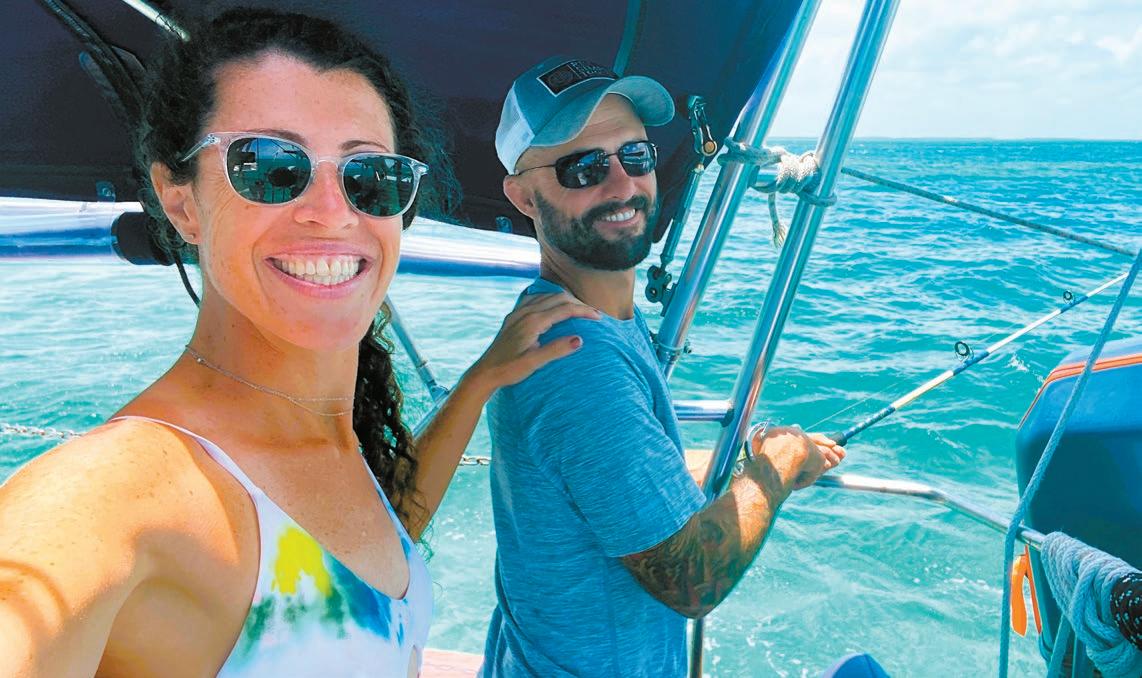
Initially, while installing the solar panels, we somehow managed to fry one of the electric motor controllers. Without hesitation, Electric Yacht considered the unit under warranty since it was new to us within the last year and replaced the controller at no cost. It was even express shipped.
After we dropped anchor in the very remote southwest corner of the Dominican Republic, Electric Yacht worked with us to assess which parts we would need, including a longer motor shaft and a more traditional coupling system. They shipped it all in a timely fashion to have it freight forwarded to the nearest town an hour away. They then kept in communication to help us disassemble and reassemble the motor pulleys to install the new longer shaft successfully.
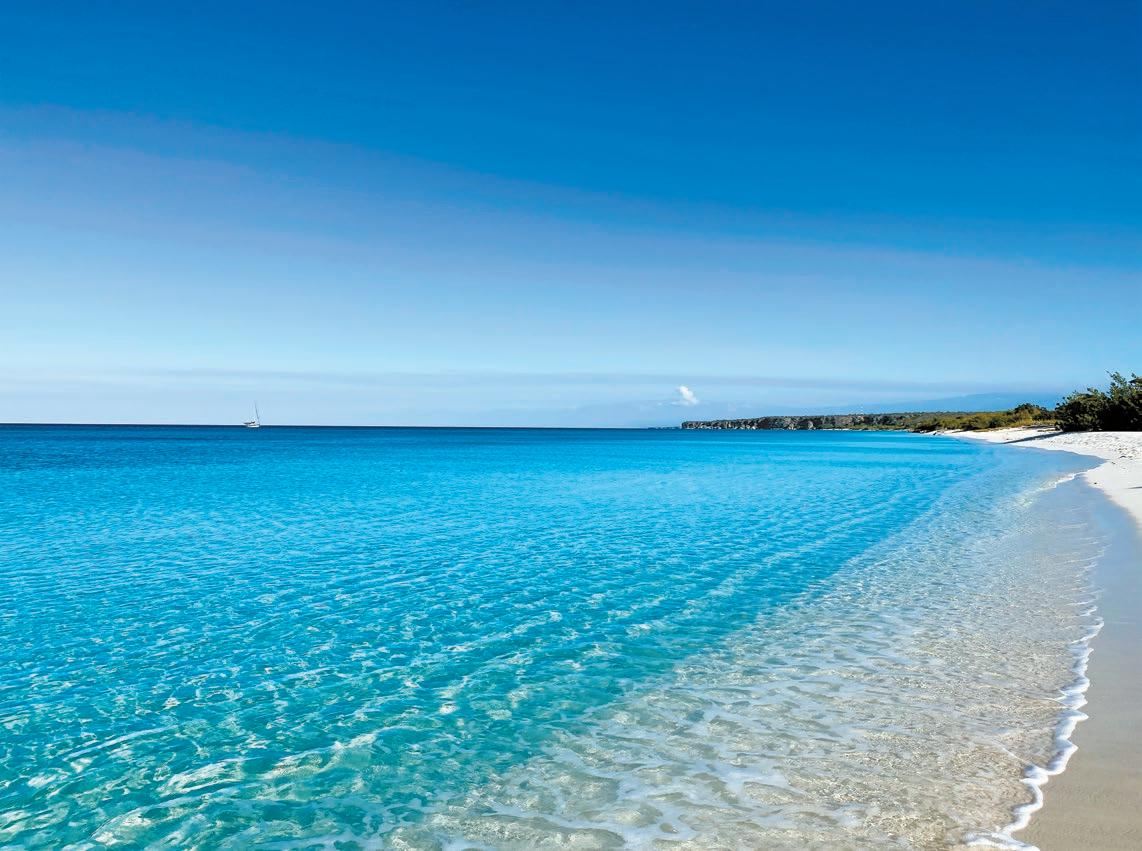
When we were sailing into the west coast of Jamaica, we managed to foul the prop with a rogue offshore fishing deep-line. This put sufficient stress on the unit to shear the bolts in our custom-made coupler. Unfortunately, it also damaged the coupler itself enough that it continued to be a problem throughout all of Jamaica. As we hopped along the north coast of the country, we would

They most recently went the extra mile by responding over the weekend and express shipping a new throttle. We had messaged while out sailing on a Saturday. When attempting to use the motor, the amp draw would jump around. We would go to increase the draw and it would intermittently decrease instead. They immediately helped us troubleshoot while still out on the water and determined it was the potentiometer on the throttle.
Batteries: $8,000
As mentioned in a previous article, we imported four 48v 100Ah LiFePO4 batteries, each with a self-contained BMS, directly from LiYuan Batteries, a manufacturer in China. The cost of the batteries themselves was about $6000 in total and approximately another $2,000 total to ship and import.
While the cost of these batteries has made them worthwhile, this is an example of the interplay between cost, quality, and support. The cost was about a third of what we would have paid for similar batteries in the USA at the time. However, the quality has been below average. Specifically, the batteries are 15 cell instead of the traditional 16 cell; one of the cells has already gone bad rendering the battery unusable as 48v, and the decay of the cells is faster than expected. The support from LiYuan has been less than helpful. As such, we have been forced to troubleshoot issues without support, resulting in poor outcomes on more than a few occasions.
—Continued on next page
APRIL 20 23 CARIBBEAN COMPASS PAGE 29
Enjoying the fruits of our labor
Cutting the prop free of the fishing line in Jamaica
Vagari in the remote southwest corner of the Dominican Republic without a working motor
Continued from previous page
To be fair to the OEM, these issues arose during the COVID pandemic, which greatly limited our abilities to communicate and problem solve together. The manufacturer offered a two year warranty, but logistically working directly with an overseas manufacturing company during the pandemic to discuss next steps or a warranty proved to be impossible. We wonder if the pandemic affected the quality of the product as well as the manufacturer’s ability to provide support. Either way, a learning point for us is, while we saved on cost, we forfeited on quality and support. We’ve made the best out of the situation and successfully converted the bad 48v 100Ah battery into a 12v 300Ah battery by rewiring the good cells and using a new 12v BMS.
Solar: $1,900
We initially purchased eight flexible 110watt panels direct from a supplier in China. The cost of panels and shipping was approximately $800. We were fortunate to also be gifted two 100-watt rigid panels from a friend before leaving for cruising. We then added two 400-watt rigid panels in Guatemala for $500.
Installation materials (wires, stainless frame, misc.) for all of the panels amounted to $200. Importantly, our install material price was rather inexpensive because we were able to use the boat’s existing archway and bimini frame as supports for the solar array. Additional costs included two Victron MPPTs 20/100 for $300 and a Genasun 12v to 48v boost MPPT for $100.
One of the great things about solar is that there are no moving parts and they nearly always function as expected. The flexible panels are about four years old and are showing their age as expected— flexible panels have a polymer surface, which becomes worn and scratched over time. But other than that we have no complaints. The ones we installed in Guatemala have half-cell technology, which helps with performance, and we have been pleased with this addition.
Wind Generator: $2,300
Our Primus Silent X 48v 400-watt wind generator with an internal regulator cost us $2,200. Given that our boat had an existing archway for a wind generator, it was mostly a plug-and-play installation that only cost us about $100 in additional materials.

We spent nearly twice the amount we normally would have due to an unfortunate situation of losing our wind generator in the mail. A component on the circuit board broke during a gusty day early on while we were still refitting our boat. The OEM asked us to mail back the wind generator for them to assess and repair the damage. Sadly, the wind generator never made it to them as it was lost in transit along the way. A lesson was learned to double-check for adequate insurance on a package when shipping expensive pieces of equipment. We were left with having to purchase a second unit from the OEM, though they were kind enough to include the upgraded silent blades at no cost. We have had one further issue since this time and Primus has had great customer support.
Generator: $9,000
After ample research, we bought a NextGen 5.5kW with full sound enclosure for $8,000 and the OEM recommended offshore spares kit for another $800. We did get the “boat show” price, which was a promotion they were running at the time of purchase. As Vagari had had a generator previously, some materials were able to be reused during the installation, saving us money. The total cost for the install materials was about $200.
Other than a single blown capacitor, which was our fault, we have had no issues with the generator. It is efficient at about 1/3 gallon per hour fuel usage and very quiet. We particularly sourced a two-cylinder unit as it is physically smaller than a three-cylinder, but runs at a lower RPM than a one-cylinder, which should extend its life. Customer service, even though we have needed very little support, has been excellent. To date, this system has the correct balance of quality, cost, and support.
Battery Chargers: $1,250
Our chargers consist of a 60 amp custom made 48v charger for which we paid $500, a 20 amp Genius 48v charger for $550, and a 48v to 12v Victron MPPT being used as a DC-to-DC charger for $200.
The Victron MPPT is being used outside of the OEMs use parameters, but is working nonetheless. The Genius charger, unfortunately, has not lived up to expectations. It was very pricey and produces about 75 percent of its stated output. The custom charger was made by Guangzhou Donglong Electric, an OEM found on Alibaba.com. The quality has been superb with the charger meeting its stated specifications. The support from the OEM was helpful as well when we reached out with questions during the initial install and use. The price was exceptional. This is an example that runs contrary to our experience with the batteries in terms of directly importing products.
Inverters/Converters: $500
We have a 3,000-watt / 6,000-watt Reliable Energy 48v to 110v inverter that we bought for $300 and we have a 48v to 12v 150amp Evergreen converter that costs $200.
"In total, our electric conversion cost us approximately $28,450. We worked to decrease our costs by thinking outside the box when obtaining parts and supplies, such as a secondhand electric motor, and by doing all of our own installs."

The converter is a back-up and has not been used, so we do not have much to say about it, but the inverter has been a very pleasant surprise. We purchased the inverter about 6 months into the pandemic and the exceptional price was reflective of an inventory glut. The support has been impressive as well. The initial remote control failed after about 1 month and they sent us a new remote for no charge right away. The quality has been great since then as it has not given us any issues while being used daily to power our galley appliances, hot water heater, and occasionally the air conditioner.
In total, our electric conversion cost us approximately $28,450. We worked to decrease our costs by thinking outside the box when obtaining parts and supplies, such as a secondhand electric motor, and by doing all of our own installs. We also saved massively in materials due to the existing archway, bimini frame, and davits. As we were refitting a boat that did not have any working ancillary systems, we needed to purchase all aspects of our conversion, such as a generator, which increased our overall costs. We think you could expect to spend approximately $40,000 on parts and supplies, depending on which pieces you need to complete the install. You could likely double that cost if you are paying for labor as well.
This article concludes our series on converting to an electric motor and our experience with it over the last 5,000 nautical miles against the trades from Texas to the Eastern Caribbean. Thank you for reading along and we hope you found some value in our story. We look forward to sharing our future electric motor adventures. As always, if you have any questions, please feel free to reach out to us at sail.vagari@gmail.com.

APRIL 20 23 CARIBBEAN COMPASS PAGE 30
Adding the wind generator to the existing archway
Installing the generator into aft cockpit locker
Additional solar panels being installed in Guatemala
More Than Just There

Book Review by Caitlin Richards

Flares Up: A Story Bigger Than the Atlantic, by Niamh McAnally, Pitch Publishing, Chichester, England; 2022. 408 pages. .
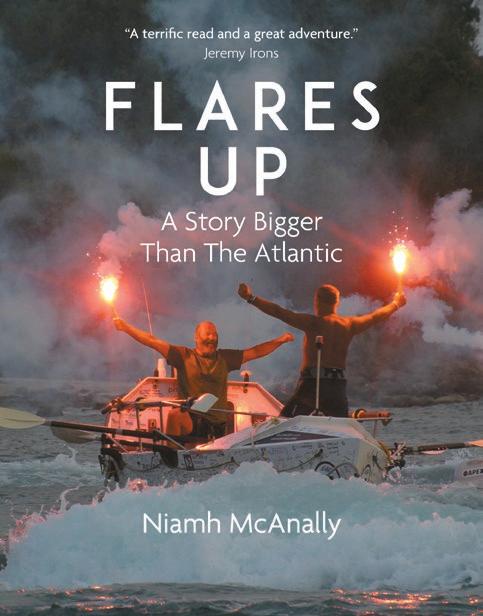
When asked why he wanted to climb Mt. Everest, Edmund Hillary responded “because it’s there.” In Flares Up: A Story Bigger Than the Atlantic, Niamh McAnally delves into why Paul Hopkins and Phil Pugh, two middle aged men with no seafaring experience, chose to row 3,000 miles across the Atlantic Ocean. “Because it’s there” would be a facile answer, and fortunately isn’t the one given by either man.

McAnally happened to “be in the right place at the right time with an open-minded intention — to capture a moment of glory for someone else.” In this case the two someone elses were people she didn’t know. She and her husband were finishing lunch on their boat at Nelson’s Dockyard in Antigua when they “noticed people walking towards a podium at the end of the dock,” and learned that Hopkins and Pugh were about to cross the finish line of their 3,000-mile row across the Atlantic. Taken with their story, McAnally wanted to write about it — but she didn’t want to write a how-to book about rowing the Atlantic, she wanted to know the why. If they would “dig deep to the emotional reasons of why” and “how it had impacted them and their families,” she was in.
Flares Up uses a dual narrative for the first half of the book, starting with Paul Hopkins, a 50-something, balding fireman in his third marriage. While recovering from a brain hemorrhage, Paul attends a sea survival training course where he meets a young man who is planning to row from New Castle to Amsterdam, a notion that worms its way into Paul’s head — but he wants something bolder. A Google search for “the world’s toughest row” takes him to the Talisker Whisky Atlantic Challenge. Paul thinks that if he can complete this row, he will be part of an elite group and can finally turn off the tape in his head telling him that he will never amount to anything.
Phil Pugh is introduced as he is getting ready to run a marathon with his three sons — he and two of the sons will be taking turns pushing the wheelchair of Tom, the third son, who has cerebral palsy. Phil, 60, is on his second marriage and has a 26-year-old debt to God that he is paying by “undertaking a new and strenuous challenge” each year for the next five years. The challenges need to be both “physically demanding and an adventure that Tom would love to do” if not confined to his chair.
In alternating chapters McAnally spools out the lives of the two men, their relationships with their wives, how they meet, and their struggles with financing, finding a boat, and training.
Part two joins the pair in their boat on their trip across the Atlantic.
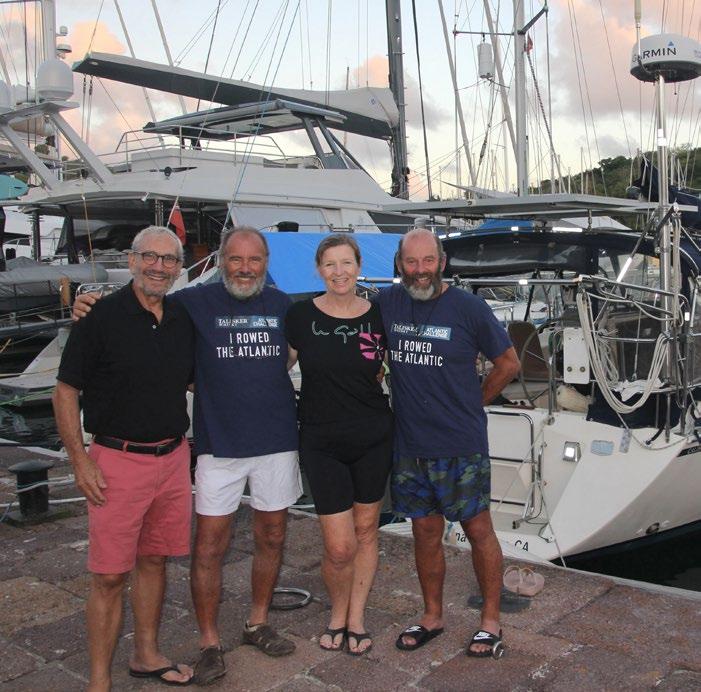
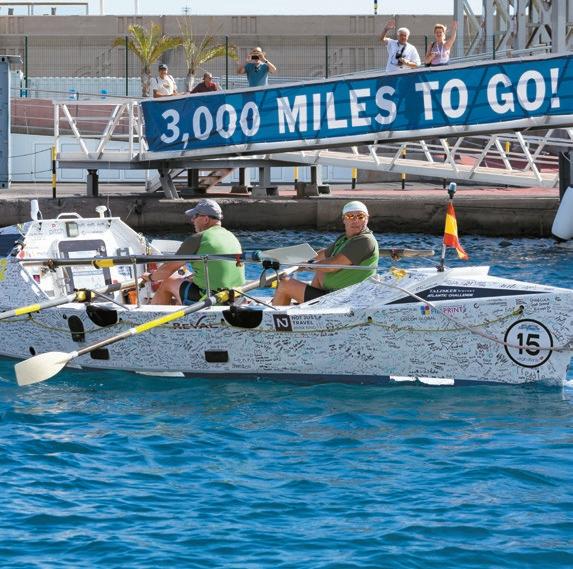

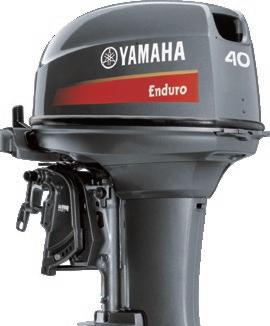



McAnally spent over two years doing extensive interviews with the two men, their wives, and their children, and doing research on everything from being a fireman to all that can be encompassed in ocean rowing, and it shows. Or rather, it doesn’t show, because her writing flows effortlessly.
McAnally’s use of the dual narrative and plenty of dialogue allows the reader to really know these two men and the women who share their lives. McAnally doesn’t try to hide their warts; while their achievement is impressive, the men are flawed. Their singleminded dedication to the project is not always admirable, coming as it does at the cost of their relationships with their wives, children, friends, and health. Yet McAnally’s storytelling is so full and wellrounded that the reader is always cheering for Paul and Phil and feels as though they are on the boat with them, and at the end, wishes they were on that dock in Antigua.

APRIL 20 23 CARIBBEAN COMPASS PAGE 31
HEY, READERS! Visit our website at caribbeancompass.com or just scan the QR code BELOW and enter your email address — it’s as easy as that! McINTYRE BROS. LTD. True Blue, St George’s Grenada Call 1 (473) 444 3944 macford@spiceisle.com Honda, Mazda and Ford Dealership Vehicle Sales & Service Book your Car rentals & Island Tours with us Discover Grenada with Caribbean Horizons Tours & Services info@caribbeanhorizons.com www.caribbeanhorizons.com 2 & 4-Stroke Engines Genuine Parts & Service Yamaha Certified Technicians Duty free deliveries & reliable service for Yachts GRENADA Need Crew? Want to Crew? Experienced Crew Available for short deliveries or long offshore passages. Crew requests are free. For 25 Years, US Leading Crew Network. Offshore Passage Opportunities SailOPO.com
Actor Jeremy Irons, who wrote the book’s foreword, and author Niamh McAnally, pose with copies of the book.
Departure
Gary (Niamh’s husband), Phil, Niamh, Paul
PHOTO BY PHOTOCALL IRELAND
PHOTO COURTESY ATLANTIC CAMPAIGNS
PHOTO COURTESY NIAMH McANALLY
CALENDAR
APRIL 2023
5 – 8 Oyster Regatta, Antigua. oysteryachts.com/events/antigua-regatta
6 FULL MOON

5 – 10 Bequia Easter Regatta. www.bequiaregatta.com
7 Public holiday in many places (Good Friday)
9 Easter Sunday
10 Public holiday in some places (Easter Monday)
12 – 18 Jamaica Carnival www.socaislands.com
14 – 16 St. Croix International Regatta. www.stcroixyc.com
15 Atlantic Crossing Seminar, Island Water World, St. Maarten
16 – 22 Les Voiles de St Barth. www.lesvoilesdestbarthrichardmille.com
18 Public holiday in Puerto Rico (Birthday of José de Diego)
19 – 24 Antigua Classic Yacht Regatta. www.antiguaclassics.com
20 - 24 Tobago Jazz Experience
22 Earth Day
22 Public holiday in Trinidad & Tobago (Eid ul-Fitr, end of Ramadan)
27 Public holiday in St. Maarten and Bonaire (King’s Day)
28 Public holiday in Barbados (National Heroes’ Day)
30 Public holiday in Bonaire (Rincon Day)
29 Peters & May Round Antigua Race. www.sailingweek.com
30 Jazz’n’Creole event, Dominica.www.dominicafestivals.com
30 – 5 May Antigua Sailing Week. www.sailingweek.com
TBA St. Barth Theatre Festival. www.festivaldetheatredesaintbarthelemy.com
TBA Governor’s Cup Race, BVI. www.royalbviyc.org
TBA Start of Salty Dawg Rally, USVI to US East Coast. www.saltydawgsailing.org
TBA West Indies Regatta, St. Barth. westindiesregatta.com
MAY 2023
1 Public holiday in many places (Labour Day)
1 – 3 St. Maarten Carnival. www.facebook.com/sxmcarnival
5 – 14 St. Lucia Jazz Festival. www.stlucia.org
5 FULL MOON
5 Cayman Islands Carnival (Batabano)
6 Start of ARC Europe rally from St. Maarten to Portugal via Bermuda. www.worldcruising.com/arc_europe
9 Antigua to Bermuda Race. www.sailingweek.com
11 – 14 Martinique Boat Show. www.martinique-boat-show.fr
12 BVI Dinghy Championship. www.royalbviyc.org
12 – 13 BVI Spring Charter Show. www.crewedyachtsbvi.com/charter-yacht-shows
16 Public holiday in the Cayman Islands (Discovery Day)
16 Start of Windward 500 Races. skern@oneenergyisland.com
17 - 21 Grenada Chocolate Festival. www.grenadachocolatefest.com
18 Public holiday in Aruba, Bonaire, Curaçao and St. Maarten (Ascension Day)
19 STYC Invitational Regatta, St. Thomas. stthomasyachtclub.org
26 - 29 Petite Martinique Whitsuntide Regatta. www.facebook.com/petitemartinique.whitsuntidereggatta
27 – 26 Foxy’s Wooden Boat Regatta, Jost Van Dyke, BVI. www.westendyachtclubbvi.com
29 Public holiday in Puerto Rico and USVI (Memorial Day)
29 Public holiday in some places (Whit Monday)
30 Public holiday in Trinidad & Tobago (Indian Arrival Day) and in Anguilla (Anguilla Day)
TBA Barbuda Carnival, ‘Caribana’
TBA Anguilla Regatta. ivisitanguilla.com/festivals-and-events
All information was correct to the best of our knowledge at the time this issue of Compass went to press — but plans change, so please contact event organizers directly for confirmation.
If you organize a sailing or boating event not listed here that you’d like to have included in our monthly calendars, please send information two months before the event date(s) to editor@caribbeancompass.com
PICK UP!
ST. VINCENT
Barefoot Yacht Charters
Blue Lagoon Hotel & Marina
Gonsalves Liquors
BEQUIA
Bequia Tourism Assn.
Bequia Venture Co. Ltd
Customs & Immigration/Post Office
Dockside Marine
Lulley’s Tackle
Grenadines Sails
Porthole Restaurant
Mac’s Pizzeria
Piper Marine
UNION ISLAND
Bougainvilla
Captain Gourmet/Happy Kite
Clifton Beach Hotel
Grenadines Dive
L’Atelier Turquoise Gallery
Union Island Tourism Office
Determination Bar
Tipsy Turtle
MERIDIAN PASSAGE OF THE MOON
APRIL & MAY 2023
Water generally tries to run toward the moon. The flood tide starts running eastward soon after moonrise, continues to run east until about an hour after the moon reaches its zenith (see TIME below) and then ebbs westward. From just after the moon’s setting to just after its nadir, the tide runs eastward; and from just after its nadir to soon after its rising, the tide runs westward. The first hour after moonrise, the westerly current is barely negated. The second hour the flood tide is stronger, the third and fourth hour it’s strongest, then it eases off in the fifth and sixth hours. The maximum tide is three or four days after the new and full moons.
APRIL 20 23 CARIBBEAN COMPASS PAGE 32
Crossing the channels between Eastern Caribbean islands, an ebb tide carries you off to leeward and a strong flood tide creates lumpy seas, so crossing with a favorable tide is faster and more comfortable. The table below, showing the local time of the meridian passage (or zenith) of the moon for this month, will help you calculate the tides.
April 2023 DATE TIME 1 2109 2 2152 3 2234 4 2315 5 2357 6 0000 FULL MOON 7 0041 8 0127 9 0216 10 0311 11 0409 12 0510 13 0611 14 0711 15 0808 16 0901 17 0951 18 1039 19 1127 20 1215 21 1305 22 1356 23 1449 24 1543 25 1636 26 1728 27 1817 28 1903 29 1947 30 2029 May 2023 1 2110 2 2152 3 2234 4 2320 5 0000 FULL MOON 6 0009 7 0103 8 0201 9 0303 10 0405 11 0506 12 0604 13 0657 14 0747 15 0835 16 0921 17 1008 18 1056 19 1146 20 1238 21 1332 22 1426 23 1518 24 1609 25 1656 26 1741 27 1824 28 1905 29 1945 30 2027 31 2111
Ahoy, Compass readers! When in St. Vincent & the Grenadines, pick up your copy of the Caribbean Compass at these locations (our advertisers in this issue in bold):
Mid-April to Mid-May
Story
and
Photos by Jim Ulik
The Sun continues to appear higher in the northern sky as the days continue to pass since the spring equinox. That will provide the northern hemisphere with an increased capacity for the production of free energy. Of course, that is after the costs of batteries and solar panels are subtracted. Changing the angle of the panels towards the Sun throughout the day is helpful if you have nothing else to do. Directing the panels 90 degrees up on a shifting boat is one compromise. The Sun during this period will be directly over 10 degrees north latitude on April 16. It will gradually shift to its position over 19 degrees north latitude by May 15.
Sunday, April 16
Look for the close approach between the Moon and Saturn in the pre-dawn sky. Saturn rises in the east southeast around 0300h. In another 15 minutes the Moon will emerge above the horizon. Both objects will reside in Aquarius.
Monday, April 17
The Moon has shifted position eastward leaving Aquarius and Saturn behind. It has now reached its closest point to the Sun. Even though it is less than ten percent illuminated it is still the brightest object in the dawn sky.
Venus also reaches its closest point to the Sun. Venus will continue to brighten in the western sky, finally reaching its peak intensity on July 11. Whether close to or at it farthest point from the Sun, Venus’ mean temperature is 867°F (464°C). The planet remains hot due to its dense atmosphere and clouds creating the “perfect” environment for the greenhouse effect. Venus atmosphere consists of high levels of carbon dioxide trapping the heat radiated off its surface.
Thursday, April 20
The Moon is located on the same side of the Earth as the Sun today. This is the best time of the month to observe faint objects such as galaxies and star clusters because there is no moonlight to interfere. Better still, escape to a location that is not filled with the light pollution from a harbor, city or boat yard.
There will be notifications or posts about today’s solar eclipse. However, it will not be visible in the Caribbean Basin. The partial eclipse will only be visible throughout most of Indonesia and Australia.
Friday, April 21
A clear view of the western horizon is required to see the conjunction between Mercury and the Moon. Mercury will come into view about 25 minutes after sunset when it is about five degrees above the horizon. Mercury will drop below the horizon at 1915h. The Moon will set 45 minutes later.
Saturday, April 22
Today is Earth Day.
The Moon continues its apparent eastern movement across the sky. Having left yesterday’s position near Mercury the Moon is now sitting between Venus and Pleiades this evening. Looking towards the upper left of the Moon is the red giant star Aldebaran.
The Lyrids meteor shower produces about 20 meteors per hour at its peak. It is produced by dust particles left behind by comet C/1861 G1 Thatcher, which was discovered in 1861. The Lyrids is active April 13 to April 30. Shooting stars will radiate out of the sky from an area above or west of the constellation Lyra. A few meteors may be seen after 2200h (See Image 1) but, the best viewing will be from a dark location after midnight.

Friday, May 5
Looking forward to a Full Moon Party? Tonight is that night! The Moon is situated in Libra and located on the opposite side of the Earth as the Sun. You may have seen a notice about a lunar eclipse. The lunar eclipse occurring tonight will only be visible throughout Asia and Australia and parts of Eastern Europe and eastern Africa.
Sunday, April 23
The Moon has returned to Venus. Actually its closest approach to Venus is approximately 0700 when both are just below the eastern horizon. It won’t be until after sunset that the Waxing Crescent Moon can be seen sharing the western sky with Venus.
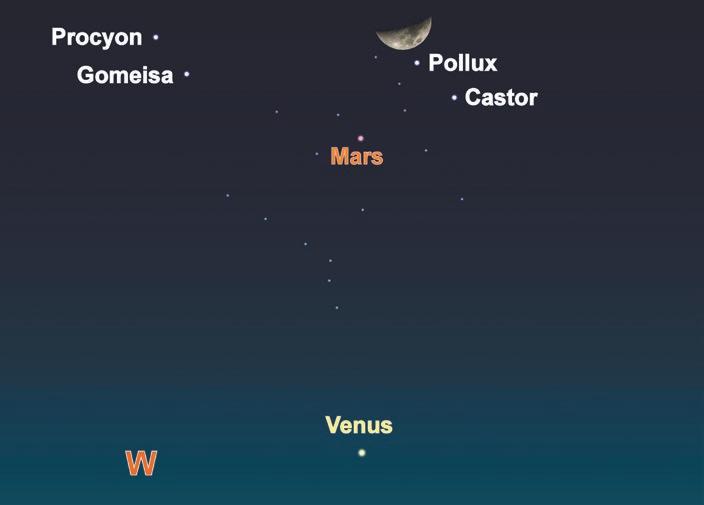
Monday, April 24
The pi Puppids meteor shower (See Image 2) will peak tonight radiating out of the southern constellation Puppis. This variable shower can produce up to 40 meteors per hour. The shower is associated with the debris field left behind from comet 26P/Grigg-Skjellerup. Earth will pass through its remnants April 14 – April 28.
We are all travelling through space aboard planet Earth. But one can only be called an astronaut when they cross the Kármán Line, an imaginary boundary 100 kilometers (62 miles) above mean sea level. In 1961, Alan Shepard reached an altitude of 116 miles aboard Freedom 7. Today is National Astronaut Day commemorating the first American in space.
Saturday, May 06
After midnight a few meteors will radiate out of the eastern sky. The eta Aquariids meteor shower peaks overnight. This shower may produce up to 30 meteors per hour. It is active April 18 – May 27. The point of origin is in the constellation Aquarius. Saturn will be located just south of that point this year. If you stay awake until dawn you will see Jupiter rising around 0500.

When the Moon rises in the evening it will be caught in the claws of the scorpion. Scorpius will maintain its hold on the Moon throughout the night keeping it very close to the scorpion’s heart, Antares.
Wednesday, April 26
The Moon has exited Gemini but remains close to the constellation’s brightest star Pollux. The twin brother Castor is located toward the northwest. This is a good time to use the Moon to identify the stars signifying the sons of Zeus. Don’t confuse the twins with the nearby stars Procyon and Gomeisa that closely parallel them. Those are two of the major stars in the constellation Canis Minor (see Image 3).
Friday, April 27
The Moon has reached First Quarter and makes a close approach to the Beehive Cluster in Cancer. Follow the terminator or line separating the light and dark side of the Moon about three degrees southwest to find the cluster of 1,000 suns. Stars are suns.
The first Friday in May is National Space Day. In 1997, Lockheed Martin Corporation created National Space Day as a one-day event. In 2001, due to its extreme popularity, former astronaut and Senator John Glenn expanded Space Day to International Space Day. This was done to identify the extraordinary achievements, benefits, and opportunities in the exploration and use of space. The goal of the observance is to promote science, technology, engineering and math education (STEM) in young people. The hope is to inspire them to pursue a career in science, especially a career in space-related jobs.
Saturday, May 13
It is one day after the last quarter Moon. Twenty seven nights ago the Moon appeared in the same general location as it is now. That puts the Moon in another close approach to Saturn.
*All times are given as Atlantic Standard Time (AST) unless otherwise noted. The times are based on a viewing position in Grenada and may vary by only a few minutes in different Caribbean locations.
APRIL 20 23 CARIBBEAN COMPASS PAGE 33
Jim Ulik sails aboard S/V Merengue.
THE CARIBBEAN SKY: FREE SHOW NIGHTLY!
Image 1: The radiant of the Lyrids meteor shower on April 22 at 2200h
Image 2: The pi Puppids meteor shower and its source the comet 26P/Grigg-Skjellerup on April 23 at 1900h
Image 3: The Moon and Pollux in the constellation Gemini on April 26 at 1930h
Dirty Mas and Pretty Mas – two faces of Trinidad Carnival
 Story and Photos by Christine Gooch
Story and Photos by Christine Gooch
It is 4 a.m. on Carnival Monday. Music blares out at deafening volume from a 40-foot articulated truck piled high with speakers, the bass thudding in our chests. We are packed closely together in a crowd of 1,500-2,000 people, marching in place to the tribal beat, unable to move forward until the others surrounding us do. All of us are wearing bright yellow T-shirts and waiting expectantly for the party to begin. We are the JumBeez and this is J’ouvert!

J’ouvert (pronounced “Joovay”) is a lively procession through the streets of Trinidad’s capital, Port of Spain, starting roughly two hours before dawn and ending around an hour after sunrise. As well as the speaker truck, there are two trucks loaded with alcohol, one full of portable toilets, and an airconditioned bus for those who get too tired or too drunk to carry on. It’s a far cry from the last time we did J’ouvert, many years ago, when answering the call of nature meant squatting down at the side of the road, and if you got tired you hitched a lift on the beer trailer towed behind a tractor.
Suddenly the trucks and the crowd start to move, inching forward in time to the music — we’re off! We fight our way through to one of the bars, holding our bright yellow go cups aloft for them to be filled. Normally rum and coke is a splash of rum and a lot of Coke. This seems to be the reverse: the cup is almost three quarters filled with rum, followed by a dash of Coke — crikey!

We are soon reminded why J’ouvert is also known as Dirty Mas. A small tanker full of paint in assorted colours begins to spray us, while revelers grab plastic ketchup bottles, whirling them above their heads to spray yet more paint over those nearby. Soon we are covered all over — arms, legs, faces, hair, T-shirts streaked in rainbow colours. We look at each other and burst out laughing — this is fun! There are other groups besides the JumBeez, taking different routes through the city. Some cover themselves in mud, others liquid chocolate — a relatively new idea but one that greatly appealed me, a confirmed chocaholic.
This is the first carnival in two years, due to the Covid-19 pandemic, and people are certainly enjoying themselves. I fail miserably to copy the dancing Trini girls’ gyrating hips, and for the first time I fully understand the phrase “shake your booty” as they tease the men, thong-clad buttocks rippling
As the sky gradually lightens, turning from black to pale grey and peach and finally bright blue, we make our way to the Soca Drome, a sports stadium on the edge of town, where we rejoin the other masqueraders (Mas is short for masquerader). Each group in turn crosses a long stage (which in typical Caribbean style was still being constructed when we left at 4 a.m.). Then it’s all over, we make our way back to the bus that will take us and the other cruisers who have played Mas back to the boatyards at Chaguaramas, where we shower the paint off our hair and skin (the T-shirts are beyond redemption), and tumble into bed to catch up on our sleep.
6 a.m. on Carnival Tuesday (otherwise known as Mardi Gras or Shrove Tuesday), sees us on the bus again heading back into Port of Spain for the Carnival Parade. We manage to get seats in the shade in an enclosure overlooking Ariapita Avenue, close to one of the judging points. We are grateful for this as it will be a long day; the parade is due to start at 8 a.m. and will probably go on into the night.
—Continued on next page
APRIL 20 23 CARIBBEAN COMPASS PAGE 34
suggestively. “Show me, show me, show me yuh hands” goes the song, and dutifully the crowd raise their hands in the air, cups aloft, feet shuffling forward, smiles wide.
Carnival paraders with gauzy butterfly wings
CARIBBEAN LIVES
J’ouvert: before J’ouvert: after
Continued from previous page
In fact, the first group doesn’t pass us until after 9 a.m. and they come in fits and starts for the rest of the day. The carnival parade is appropriately known as Pretty Mas. The costumes are glorious collections of feathers, sequins, spangles of all shapes and sizes, with often a tiny amount of fabric to keep the whole thing together and preserve the wearer’s modesty. The feathers are used in towering headdresses, or fanning out on either side of the wearer like enormous wings. They can be relatively subdued plain brown and black pheasants; beautiful iridescent turquoise, electric blue and pale green peacocks, or dyed candy colours — pinks, yellows, bright greens or blues. Sequins and spangles in every size, shape and colour are fashioned into necklaces and garters, or cover almost every inch of the fabric. Tiny seed pearls, squares, diamonds, spheres, huge lozenges, all glinting in the light. Anyone can hire a costume and join a Mas Camp, paying anything from TT$4,000 (just under US$600) to TT$17,000 (US$2,500) for the more elaborate costumes. Each costume takes about two days to make and a group can number up to 1,000 people, so there is a lot of work involved in costuming a Pretty Mas.
Instead of feathers, some groups have wings made of light gauzy material that flutter in the breeze as the wearers dance and twirl their way past the stand. Each group is accompanied by at least one, sometimes more, 40-foot trucks loaded with speakers. One group is like naughty schoolchildren; their leader keeps turning the music off and shouting “Get in yuh sections, get in yuh sections!” as they approach the judging point. What he means is that they should be lined up to show off to the best effect as they pass the judging point, similar design costumes and the same colours together. However, they are all mixed up together, with the leader desperately trying to impose some order.
The most elaborate costumes belong to the Kings and Queens. They can be 30-40 feet high and 30-40 feet wide, and are so heavy they are on wheels. Not many groups in Tuesday’s parade have a King or Queen at their head, but we do see a couple; a giant three-headed scarlet ibis covered in sparkling sequins, and a black and white crayfish (at least I think that’s what it was).

Several times during the day I leave the stand to go down onto the street, where there is more atmosphere. As the giant scarlet ibis spins past, moving from side to side of the road on its wheels, the lady operating it dwarfed by her costume, spectators step back to avoid the flailing starbursts of feathers and the sharp beaks that overhang the pavement.
All too soon it is time to head home, the biggest party of the year is over, but preparations for the next one will shortly begin.
Thanks to Jesse James, Members Only Maxi Taxi and Tours and YSATT, for organizing some great Carnival trips, and to our fellow cruisers who joined us in having fun.

APRIL 20 23 CARIBBEAN COMPASS PAGE 35
Carnival queen dwarfed by her costume
Rick Palm 1945 – 2023
“A Good Guy”
by Julie Palm
Richard Victor “Rick” Palm died on February 28, 2023, at his home in Hardyville, Virginia. His friends and family remember him for his spirit of adventure and his dedication to “giving back” to those who shared his passions. They were many, but ocean sailing and woodworking top the list. He believed strongly in experiential learning, and he sought to leave his legacy to programs that encourage kids to learn with their hands.
His epitaph was unknowingly created by his grandson Owen years ago at age three, when he earnestly confided in his father, saying. “Grandpa Rick’s a good guy.” Out of the mouth of babes!

This good guy was born near Halifax, Nova Scotia, in 1945, in what was then known as a “foundling home.” His birth name was Rayburn Hoddinut; his birth mother was from Newfoundland. At six months old, he was adopted and renamed by Victor and Pansy Palm from Brooklyn, New York. He became a US citizen in high school and lived in Brooklyn until he enlisted in the Air Force in 1967. A highlight of his childhood was the family’s annual summer vacation in New London, Connecticut, where he learned to sail.
His sailing adventures spanned over 50 years and took Rick and his wife, Julie, around the world, across the Atlantic twice, to and from the Caribbean a dozen times, and up and down the coast of North America from Nova Scotia to the Keys. He relished nothing more than helping coastal sailors prepare for their first offshore passages, both with the Caribbean 1500 and the Salty Dawg Sailing Association. He was honored to receive a lifetime achievement award from the Salty Dawgs in 2022.
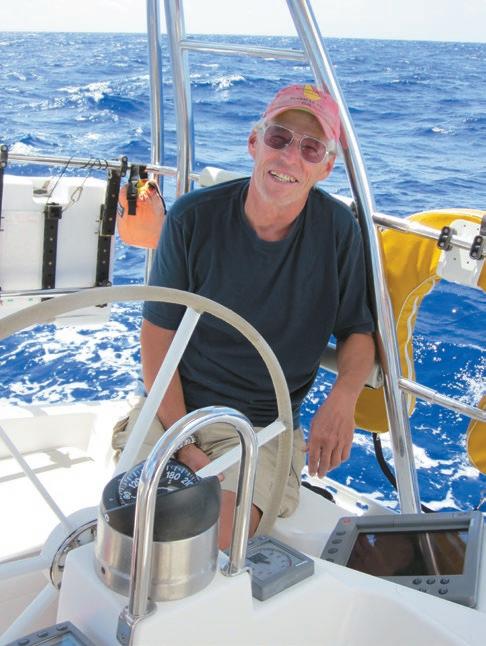
Whether refining his Crocodile Dundee image in the outback of Australia, reeling in a gigantic mahi-mahi in the middle of the Gulf Stream, or installing the latest must-have gadget on his boat, Rick attacked each new venture with gusto, dedicated to expanding the “bandwidth of his brain,” as he would often say.


On land, Rick developed his skills as a woodturner and woodworker. He taught woodturning at The Woodturning School in Damariscotta, Maine, and served on the board of The Apprenticeship, a boat-building school in Rockland, Maine. On his lathe, he created works of art ranging from pepper mills and
bowls to platters and Christmas tree ornaments. He and Julie built furniture each winter, starting with Craftsman designs for their home in Maine and evolving to more modern pieces for their home in Virginia. Isolation during the pandemic was no problem .... Just an opportunity to build a Peapod rowing boat in the shop.
He frequently said that he was “working to live” rather than “living to work,” but that being said, he enjoyed a long and successful career in sales and marketing management for several health care companies. When he and Julie took a “mid-career sabbatical” to circumnavigate in 1990-1992, Rick discovered that managing a sailboat around the world was excellent training for starting his own business. So when they returned, he started a business assembling computer cables in the Boston area. He earned his private pilot’s license and flew up and down the East Coast, servicing customers from Alabama to New England. He sold the company in 2002.

Dedication to family was a dominant part of Rick’s life. While his parents died before he was in his 30s and he was an only child, he adopted Julie’s family quickly, enjoying sailing trips with her father and raising Julie’s son Ted as his own. Nothing pleased him more than watching his two grandsons Owen and Eli mature into young adults. Rick tried valiantly to encourage Ted, Ted’s wife Rebecca, Owen and Eli to share his passion for sailing. Only Eli seems to have taken the bait; he has enjoyed many junior week adventures at the Fishing Bay Yacht Club in Deltaville, Virginia. The Virgin Islands, both British and American, were special family cruising grounds on vacations none will ever forget. Recently, when asked how he would like to be remembered, Rick was clear ... he wanted to be remembered as a part of the intimate relationship he and Julie forged together in their 40-year marriage. Whether as a duo sailing across oceans, as four hands working in concert on a furniture-building project, or, in the end, as focused problem-solvers facing the challenges of his advancing cancer, they learned to complement each other’s very contrasting styles. “If there are two ways to do something, Julie will do it one way and I’ll do it the other,” he would often say, and then add “and over time, we learned that the give-and-take result was better than either of the ways we each started with.”
In the seven years since Rick was diagnosed with cancer, he became a “poster boy” for how to live with cancer as a chronic disease. Nothing stopped him from participating in family events, designing creative shop projects, or going places on the water. He learned from the many medical professionals who teamed up to add quality years to his life and was probably the most compliant patient they ever had. Hoping to advance treatments for future cancer patients, he participated in a clinical trial for a new immunotherapy drug after the FDAapproved options available to him had been exhausted. In the end, he made the decision to stop treatment and enter hospice care on his own timetable.
To those wishing to acknowledge Rick’s life, please consider contributing a donation in his name to the Chesapeake Bay Foundation (www.cbf.org).
APRIL 20 23 CARIBBEAN COMPASS PAGE 36 EIGHT BELLS
Caribbean Compass Market Place
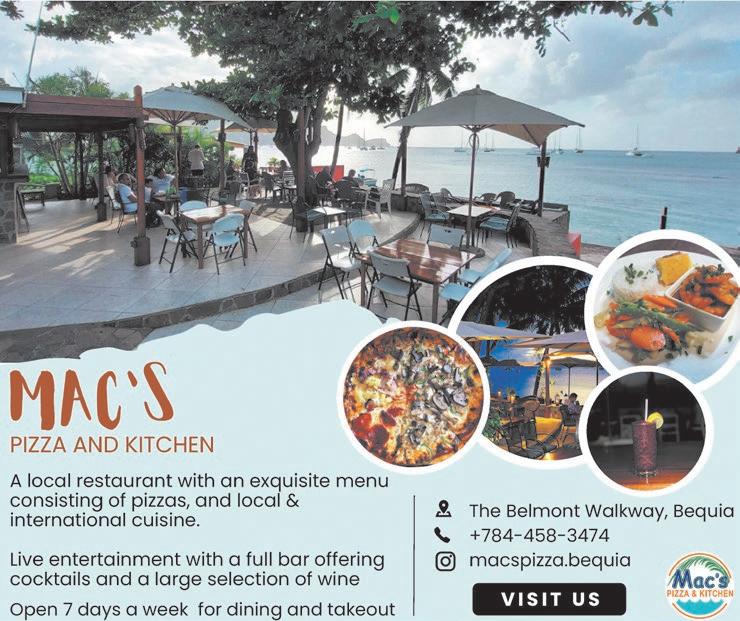
Antigua

Saint Kitts & Nevis SVG
Azores
MID ATLANTIC YACHT SERVICES
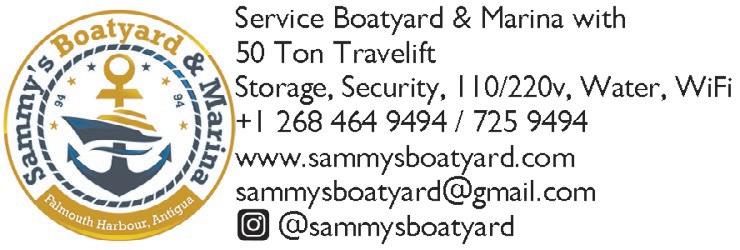
PT-9900-144 HORTA / FAIAL, AZORES
Providing all vital services to Trans-Atlantic Yachts!
Incl. Chandlery, Charts, Pilots, Rigging EU-VAT (18%) importation
Duty free fuel (+10.000lt)
TEL +351 292 391616 FAX +351 292 391656 mays@mail.telepac.pt
www.midatlanticyachtservices.com
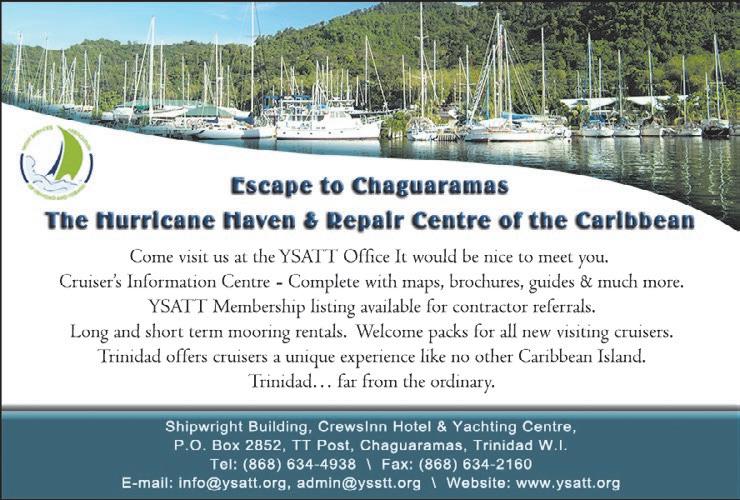
Grenada
SVG
WE OFFER:

• Grocery Shopping / Personal pick-up (with delivery to your dock)
• Argyle International Airport direct shuttle (starting from EC$30)

• Bill payments
LAC Services App (Google App Store)
Tel: (784) 527-3082, (784) 492-9983
E-mail: lacservices@lacsvg.com
NEILPRYDE Sails Grenada
Check out our website or contact us directly for a competitive quote on rugged and well-built sails that are well suited to the harsh environment of the charter trade and blue water cruising.
Jeff Fisher – Grenada (473) 407 6355
www.neilprydesails.com


GRENADINES SAILS & CANVAS • BEQUIA •
NEW SAILS, SAIL REPAIRS, U/V COVERS FOAM LUFFS, BIMINI, DODGERS AWNINGS, DINGHY COVERS, UPHOLSTERY TRAMPOLINES, STACKPACKS & LAZY JACK SYSTEMS
BEST CUSTOM-MADE DINGHY CHAPS
Located northern side of Admiralty Bay Tel (784) 457-3507 / 457-3527 (evenings)


gsailsbequia@gmail.com
VHF Ch16/68
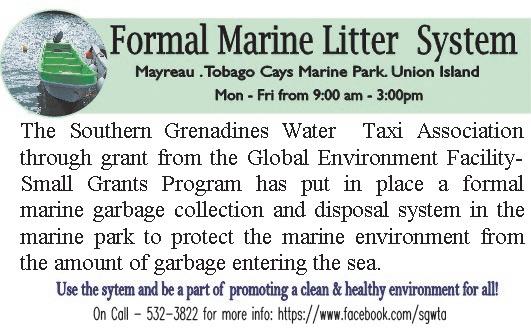
Trinidad
APRIL 20 23 CARIBBEAN COMPASS PAGE 37
page
continued on next
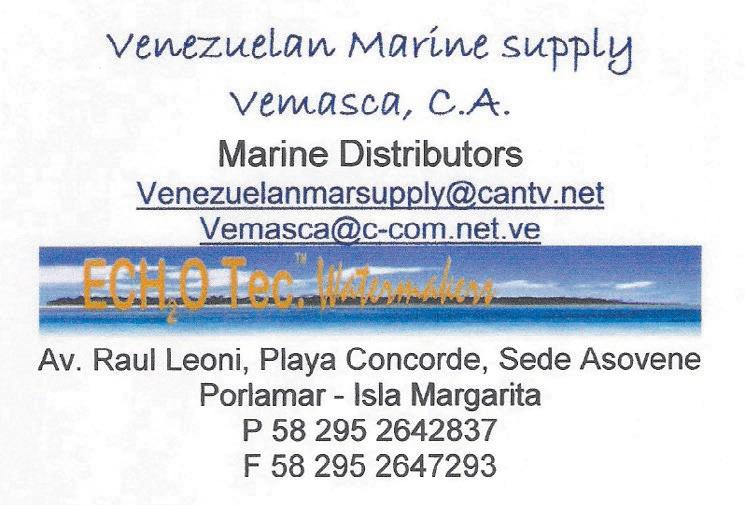
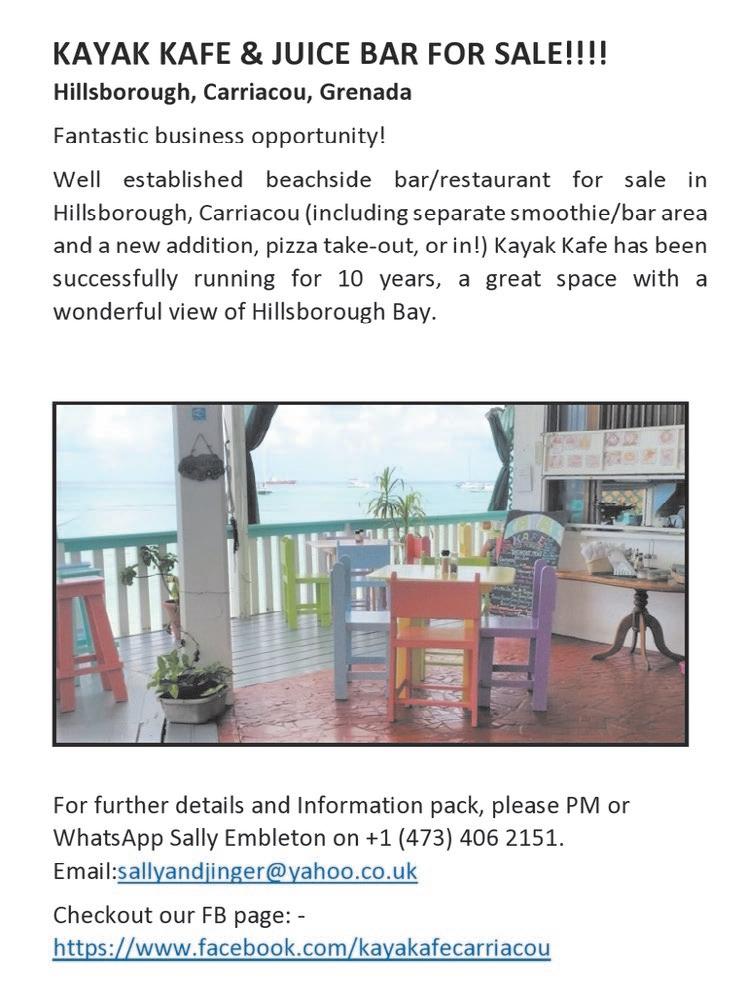








APRIL 20 23 CARIBBEAN COMPASS PAGE 38 Real Estate Market Place Cont. Venezuela LIVE THE DREAM FOR SALE OURCARRIACOU.COM/WOW CARRIACOU REAL ESTATE Land and houses for sale For full details see our website: www.carriacou.net Contact: islander@spiceisle.com Tel: (473) 443 8187 Click here to read a sample or to order: https://amzn.to/2ZaLfzw Caribbean-wide HEY, READERS! Visit our website at caribbeancompass.com or just scan the QR code BELOW and enter your email address — it’s as easy as that! Trinidad
BEQUIA, LAWLER HILL Over 2 acres of mature grounds with fabulous views overlooking Port Elizabeth, Lower Bay, Friendship Bay and Mustique. Property includes a charming home plus a cottage hideaway. Could be sold separately or together. Price negotiable. Contact T. M. Zoffoli, Tel: (774) 563-0240 E-mail: austintiare860@gmail.com
BEQUIA - ISLAND PACE REAL
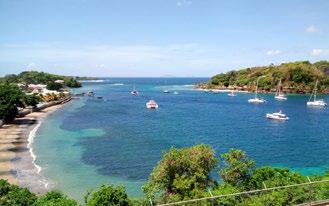
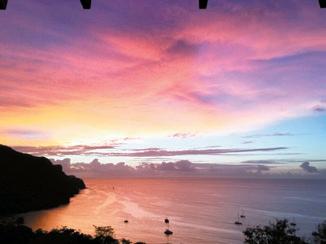





ESTATE 43,560 sq/ft + acre lots, Ocean Ridge estates, North Bequia. US$100,000 & up, US$2.50/ sq/ft & up. Tel: (784) 493-4711 E-mail: emmett@islandpace.com
ST. VINCENT & THE GRENADINES, VILLA BEACH Beach front living for home or an investment. 3 separate self-contained units. 7 bedrooms, 7 en-suite bathrooms, 3 half bathrooms. Building 6,864 sq/ft & land 13,490 sq/ft., views of the Grenadines. US $1,100,000
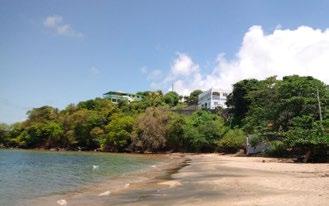
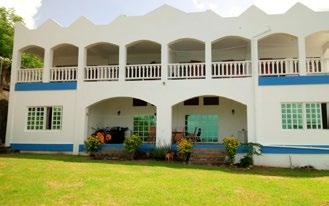
OBO. Tel: (784) 497-0000 / 593-9922 E-mail: properties.svg@gmail.com
Website: islandpropertiessvg.com

EMAIL!
APRIL 20 23 CARIBBEAN COMPASS PAGE 39 ADVERTISER LOCATION PG# ADVERTISER LOCATION PG# ADVERTISER LOCATION PG# ADVERTISER LOCATION PG# Art Fabrik Grenada MP Bequia ThreadWorks SVG MP Blue Lagoon Hotel & Marina SVG 6 Boat Paint & Composites St. Martin 21 Budget Marine St. Maarten 2 Budget Marine St. Kitts St. Kitts MP Carriacou Business Grenada MP Centenario & Co Panama 25 Clarkes Court Grenada 17 Club De Pesca Marina Colombia 25 Douglas Yacht Services Martinique 11 Down Island Real Estate Grenada MP Doyle Offshore Sails Barbados 9 Doyle's Guides USA 21 Gonsalves Liquors SVG 36 Grenada Marine Grenada 35 Grenadines Sails SVG MP Happy Kite SVG MP Hutch's E-book C/W 38 Hydrovane International Marine C/W MP Island Water World Sint Maarten 40 Kayak Café & Juice Bar Grenada 38 LAC Services SVG MP Mac's Pizzeria SVG MP Marina Santa Marta Colombia 4 Martinique Boat Show Martinique 7 McIntyre Bros Grenada 31 Mid Atlantic Yacht Services Azores MP Ministry of Trade & Industry Trinidad 19 Neil Pryde Sails Grenada MP Off Shore Risk Management Tortola 22 Offshore Passage Opportunities C/W 31 Peake Yacht Services Trinidad 14 Power Boats Trinidad 28/MP Rodney Bay Marina/ IGY St. Lucia 23 Sammy's Boatyard Antigua MP Tobago Cays SVG MP Turbulence Sails Grenada 22/MP Venezuelan Marine Supply Venezuela MP Westerhall Rum Grenada 36 WhitCo Insurance USA 9 YSATT Trinidad MP ADVERTISERS INDEX MP = Market Place pages 37 - 38 C/W = Caribbean-wide DON‘T LEAVE PORT WITHOUT IT CLASSIFIEDS CLASSIFIEDS US 50¢ PER WORD Include name, address and numbers in count. Line drawings/photos accompanying classifieds are US$10. Pre-paid by the 10th of the month: E-mail: shellese@caribbeancompass.com HEY READERS, GET CARIBBEAN COMPASS BY
Visit our website at caribbeancompass.com or just scan the QR code BELOW and enter your email address — it’s as easy as that! PROPERTY FOR SALE
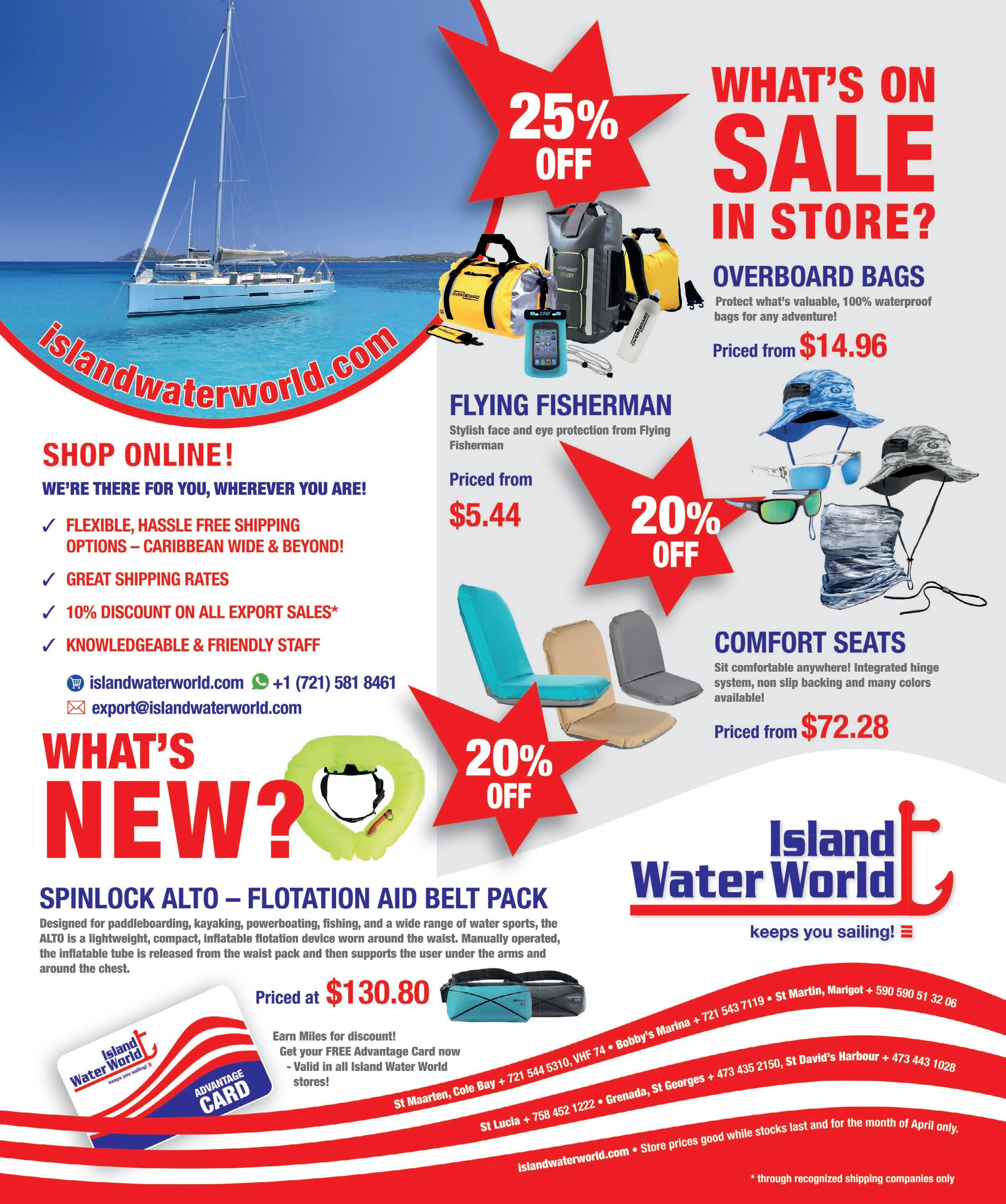
Published by Compass Publishing LLC, Connecticut, USA, and printed by Guardian Media Limited, Trinidad & Tobago































































 by Emma Doyle
by Emma Doyle



 Story and Photos by David H. Lyman
Story and Photos by David H. Lyman





















 Story by Todd Duff, Photos by Gayle Suhich
Story by Todd Duff, Photos by Gayle Suhich








































 Story and Photos by Christine Gooch
Story and Photos by Christine Gooch


































